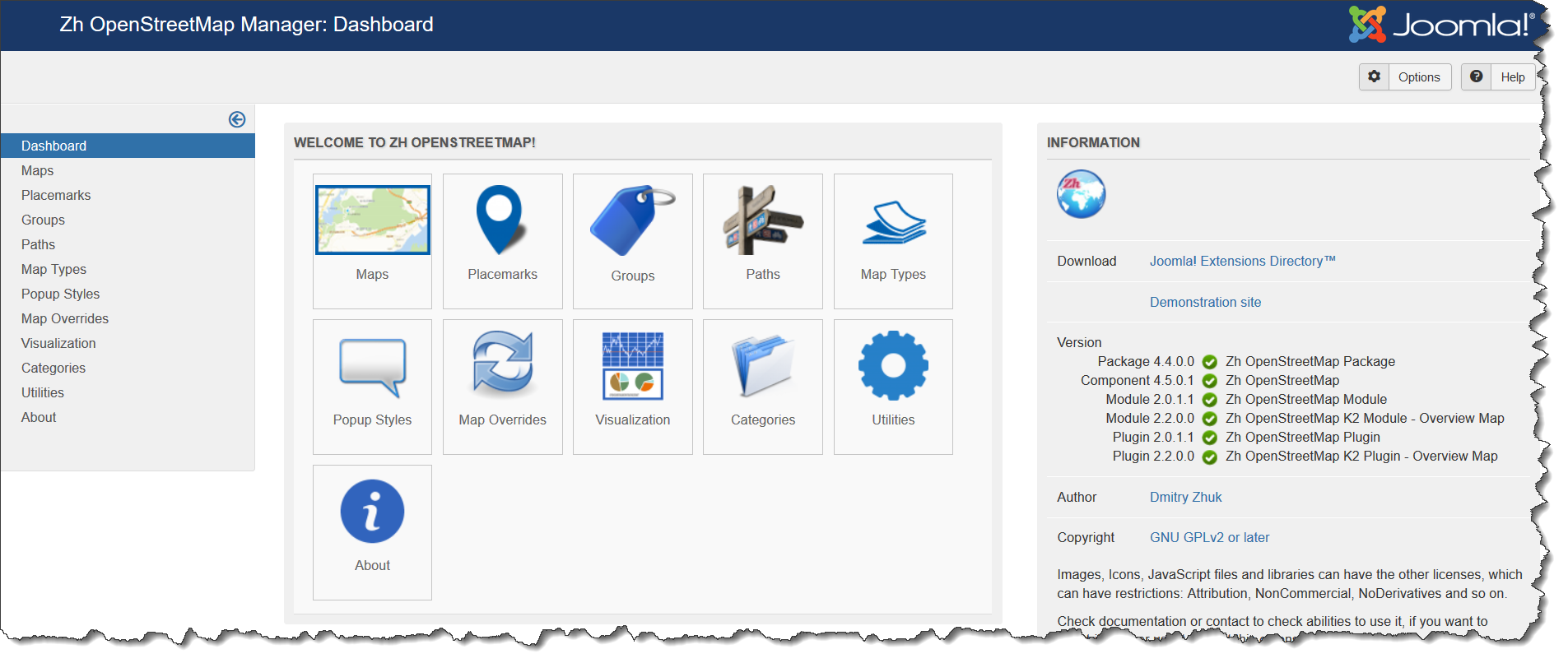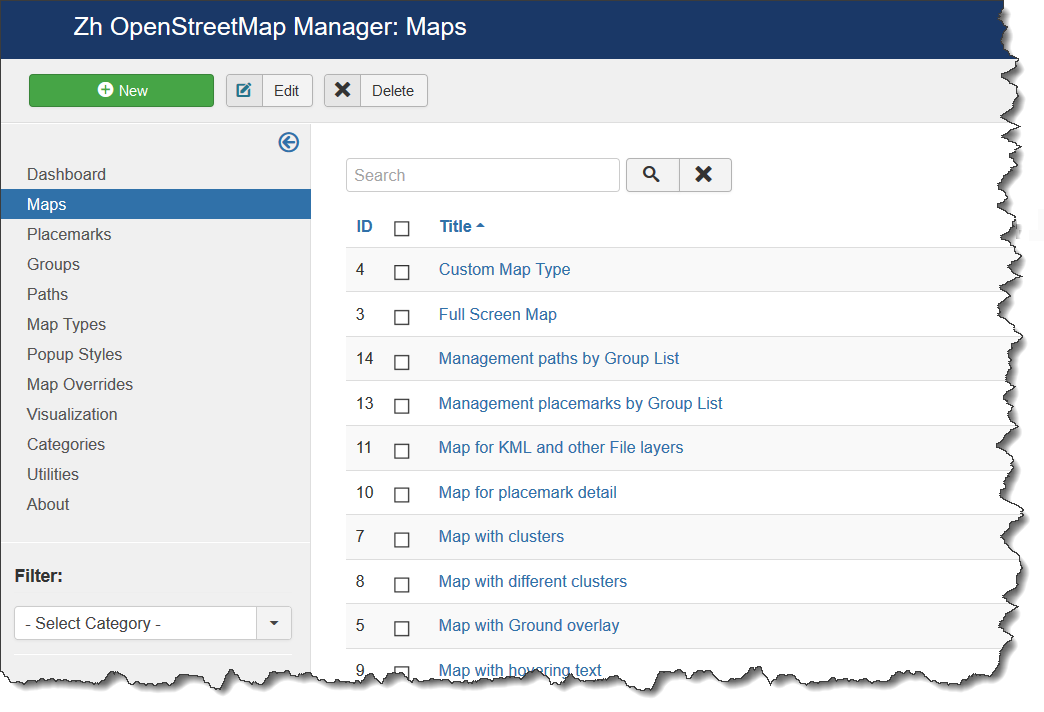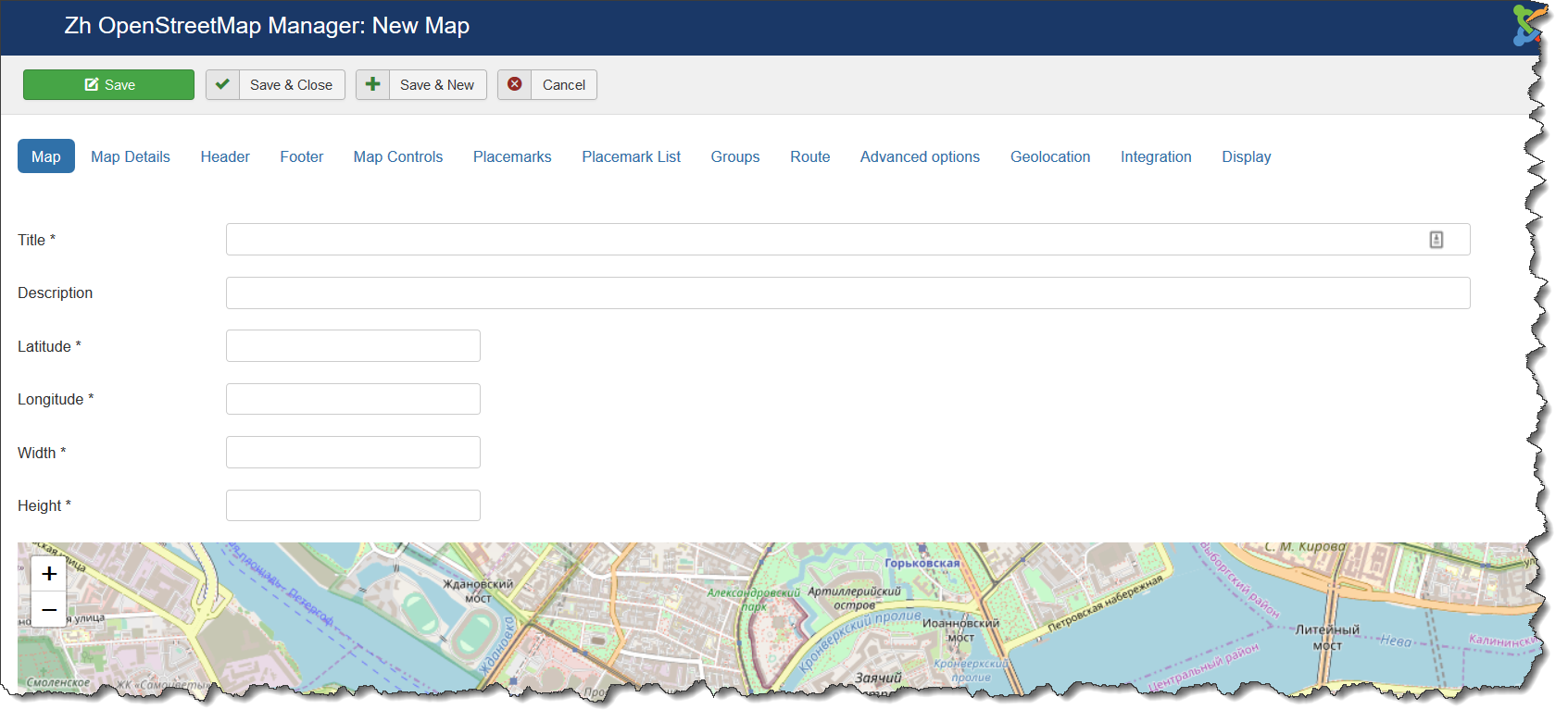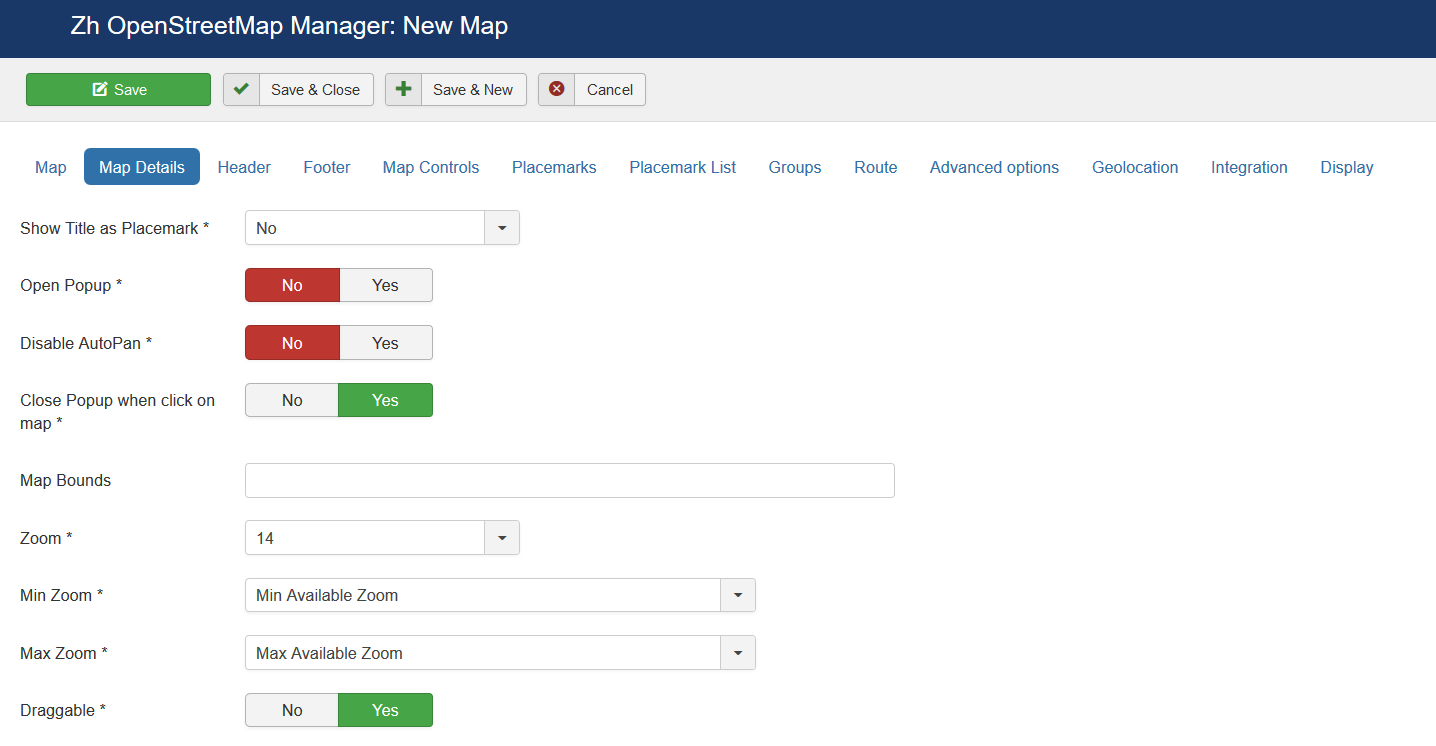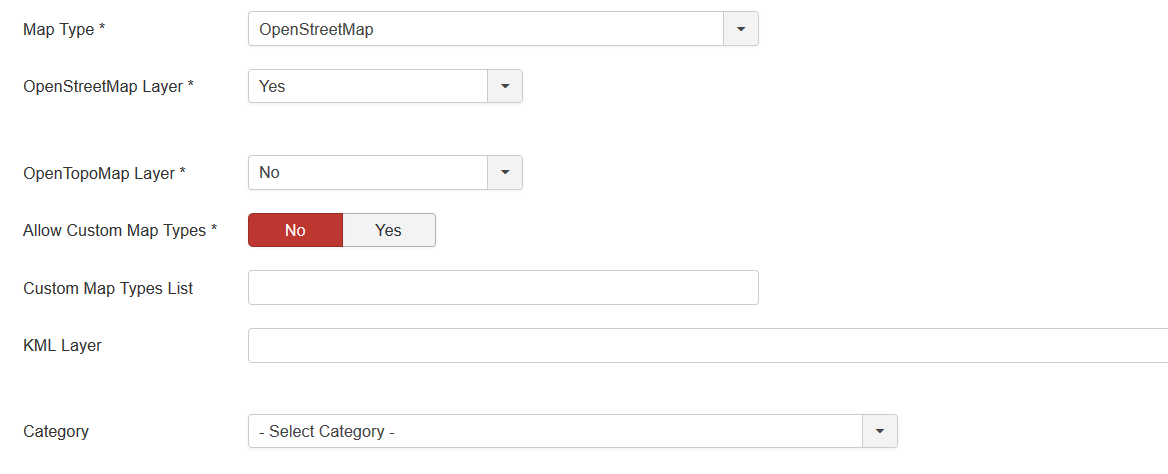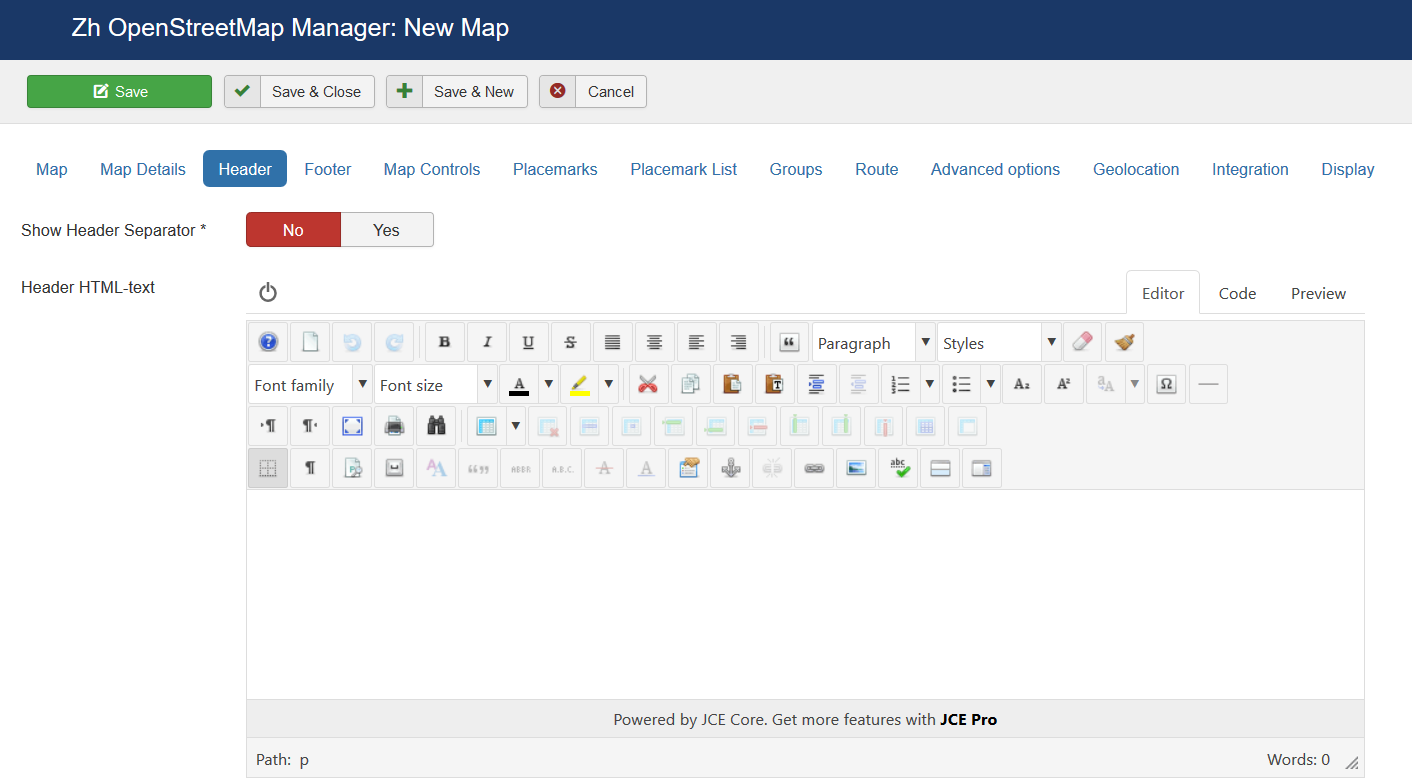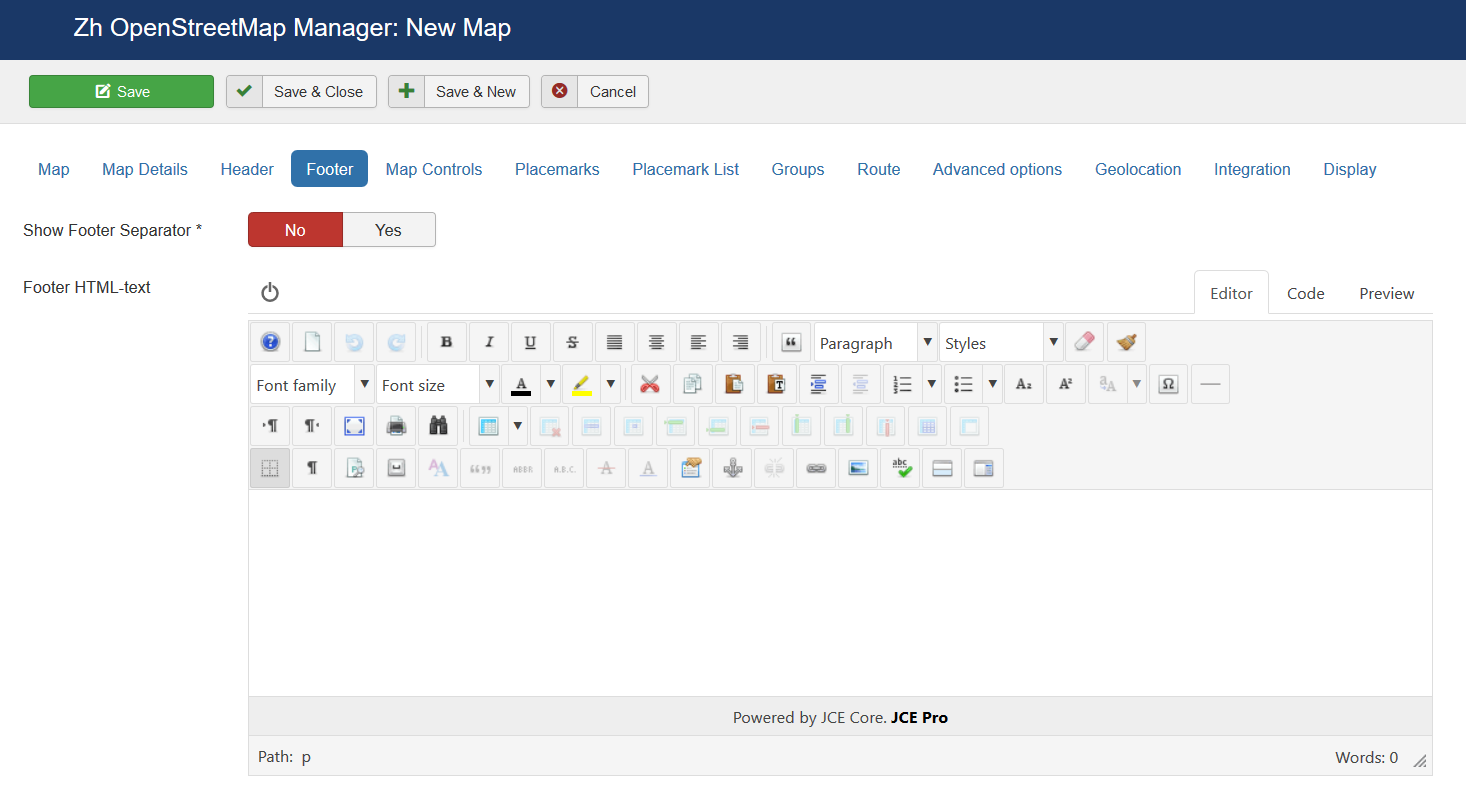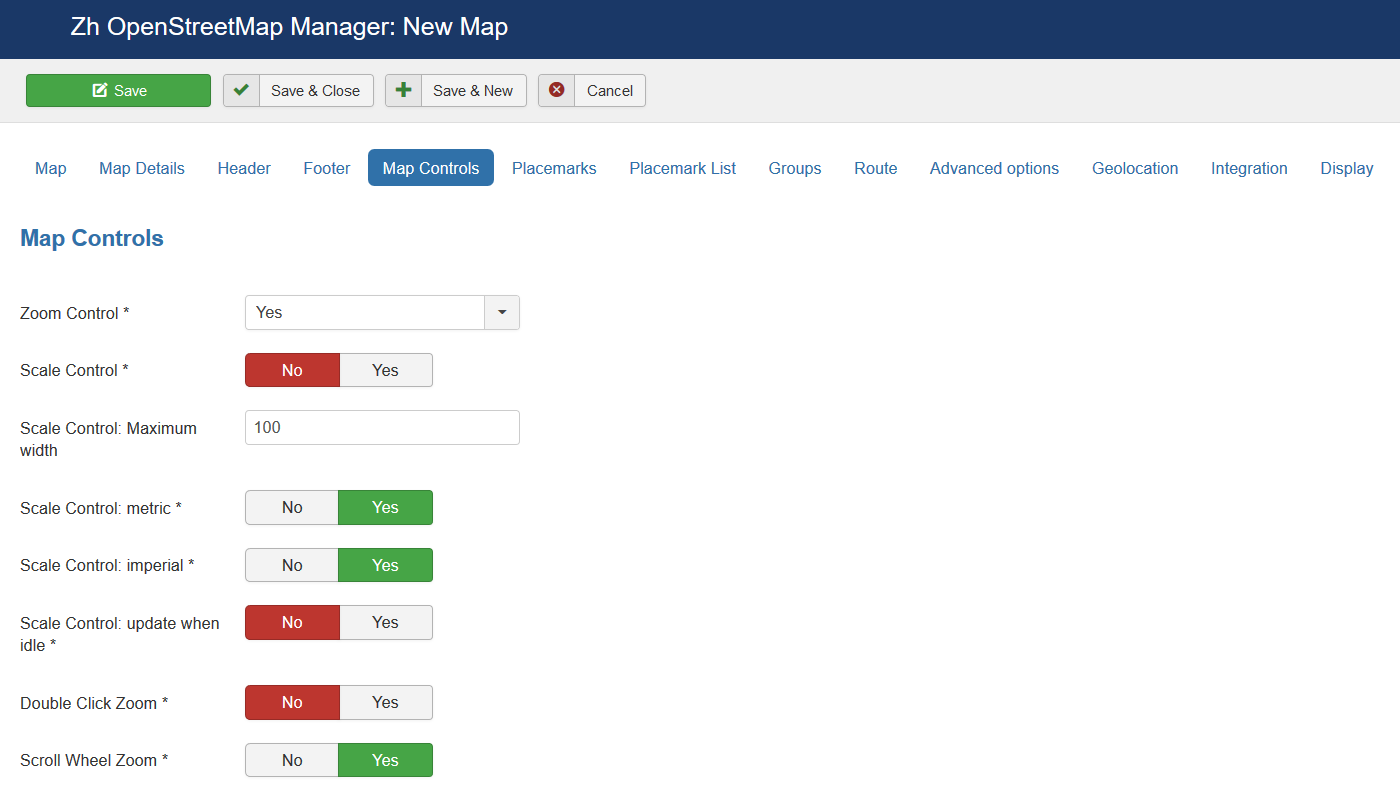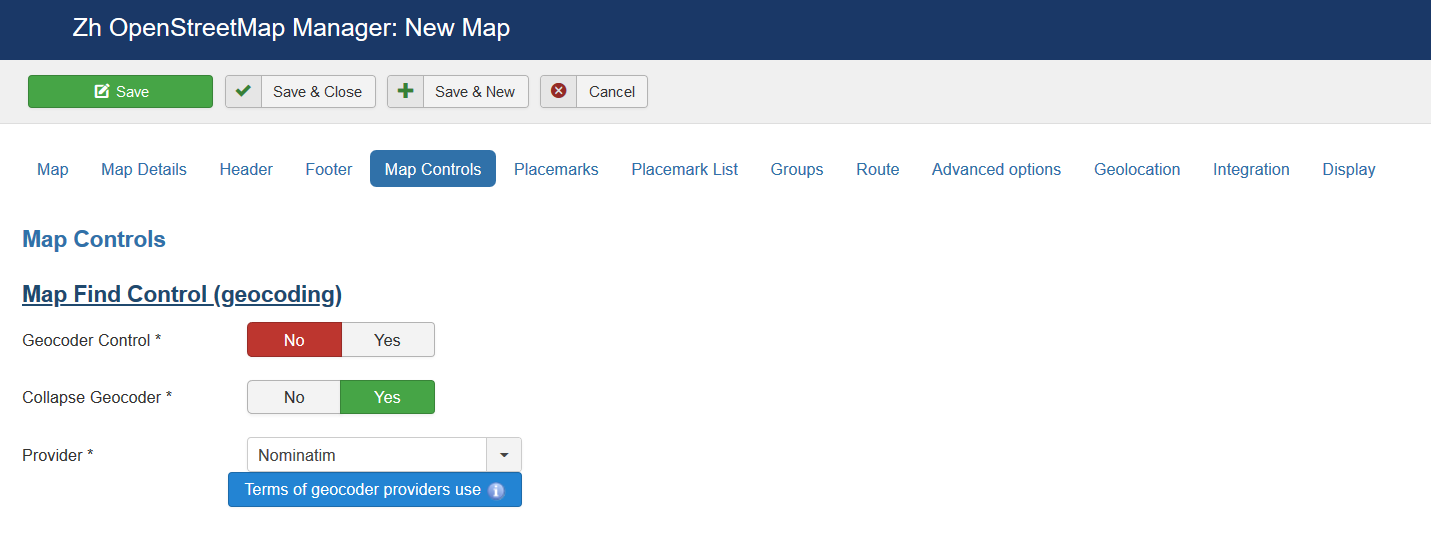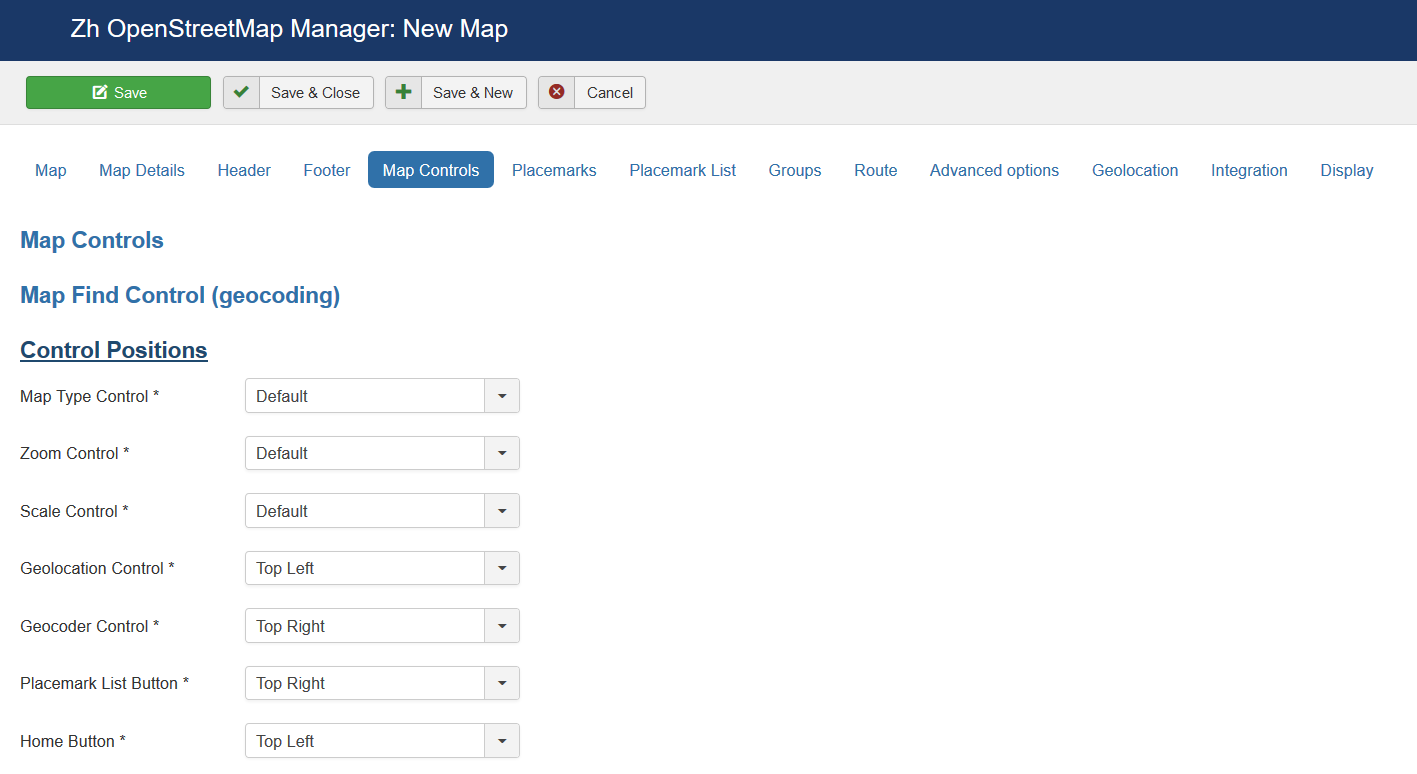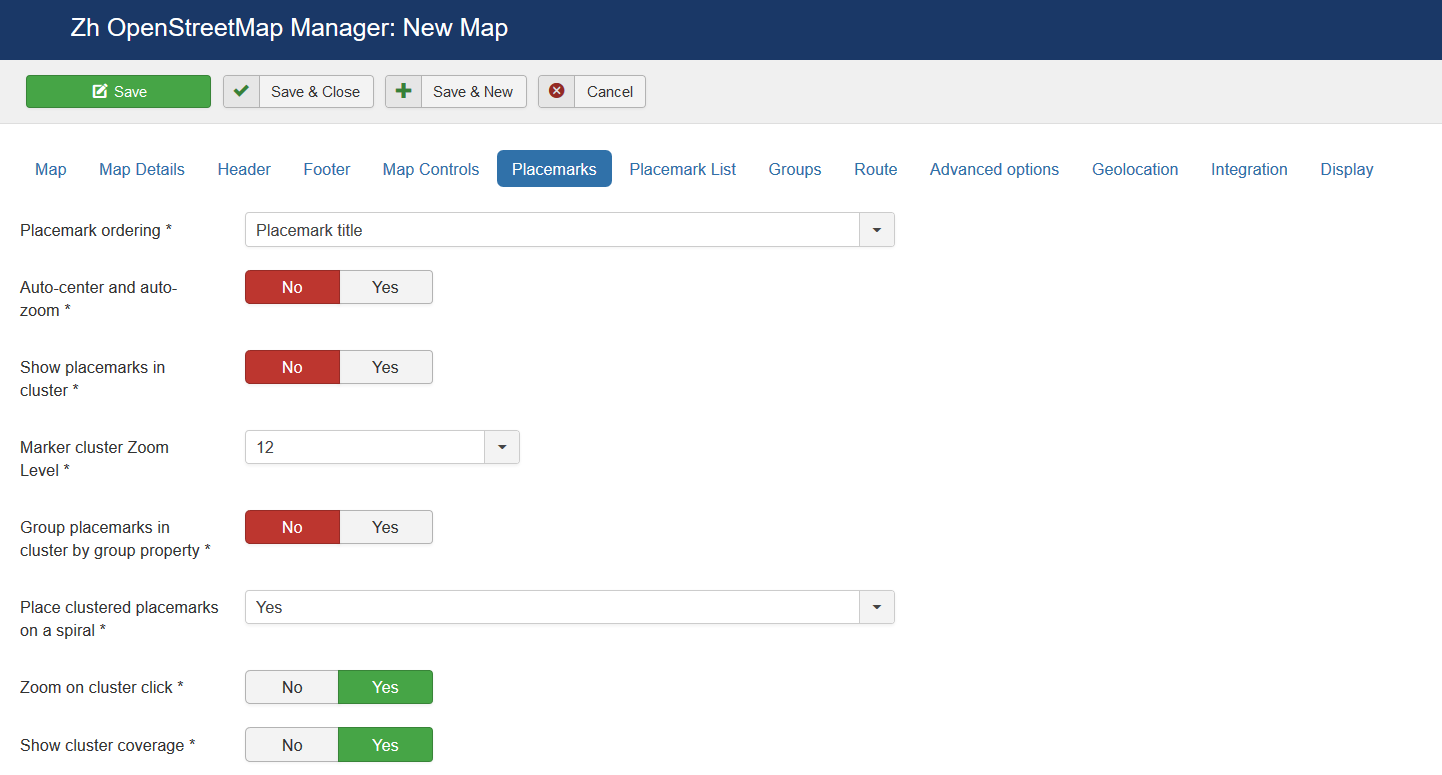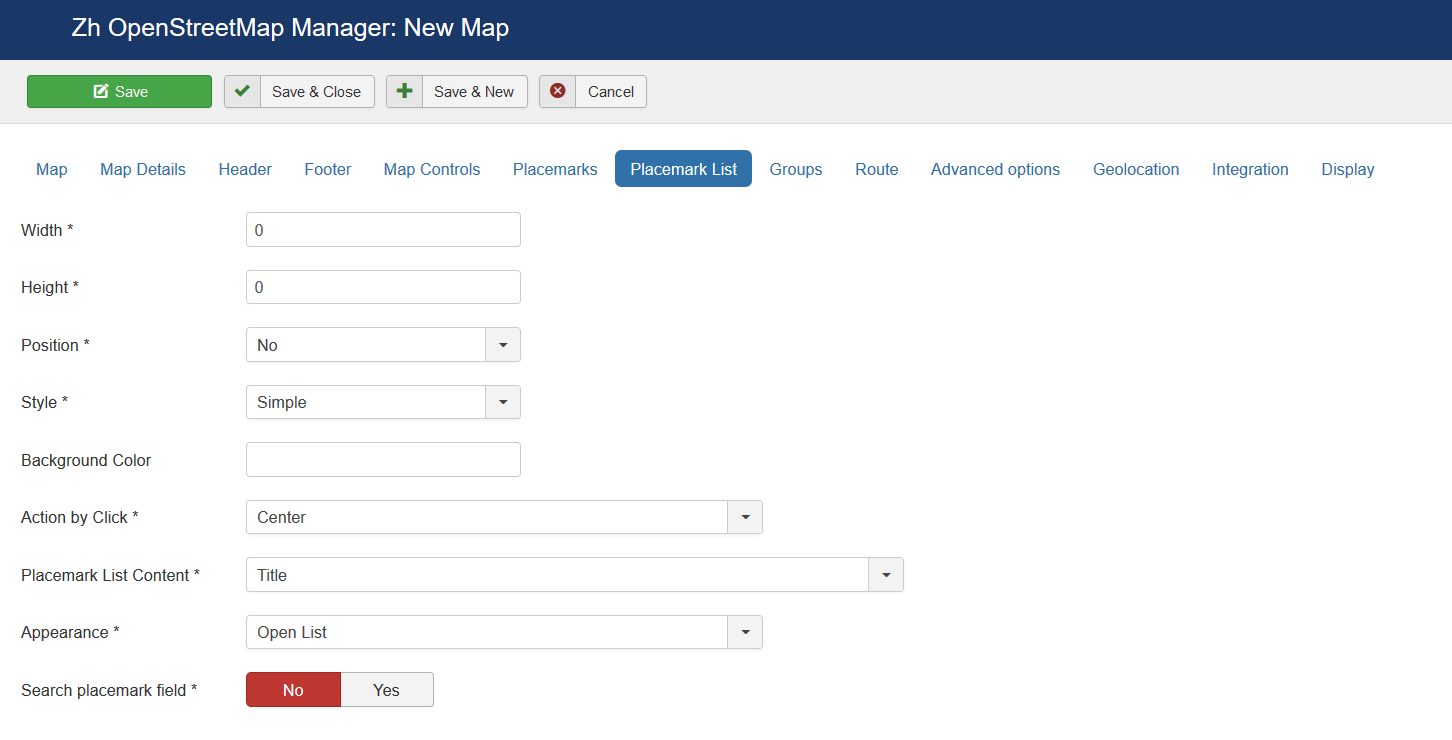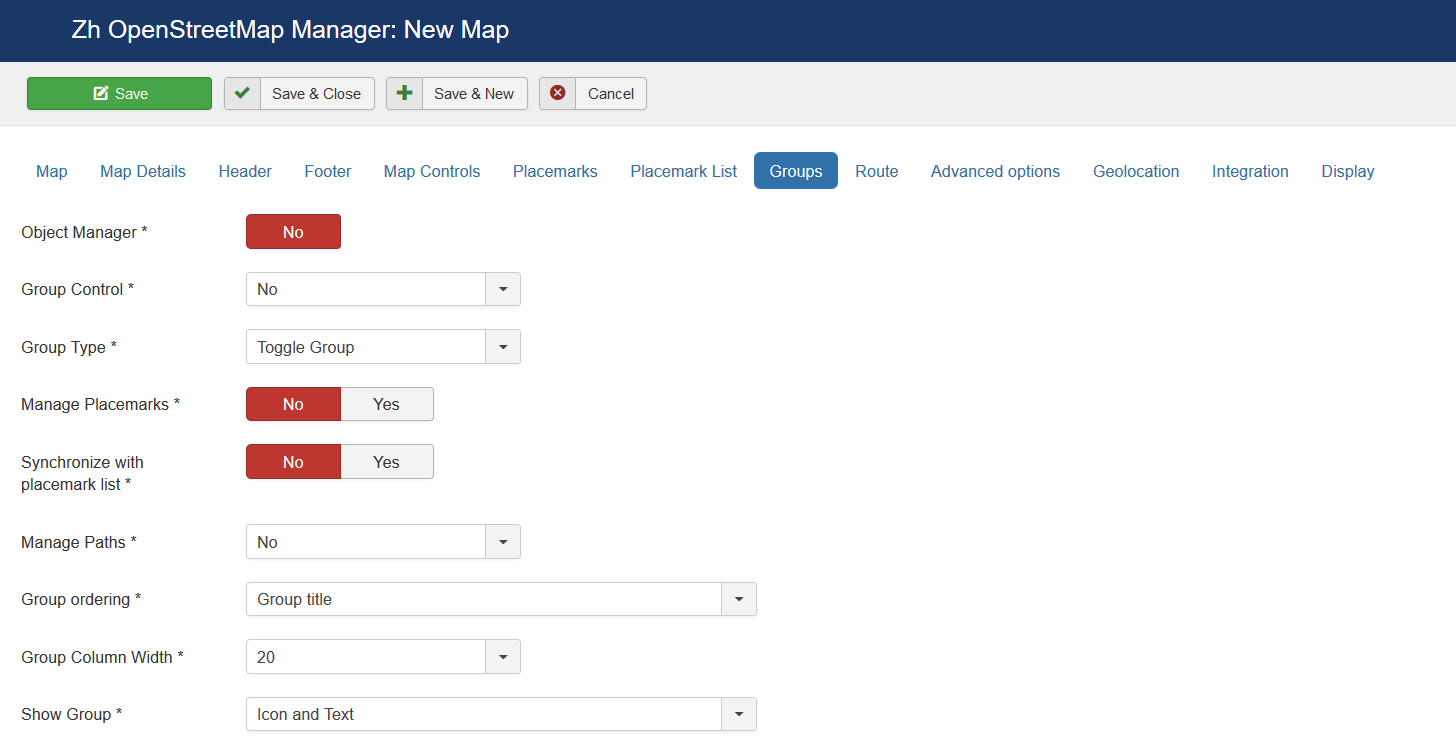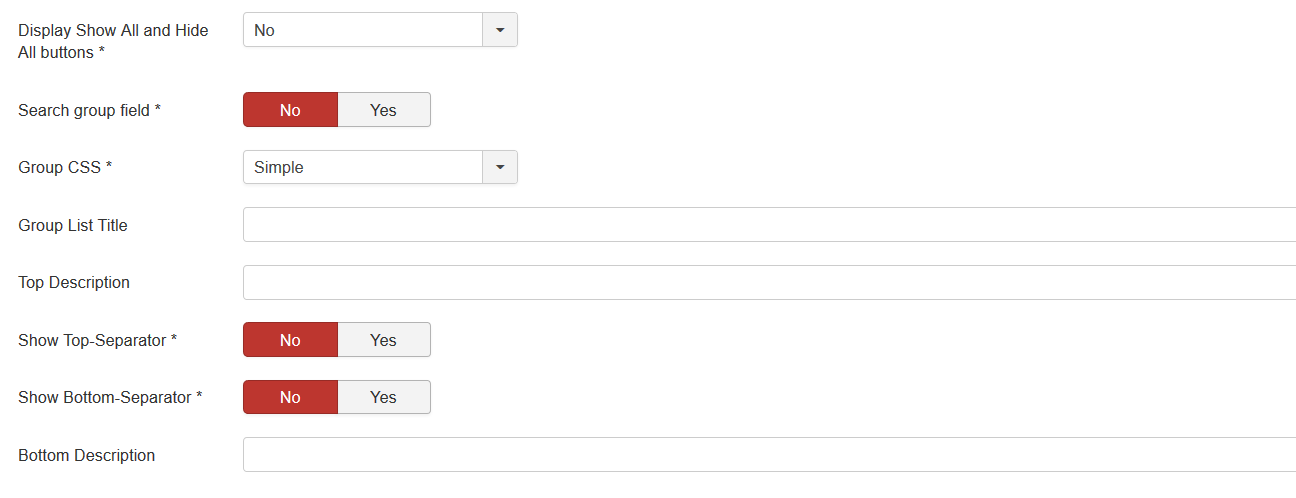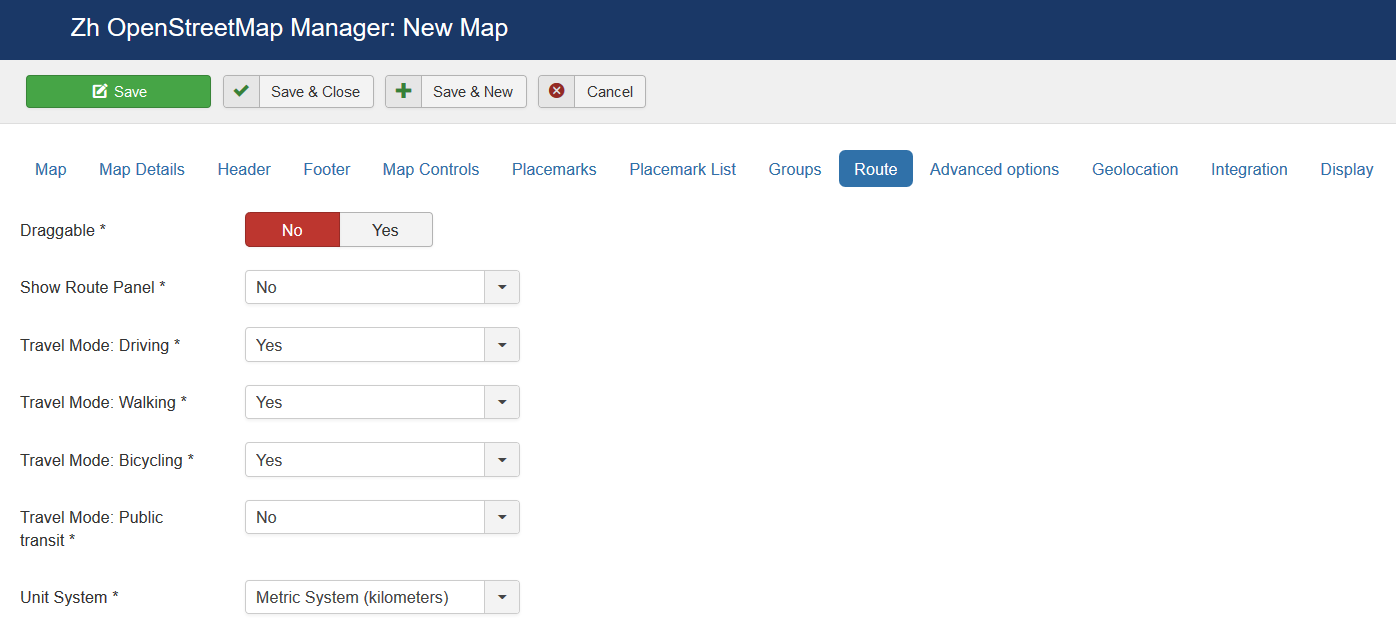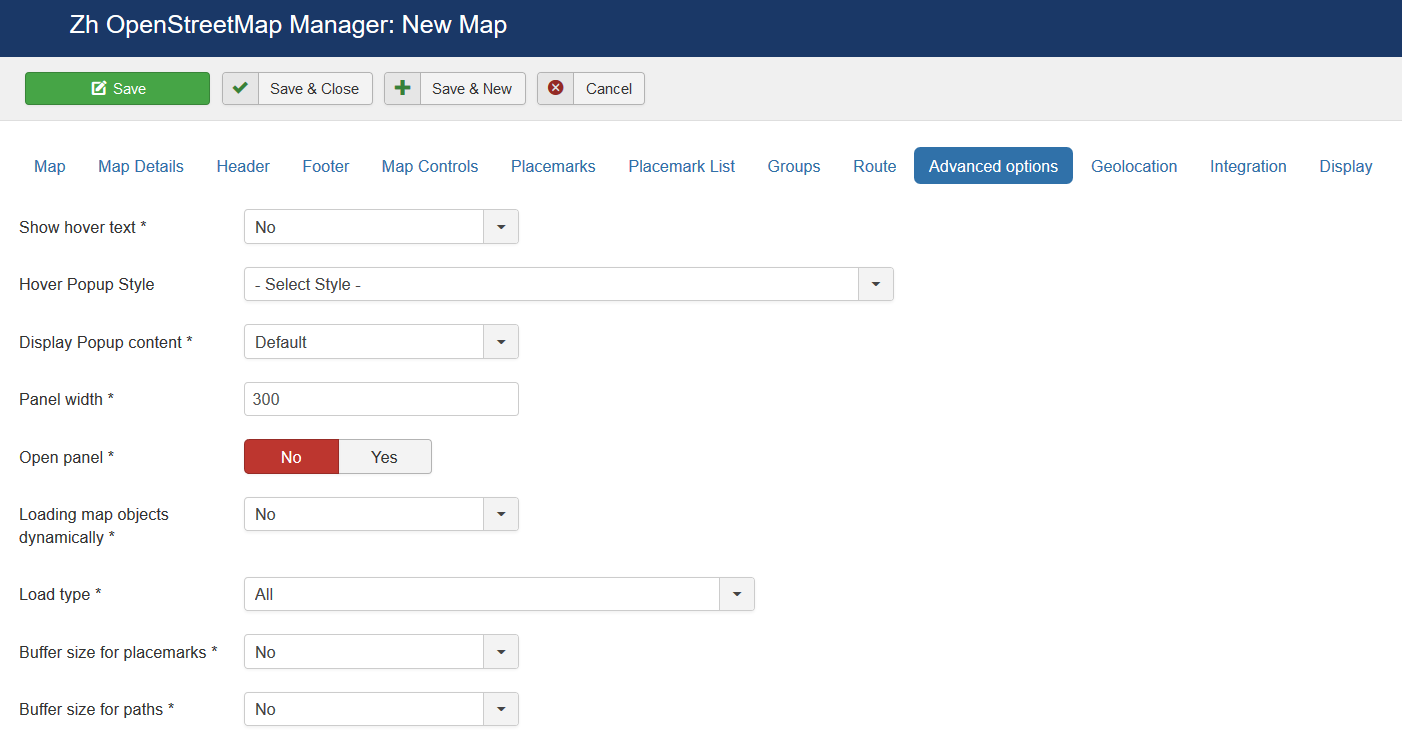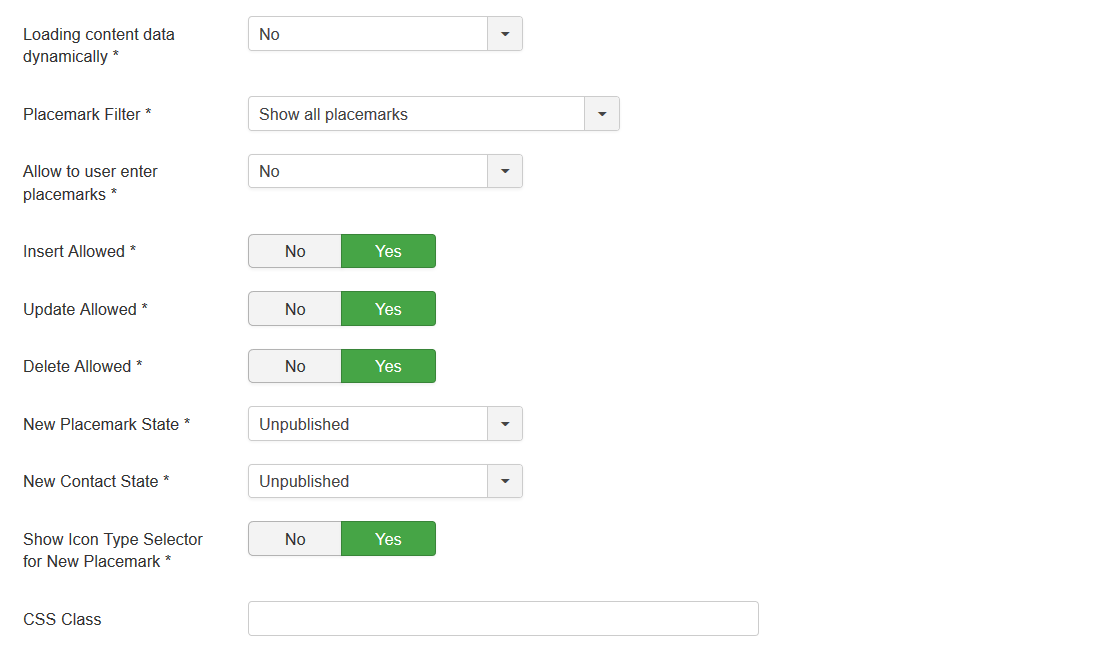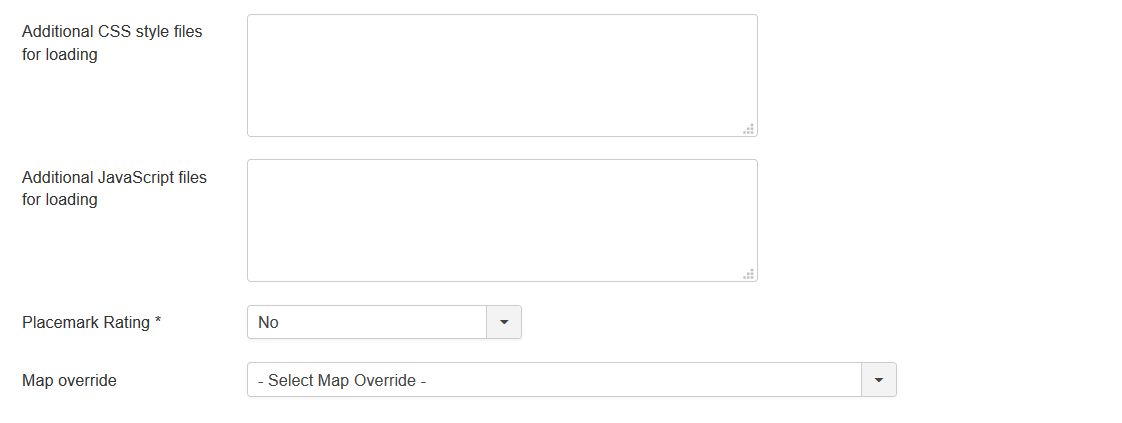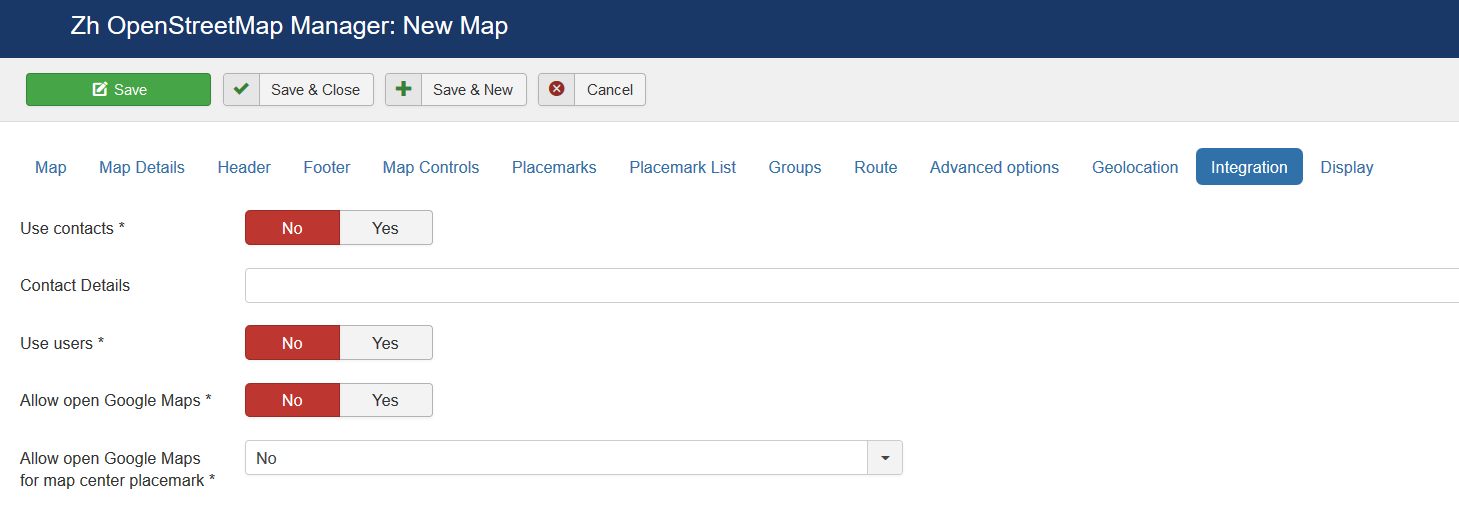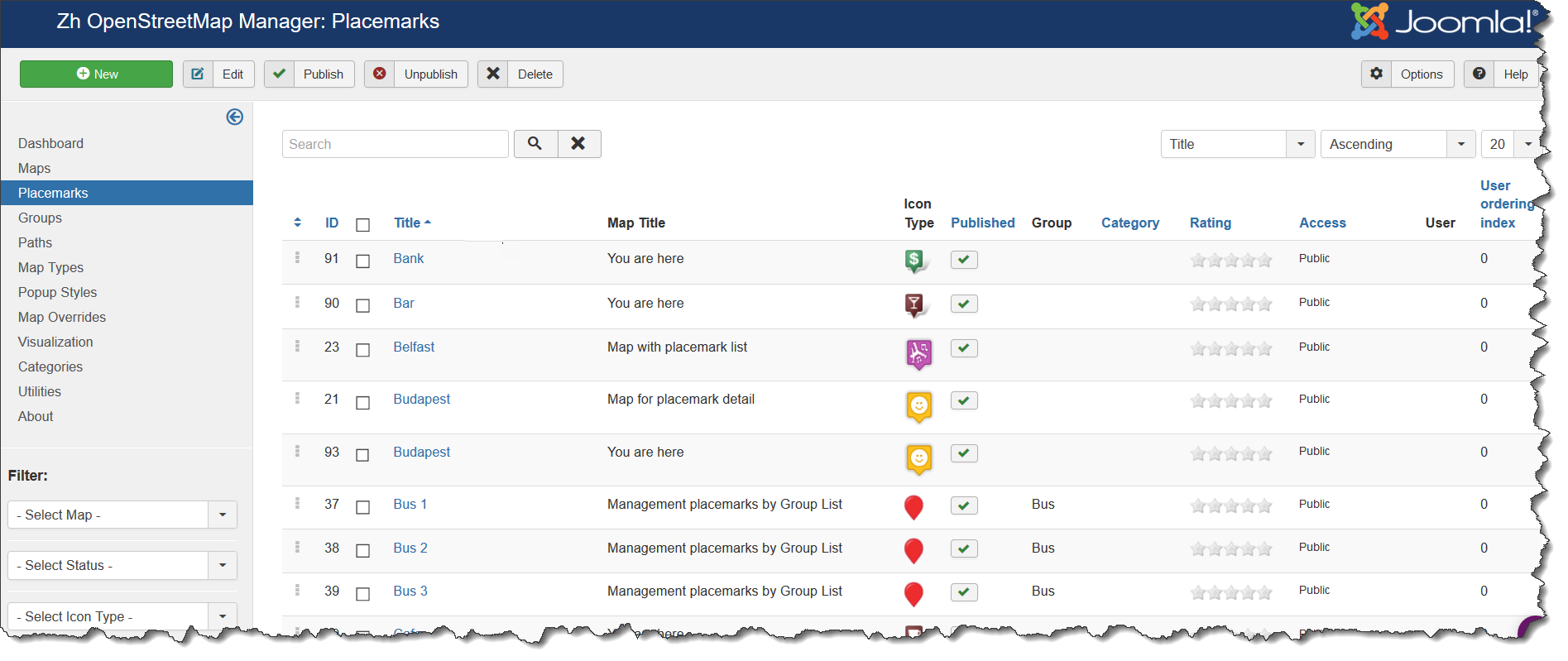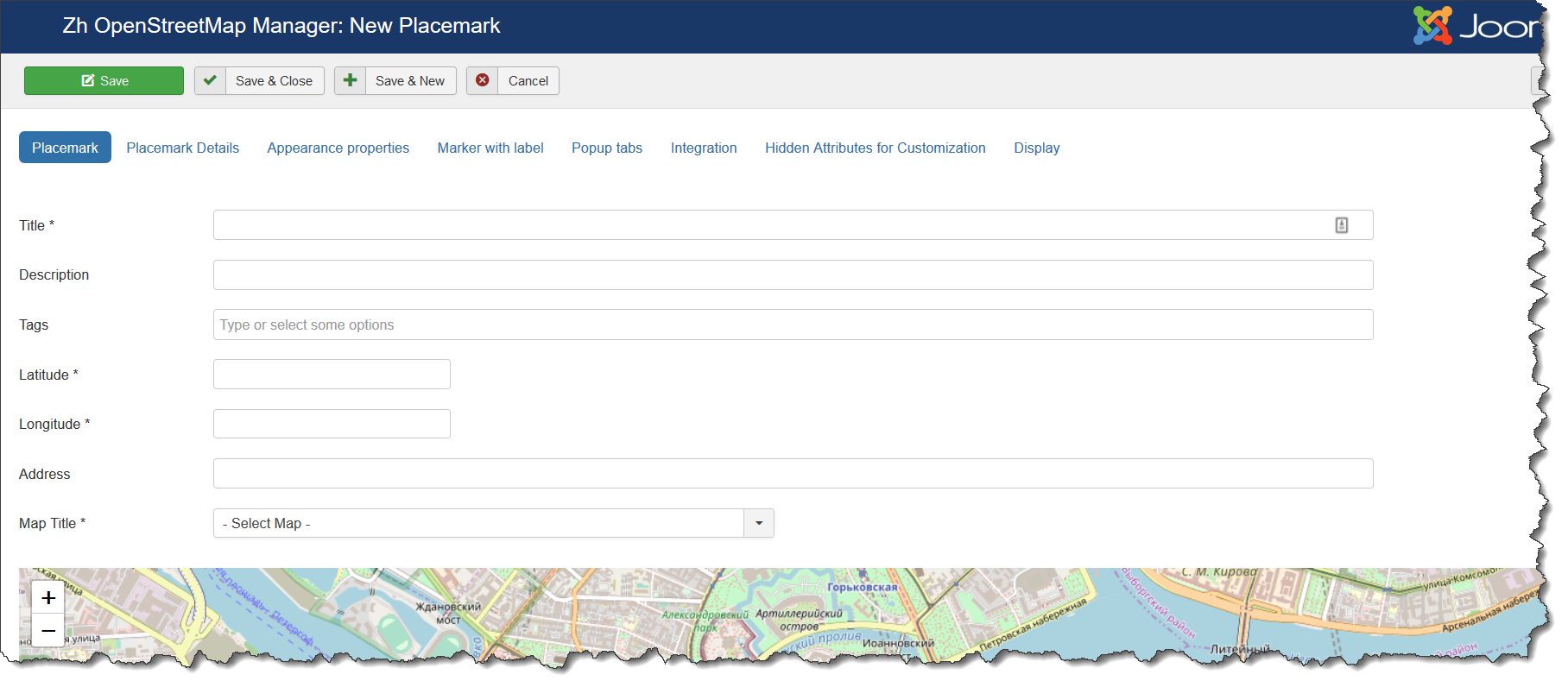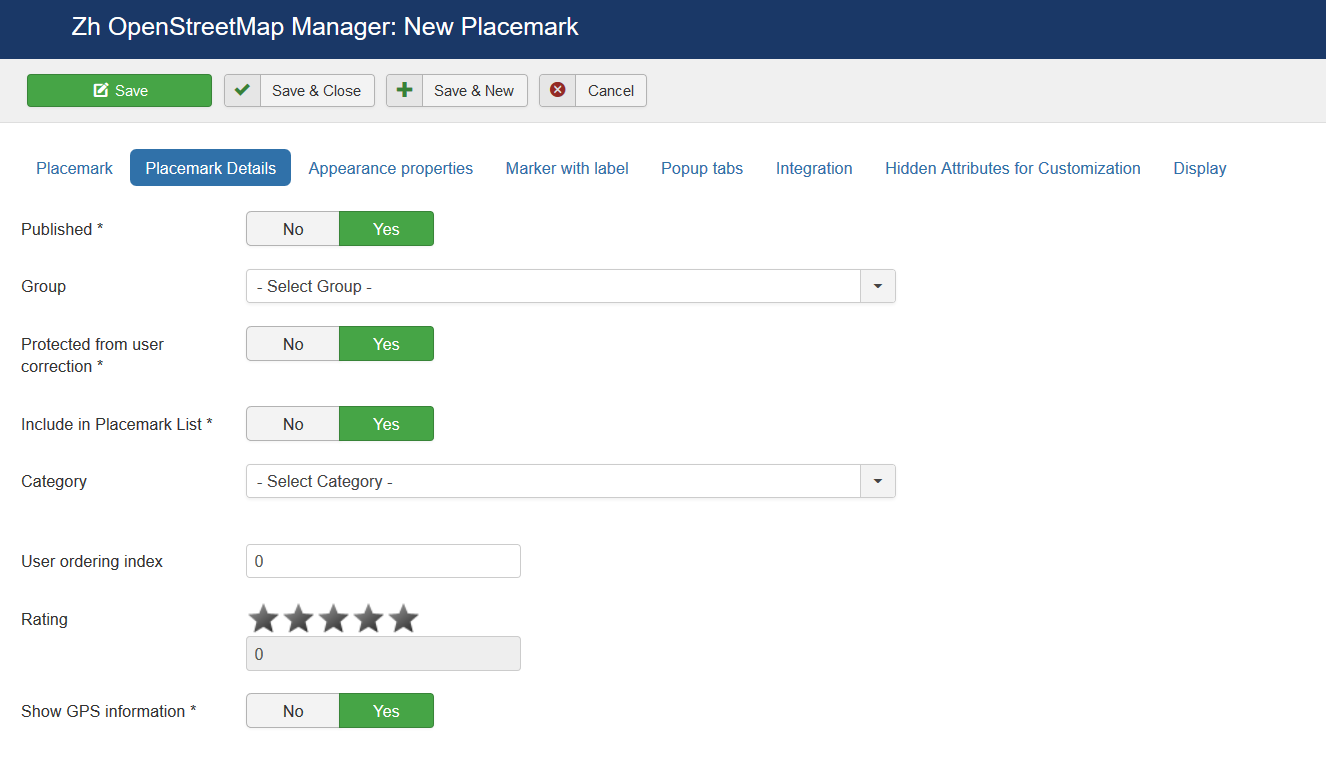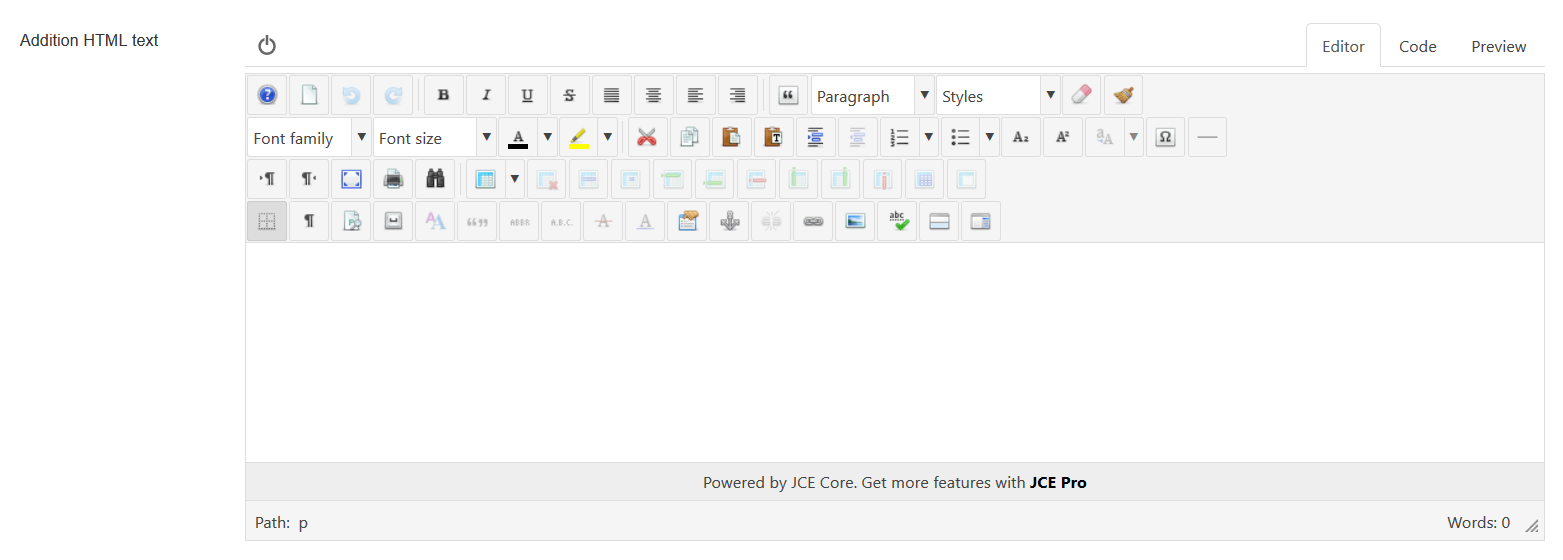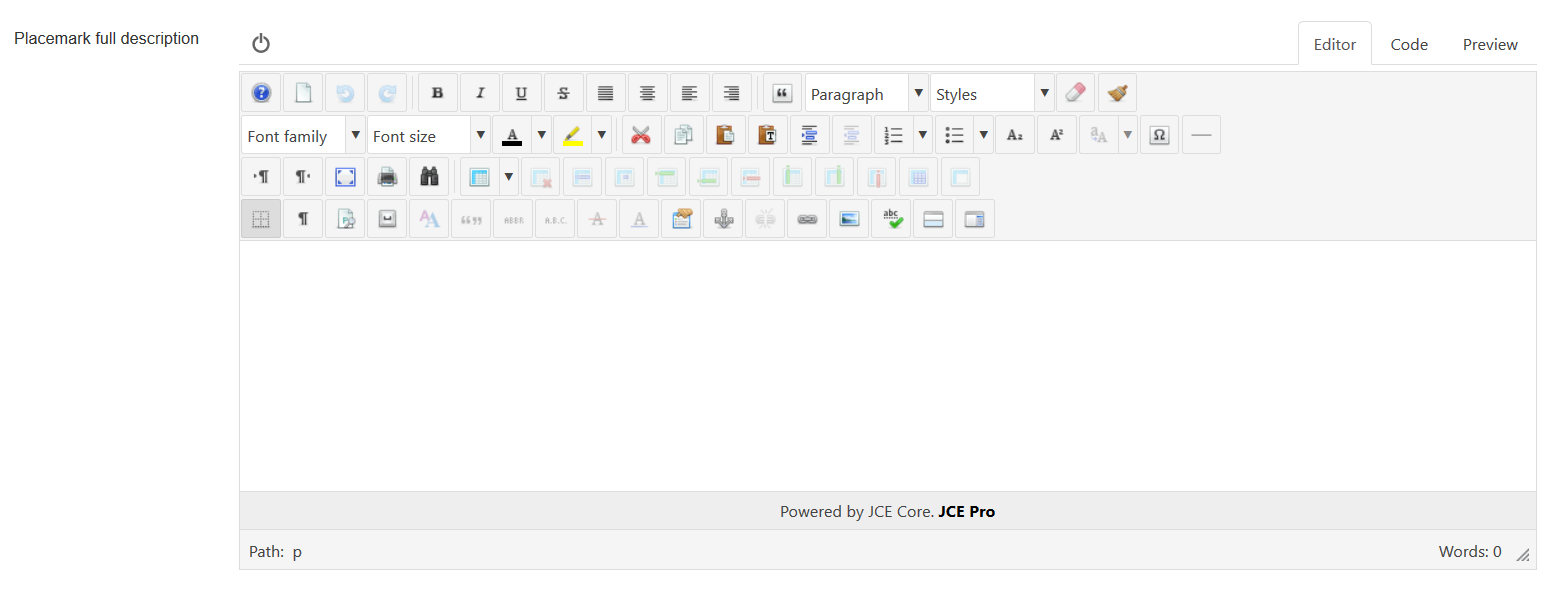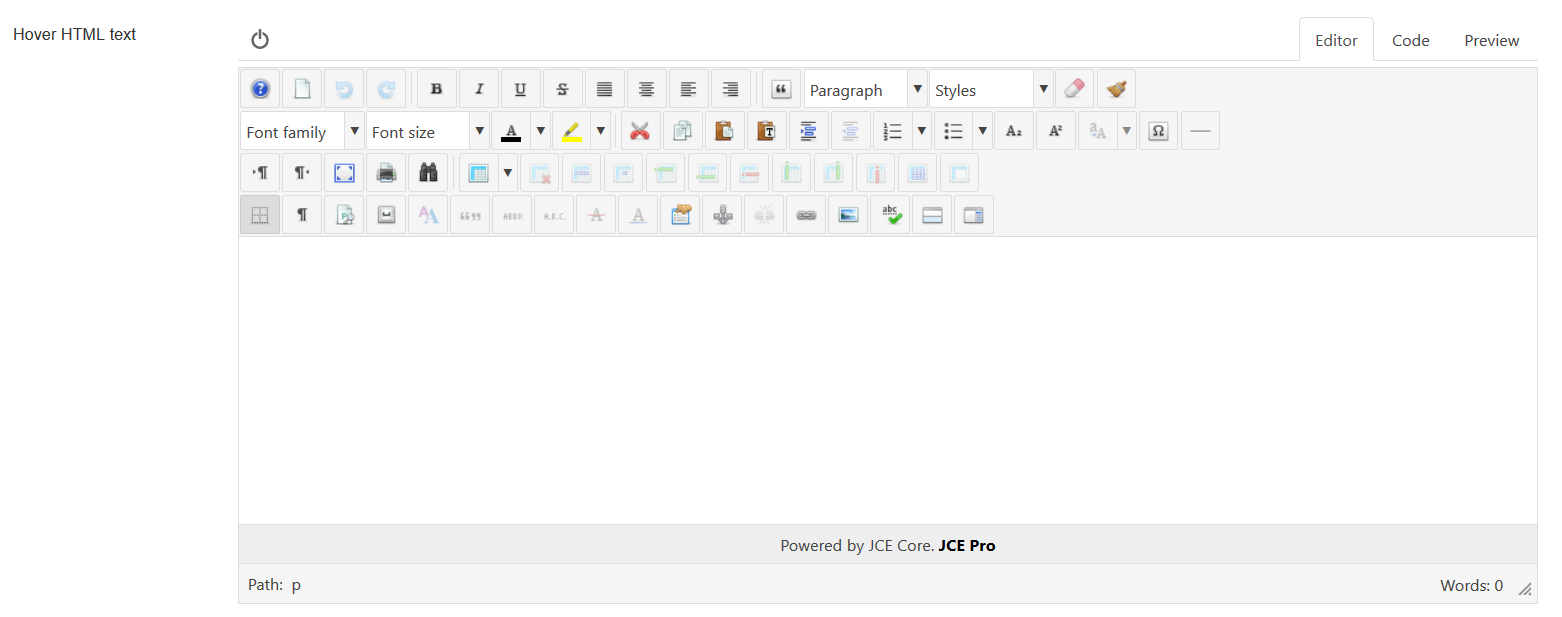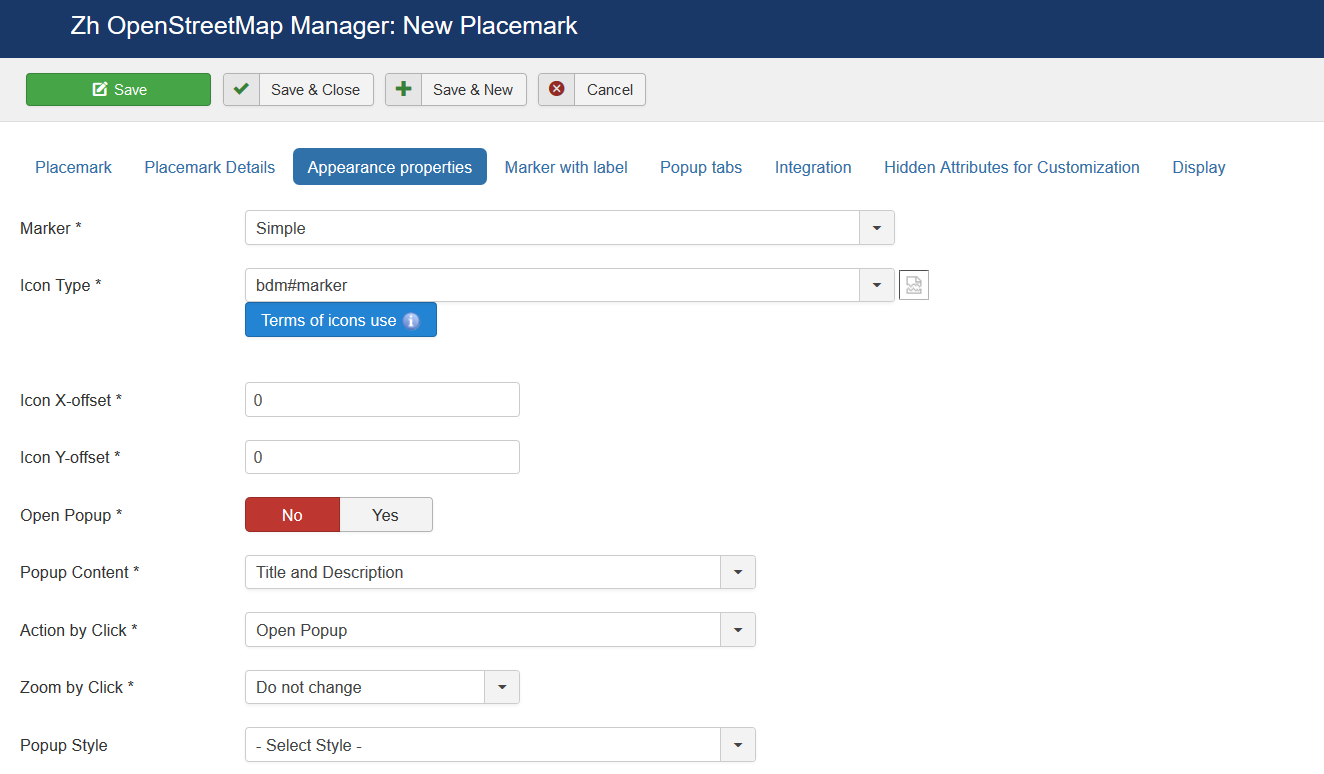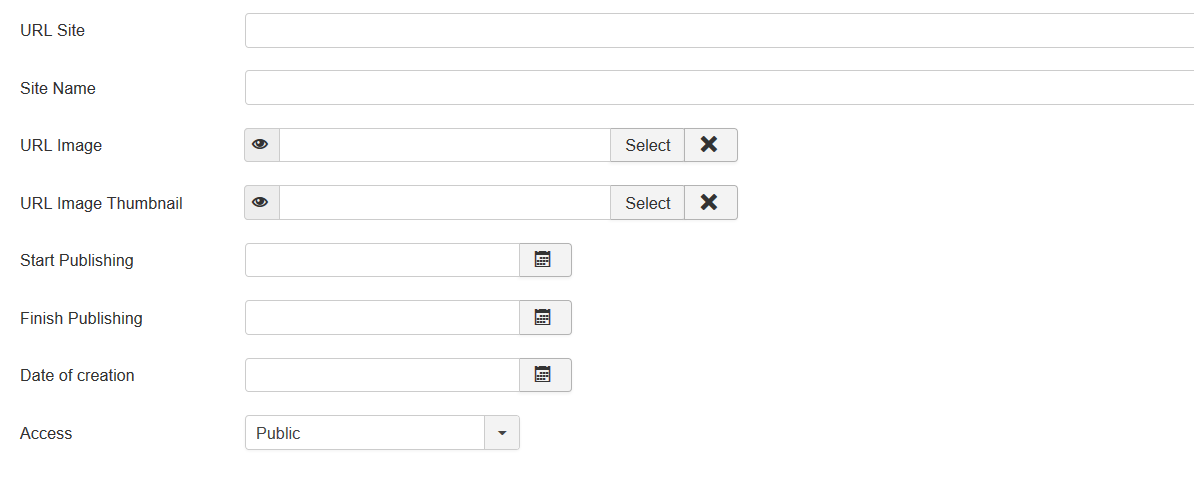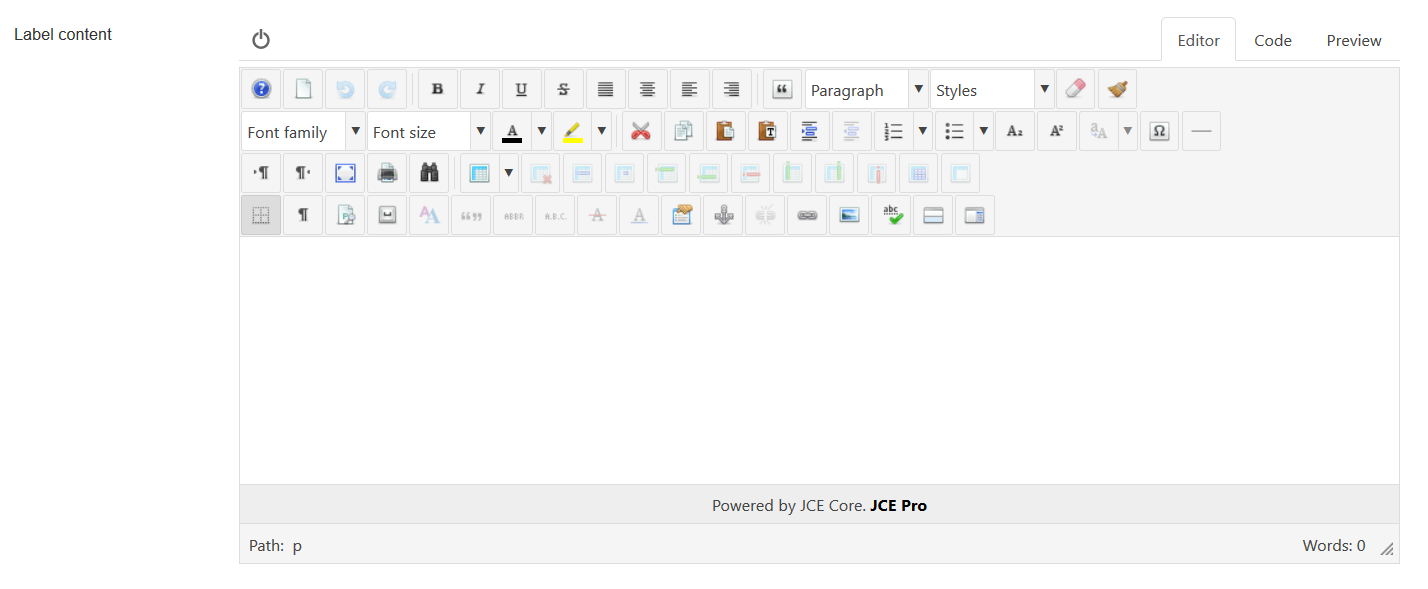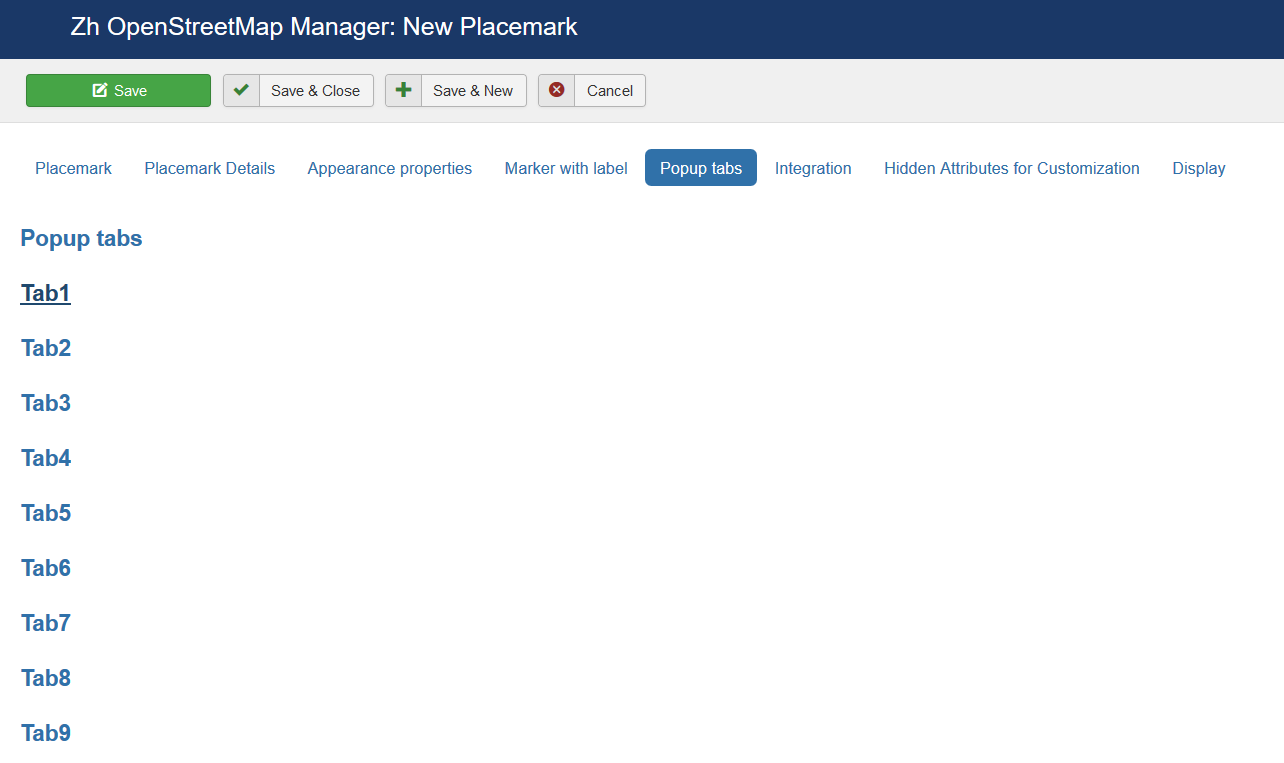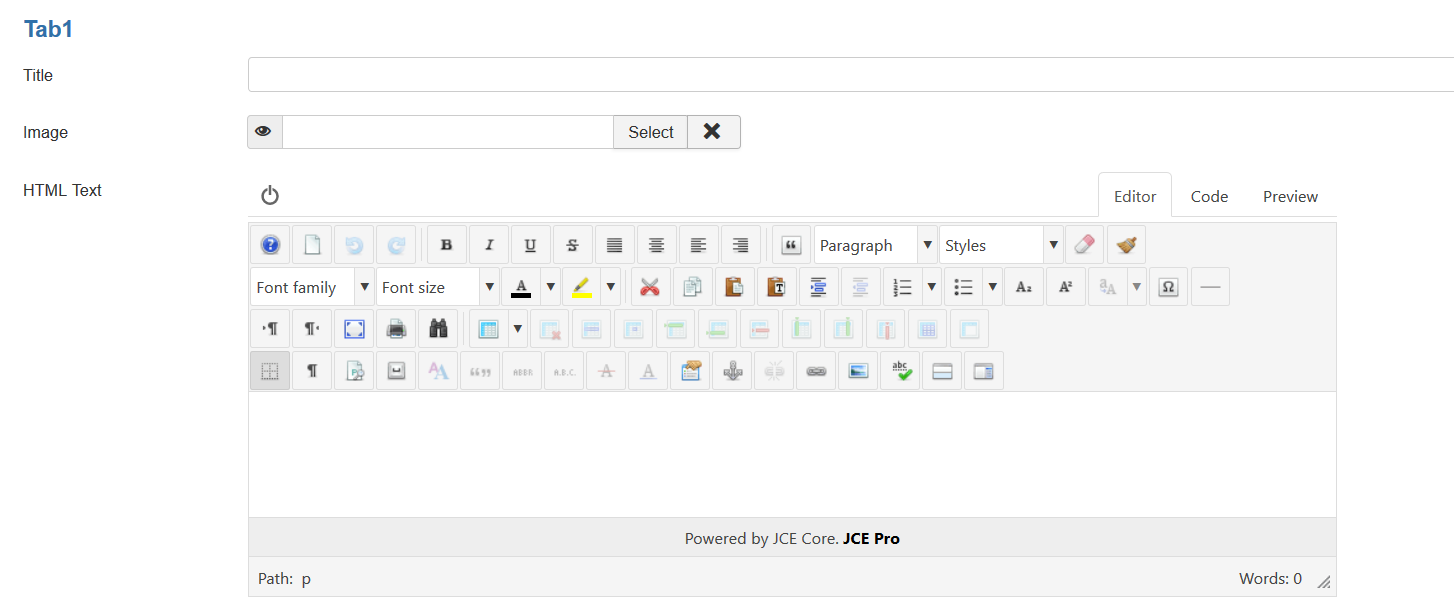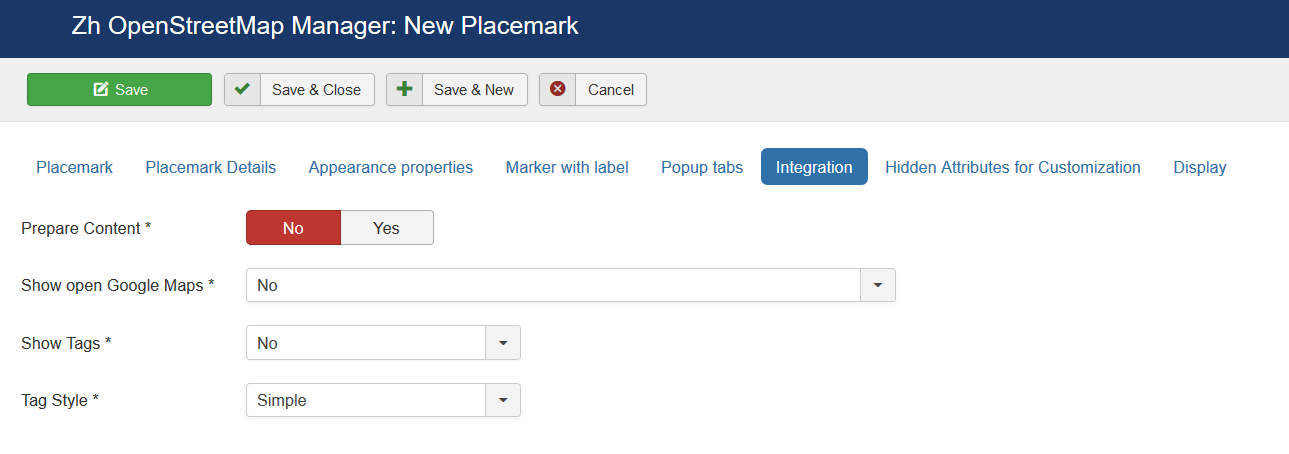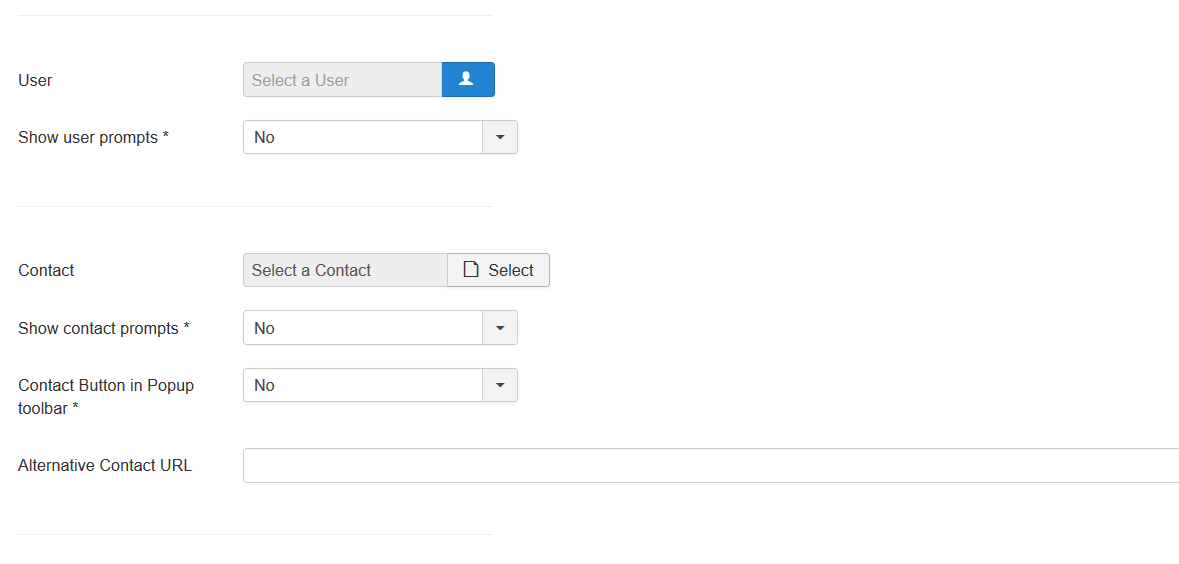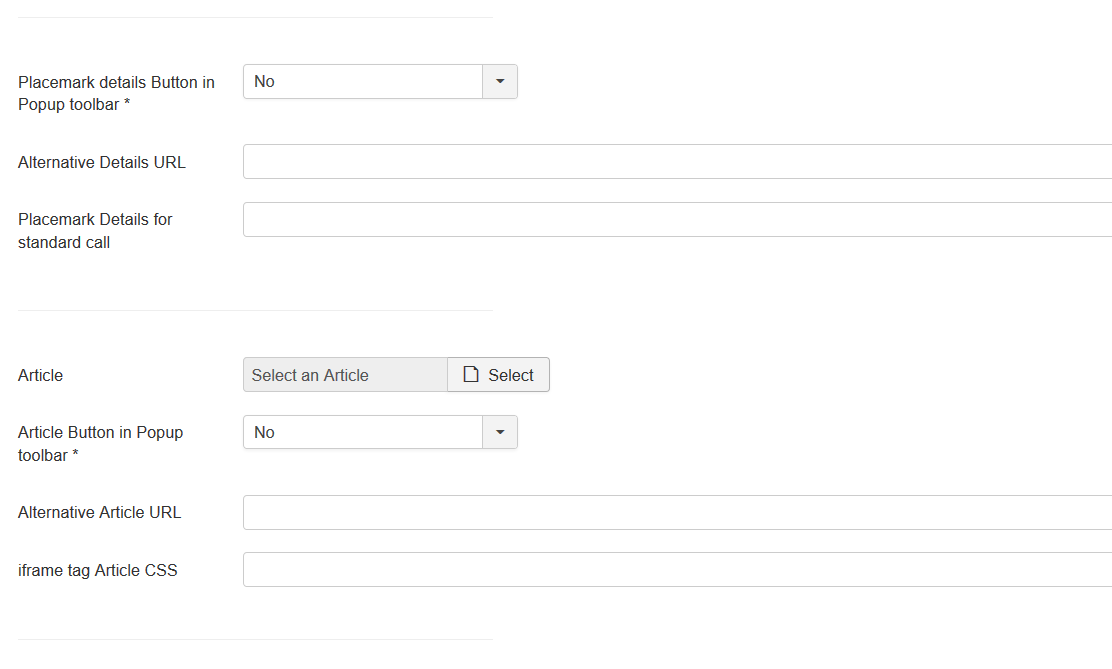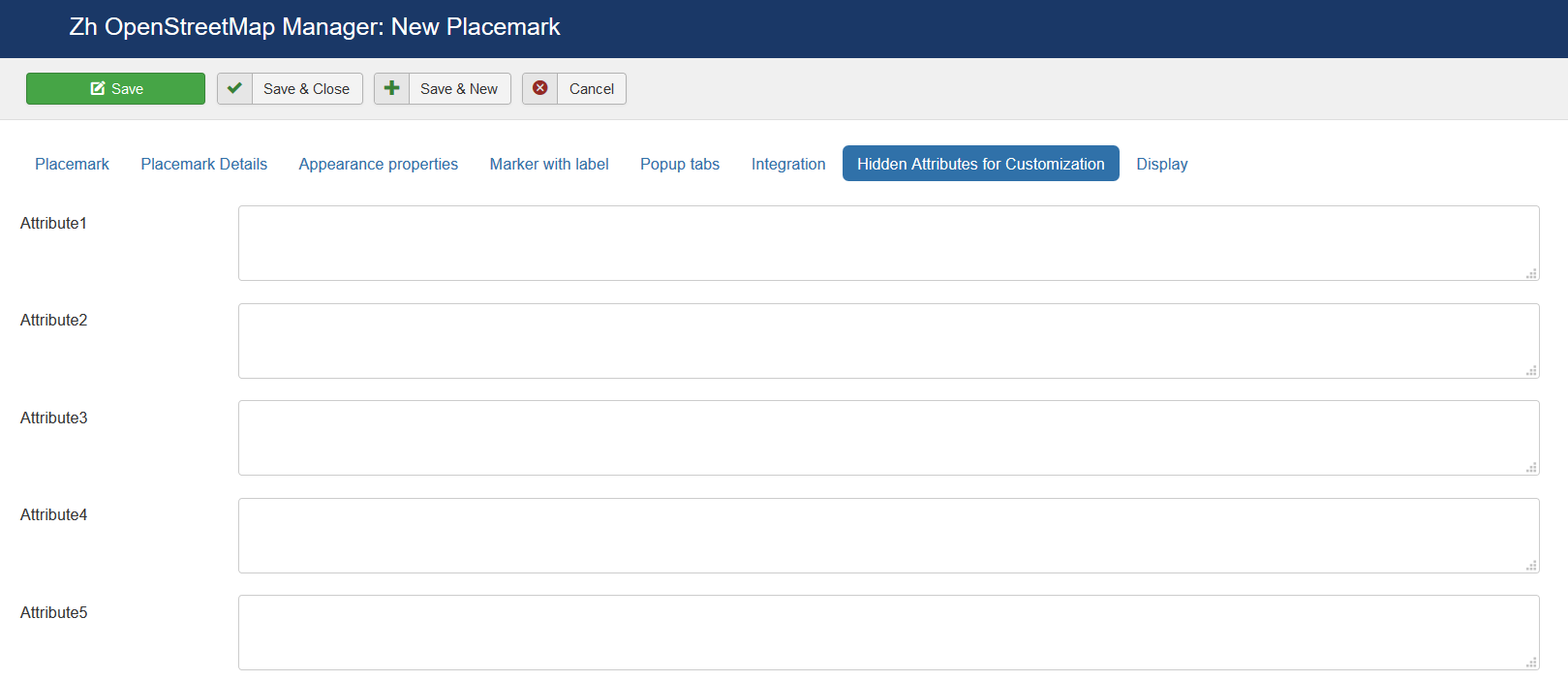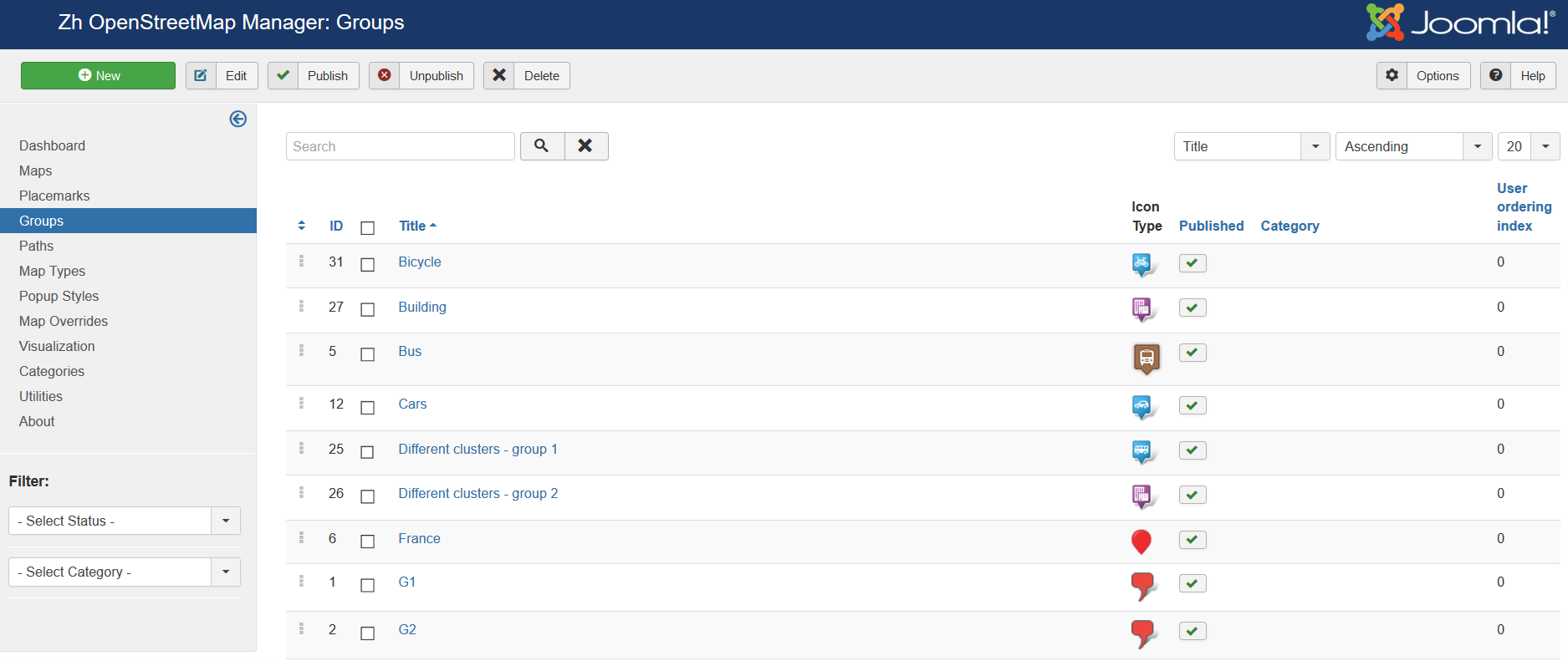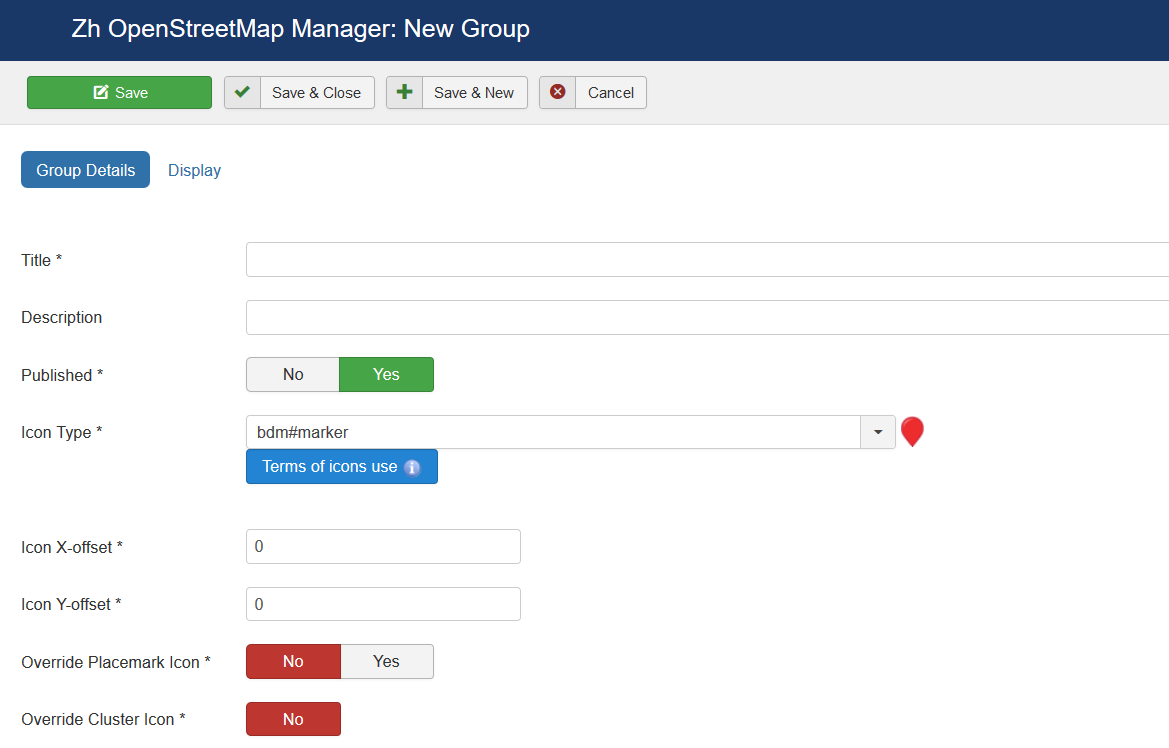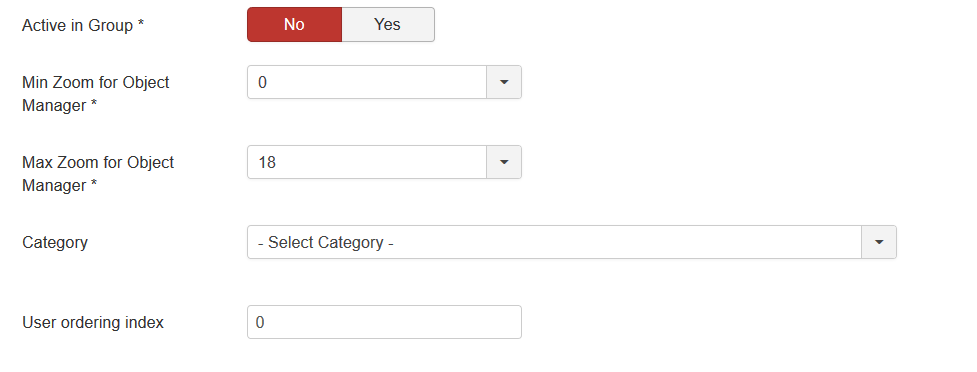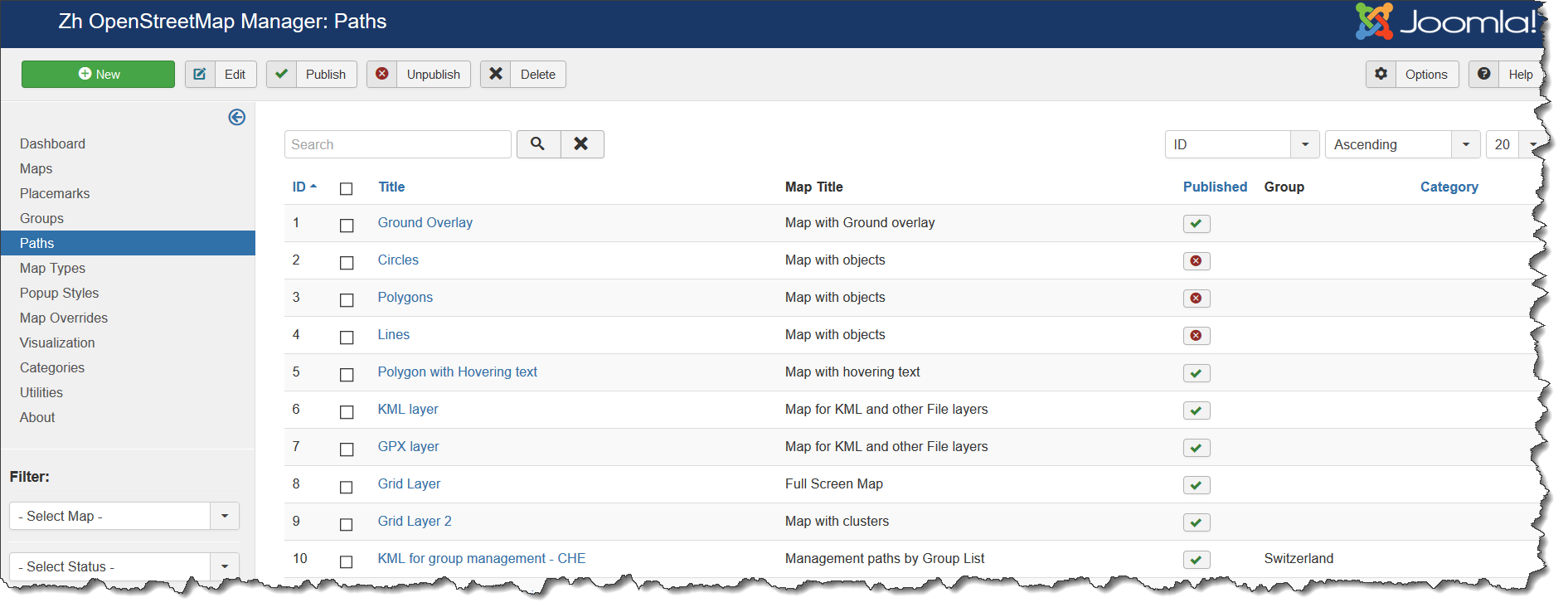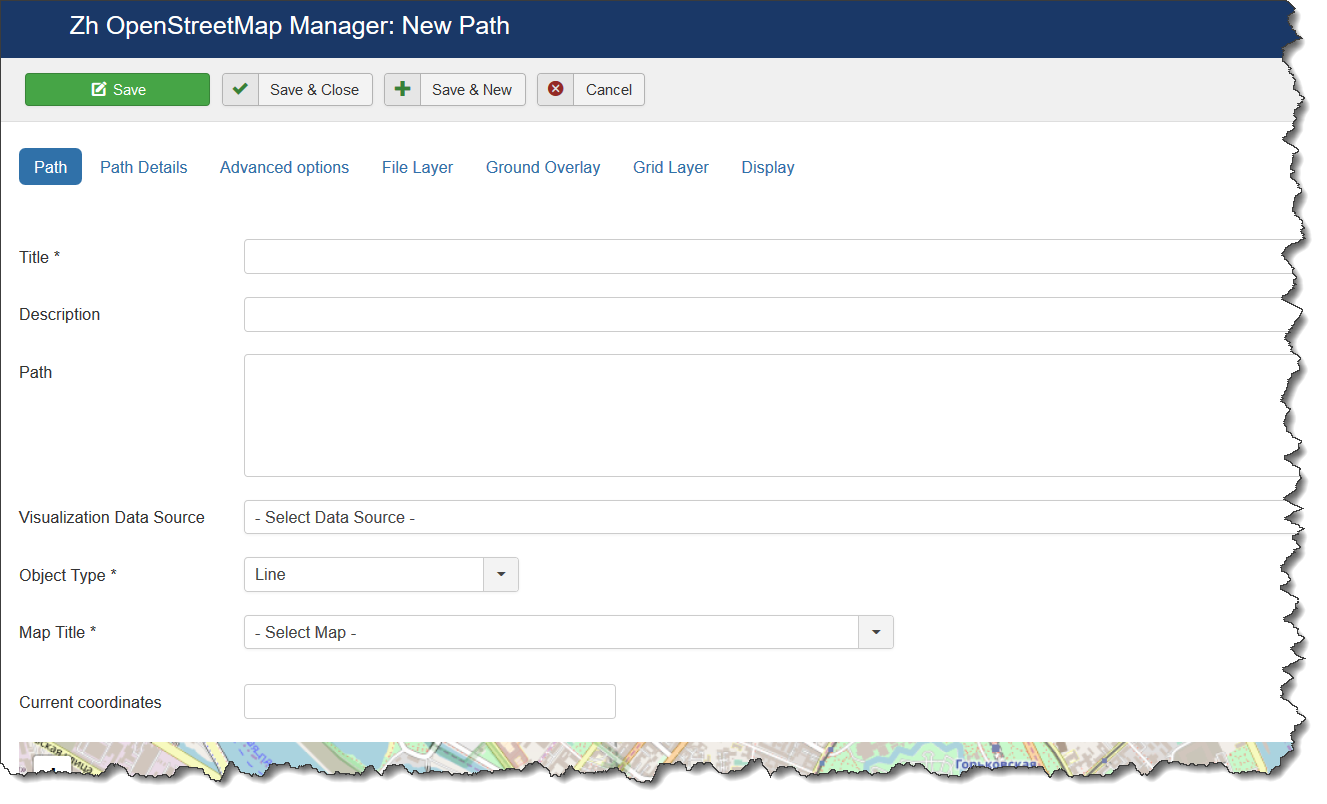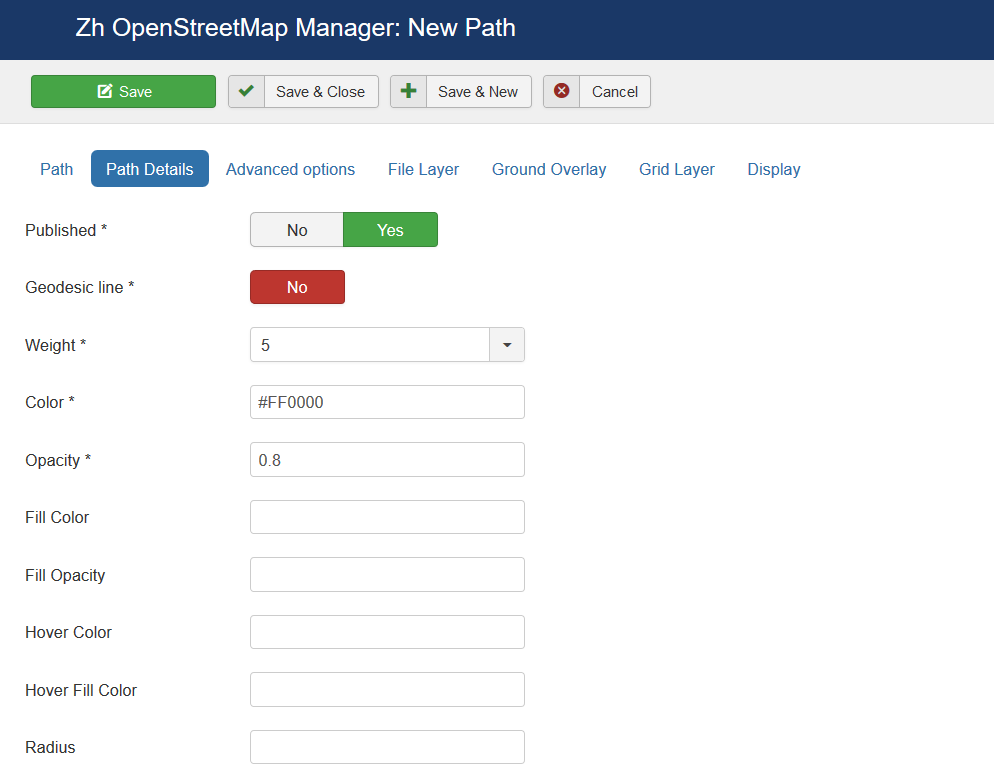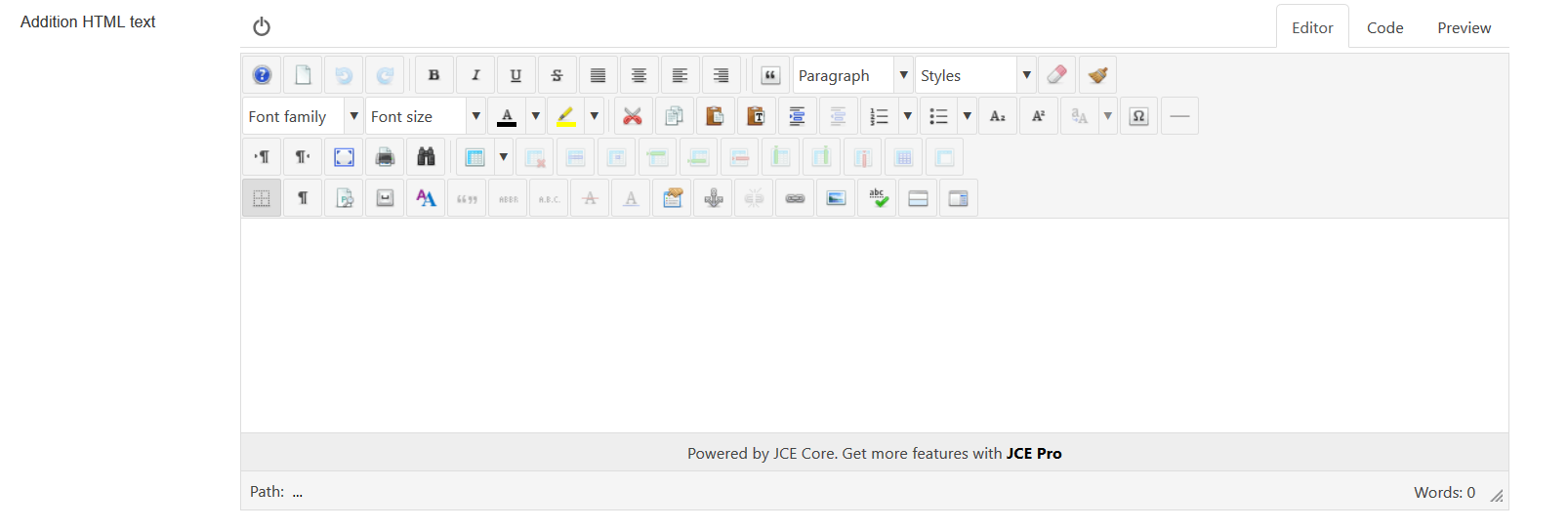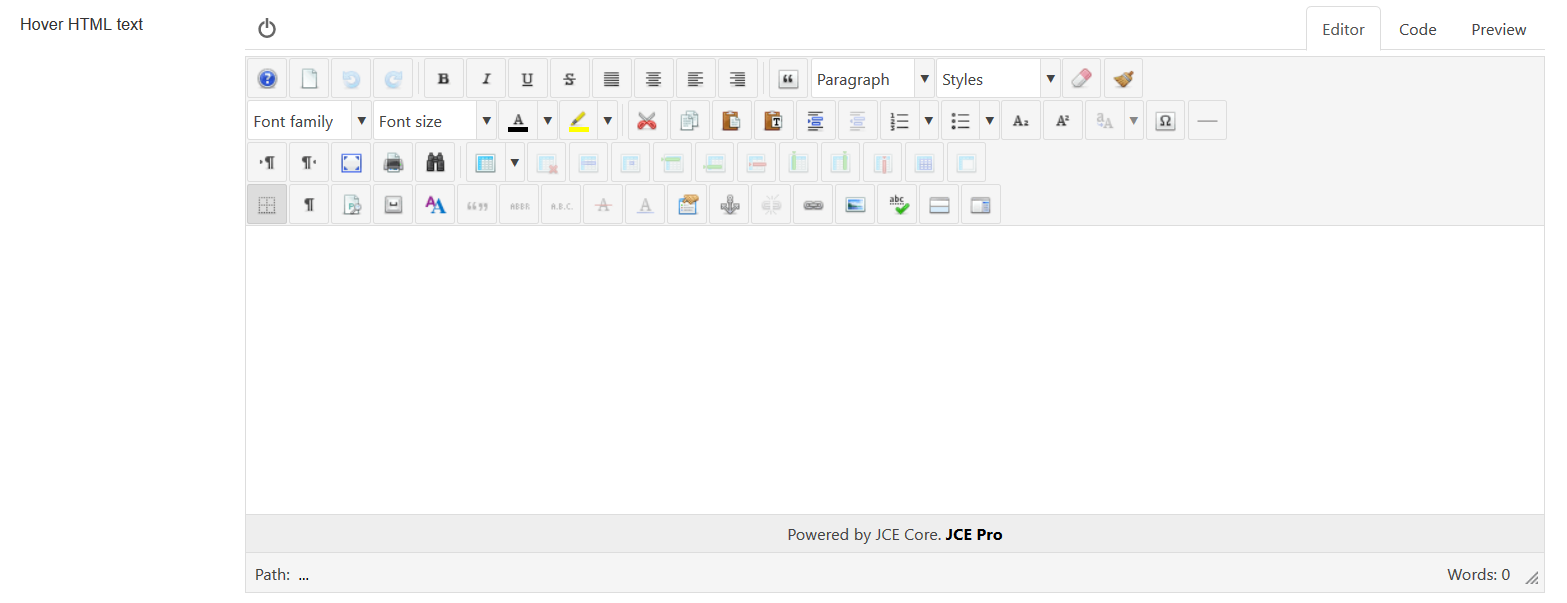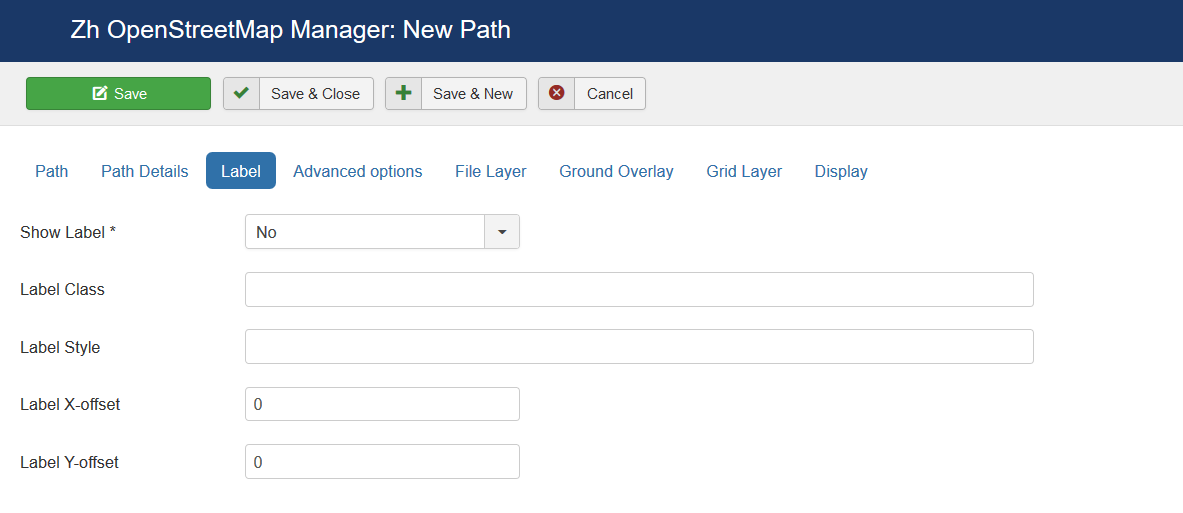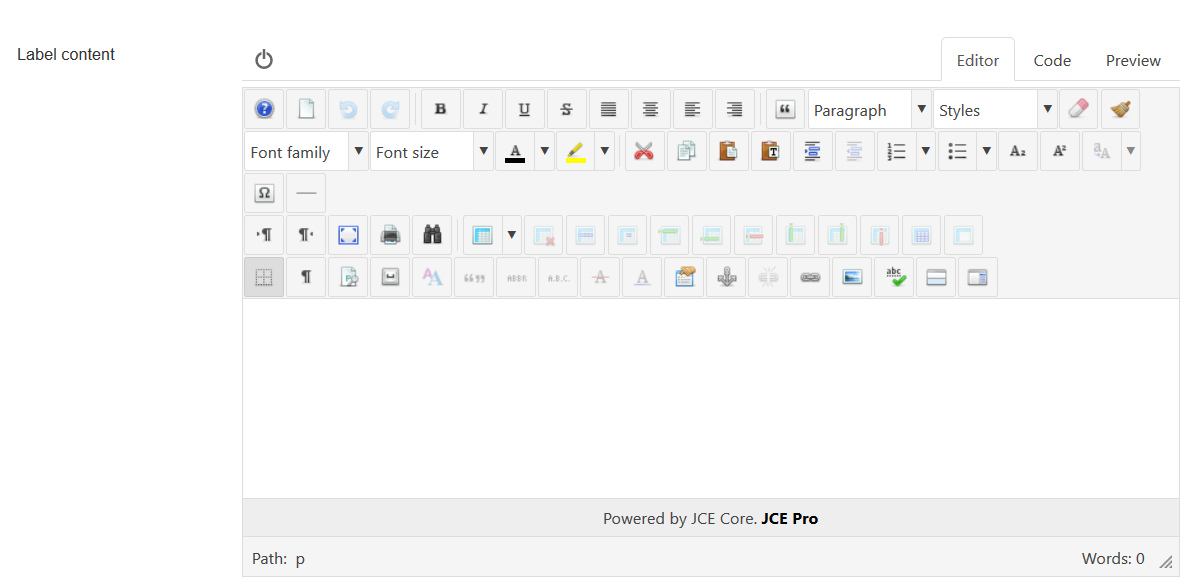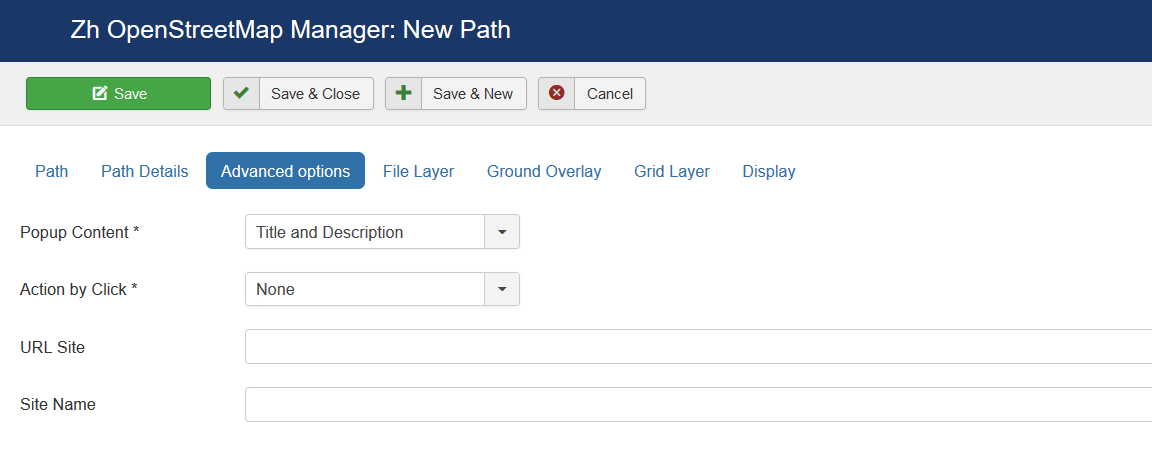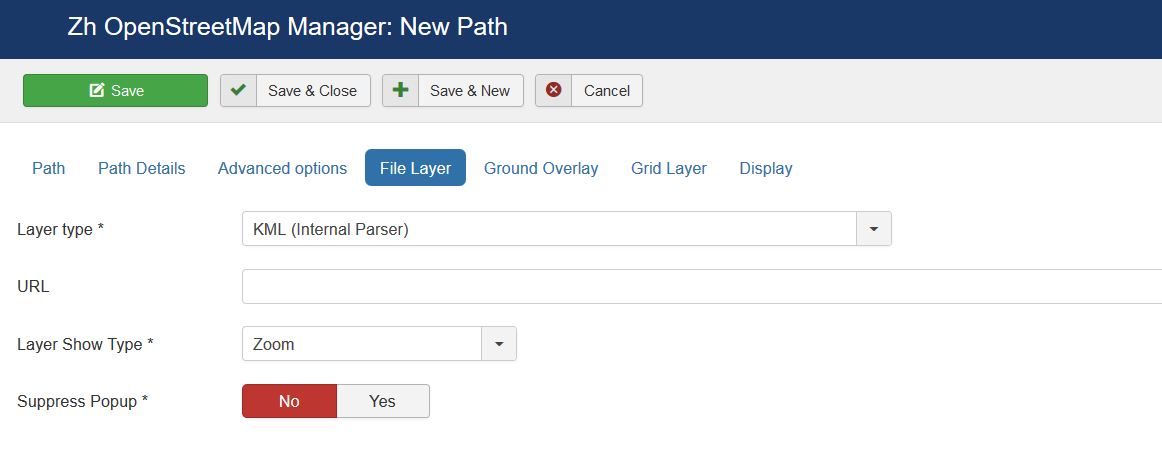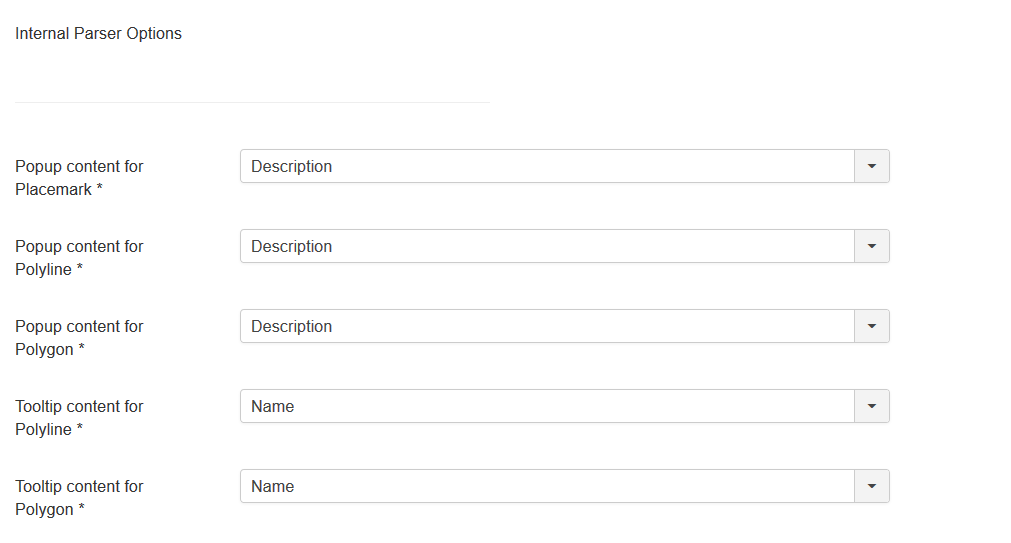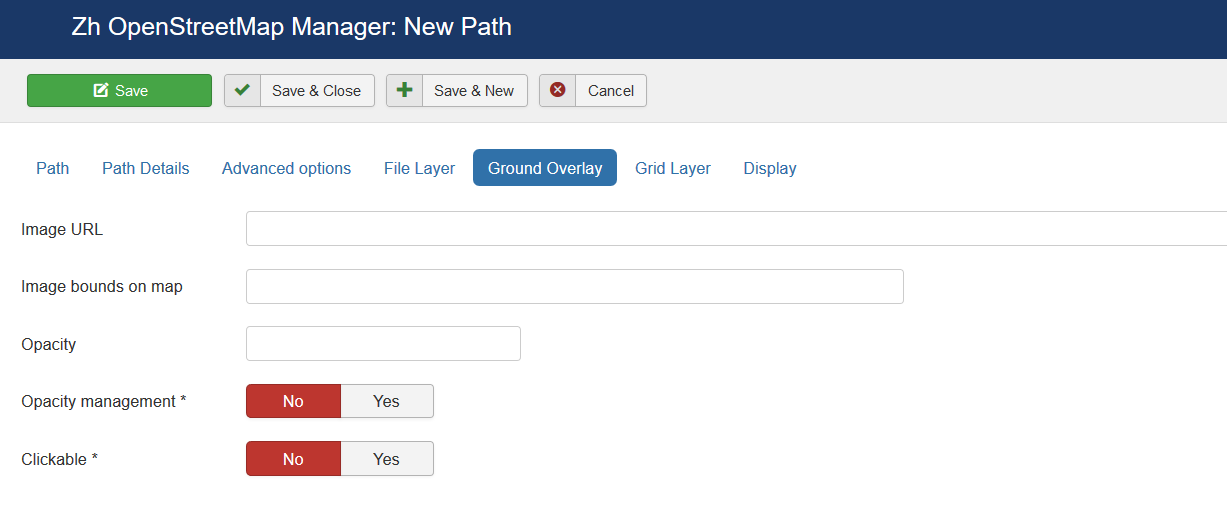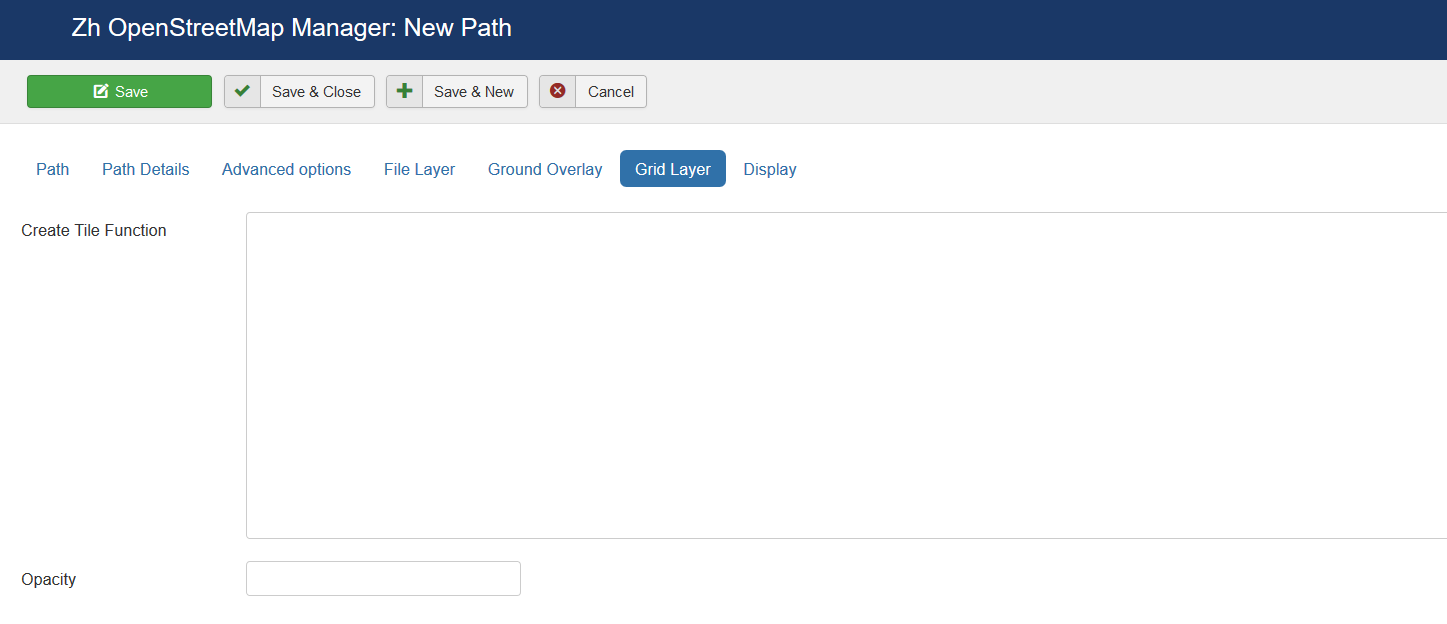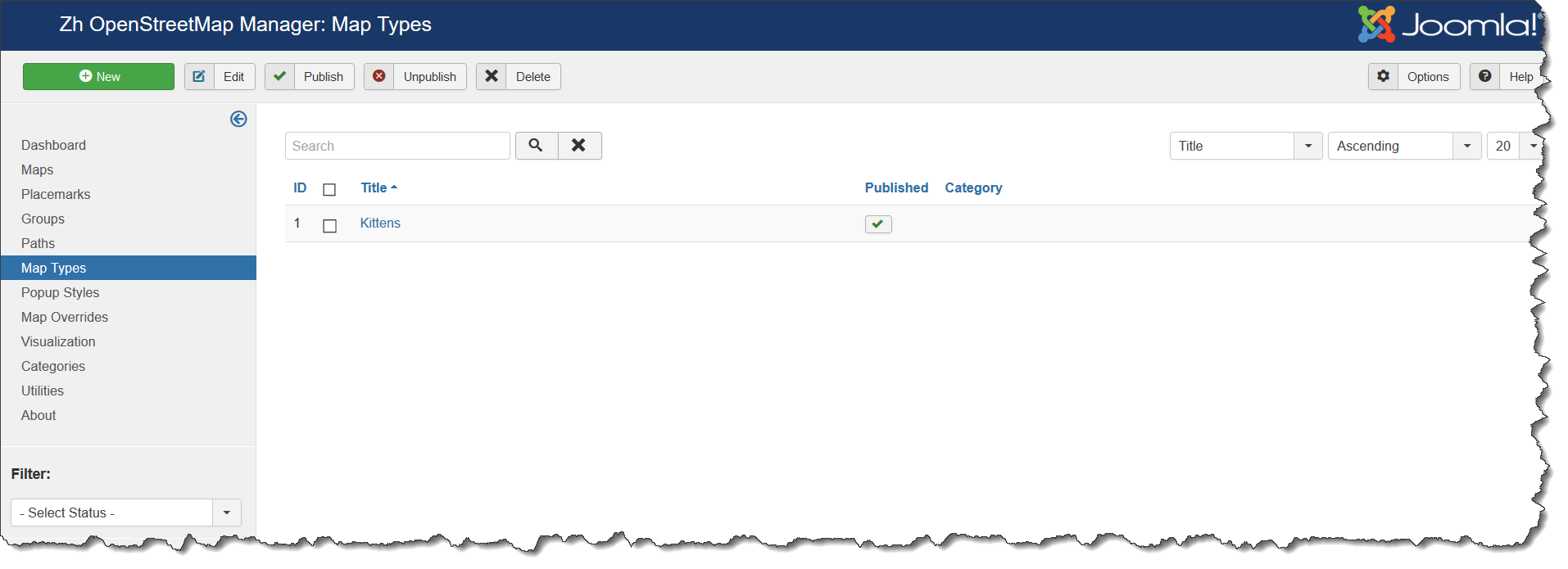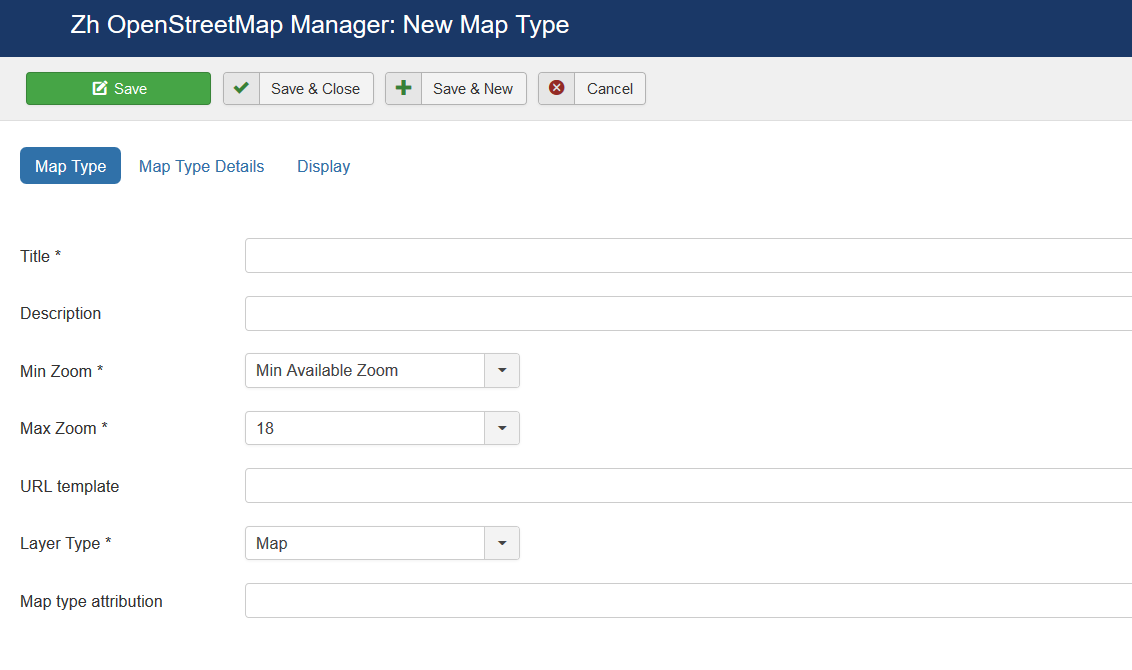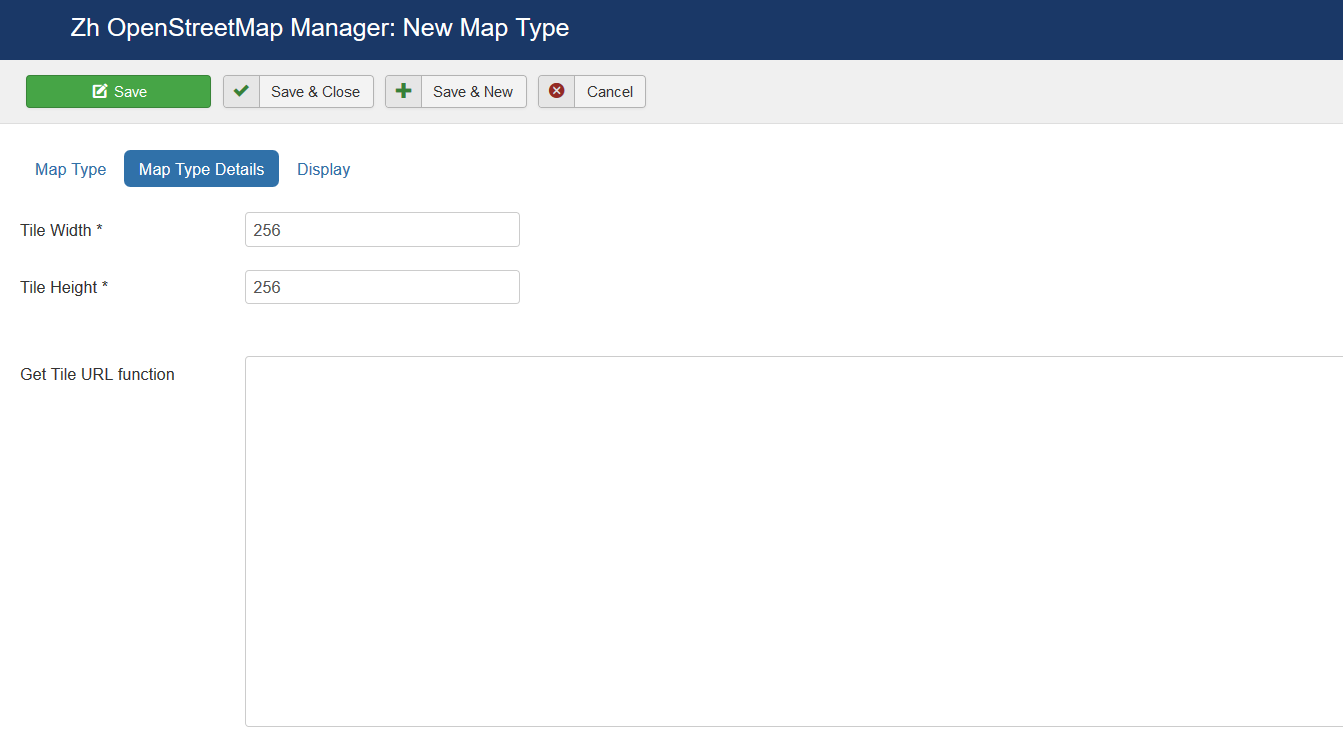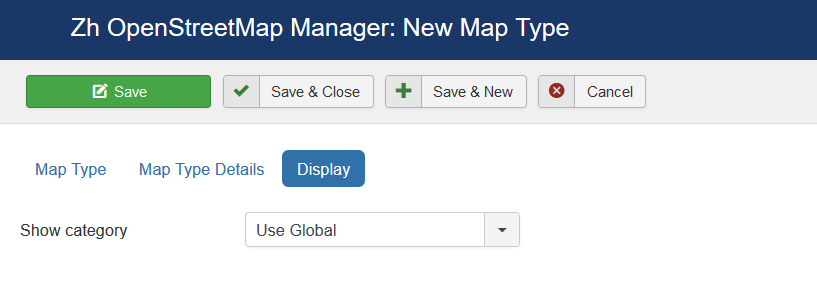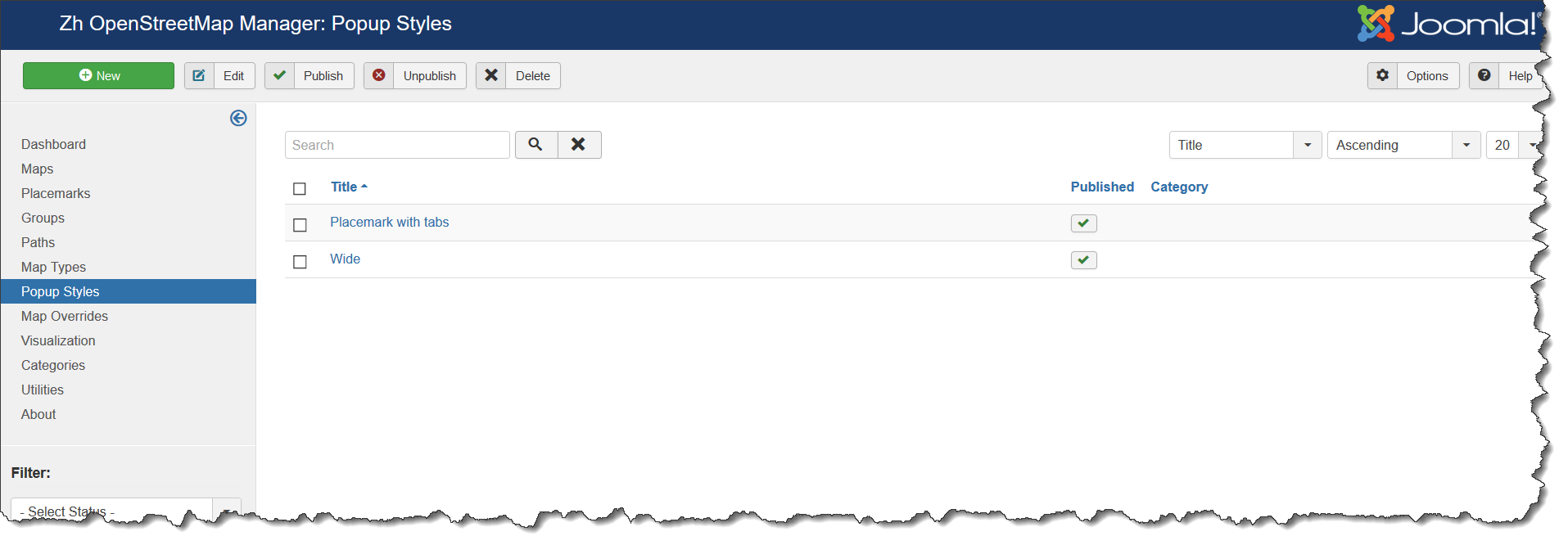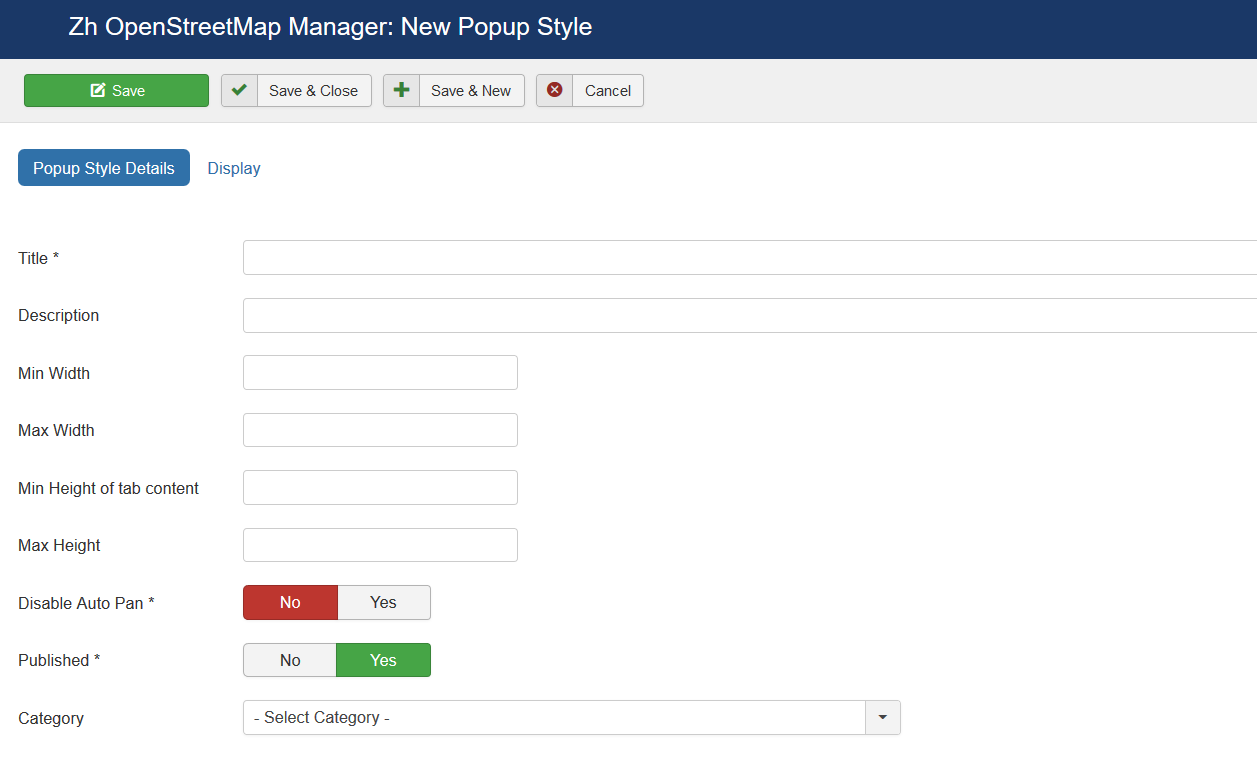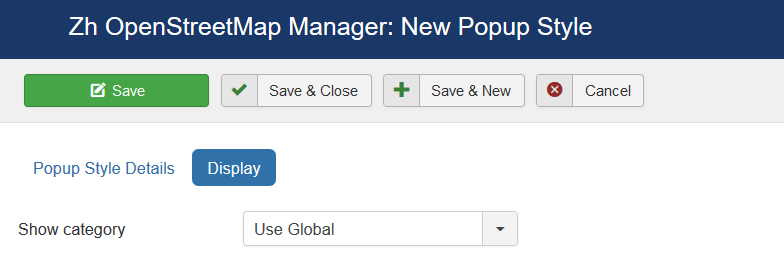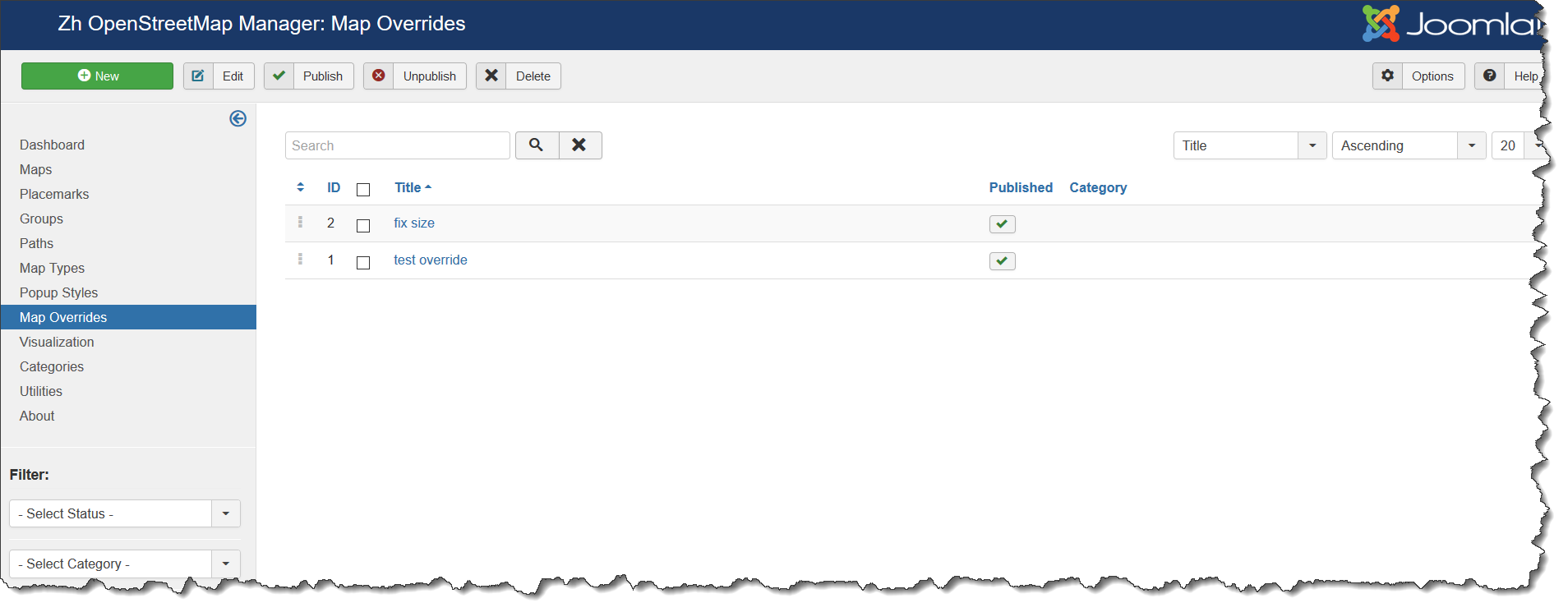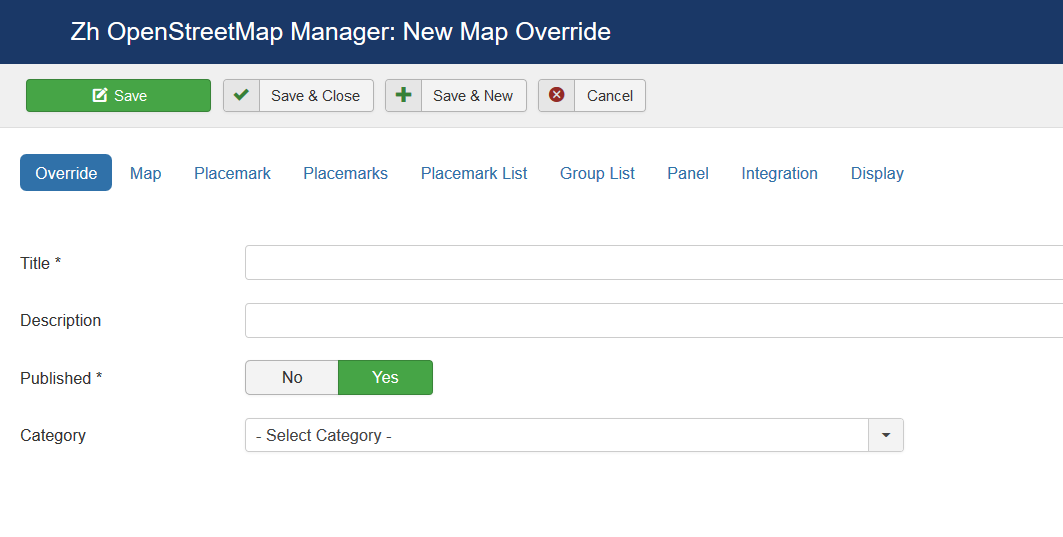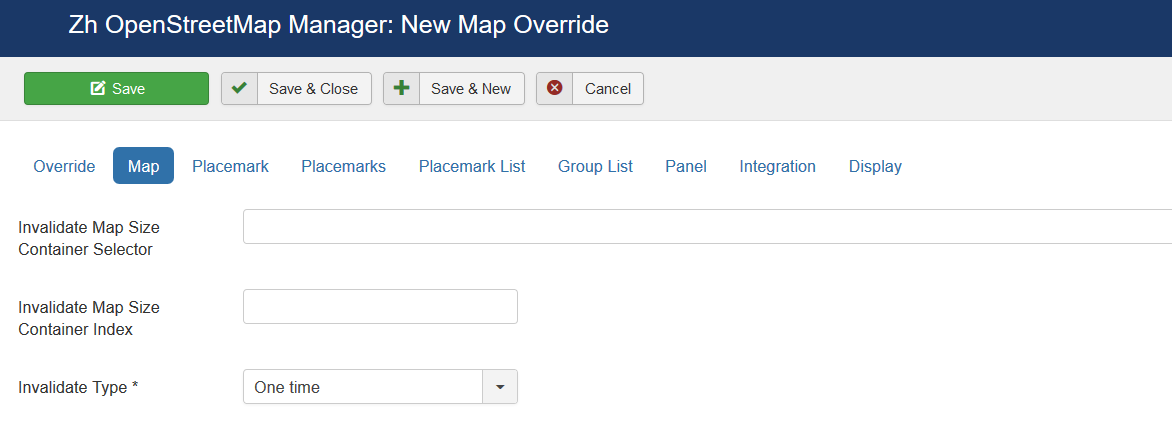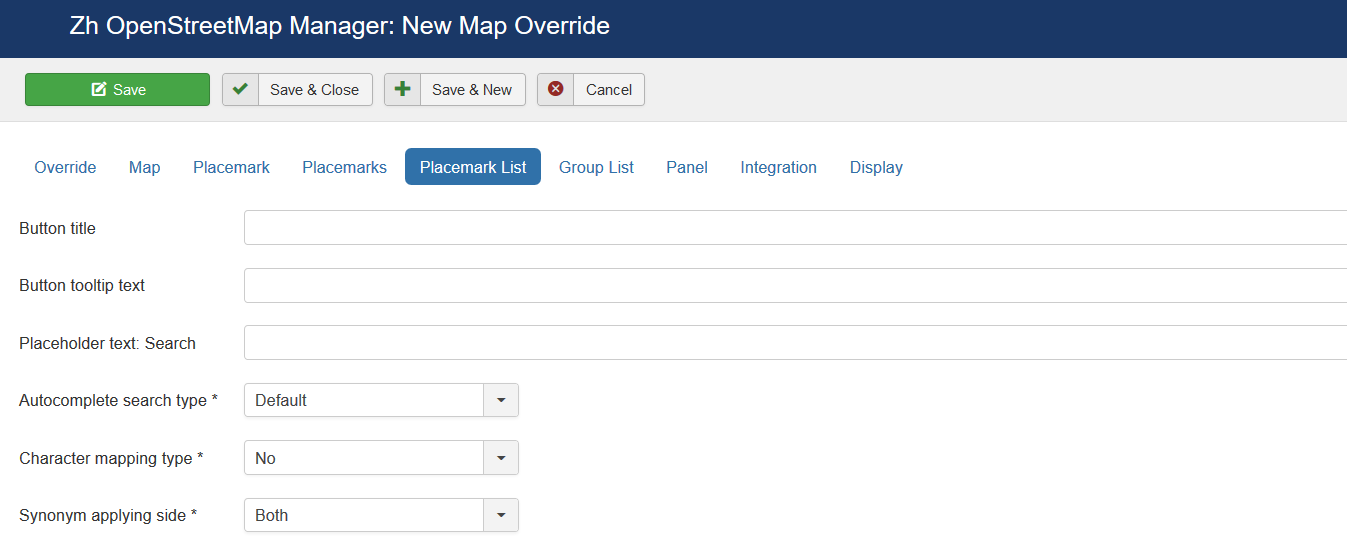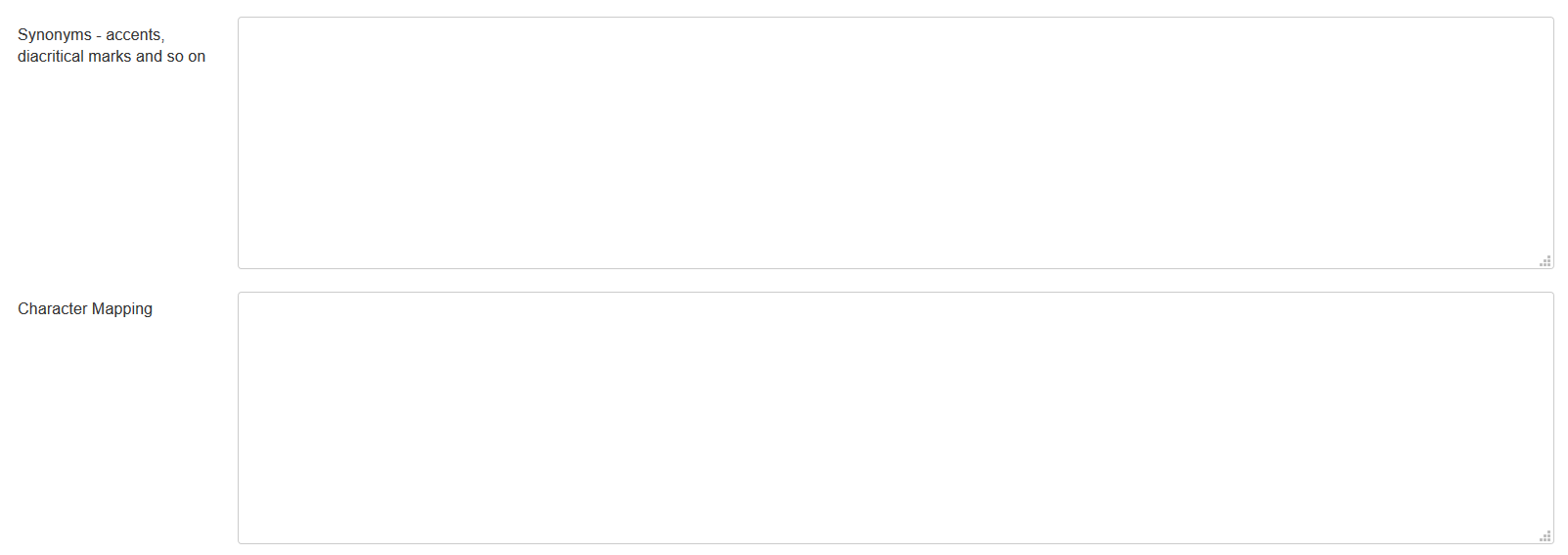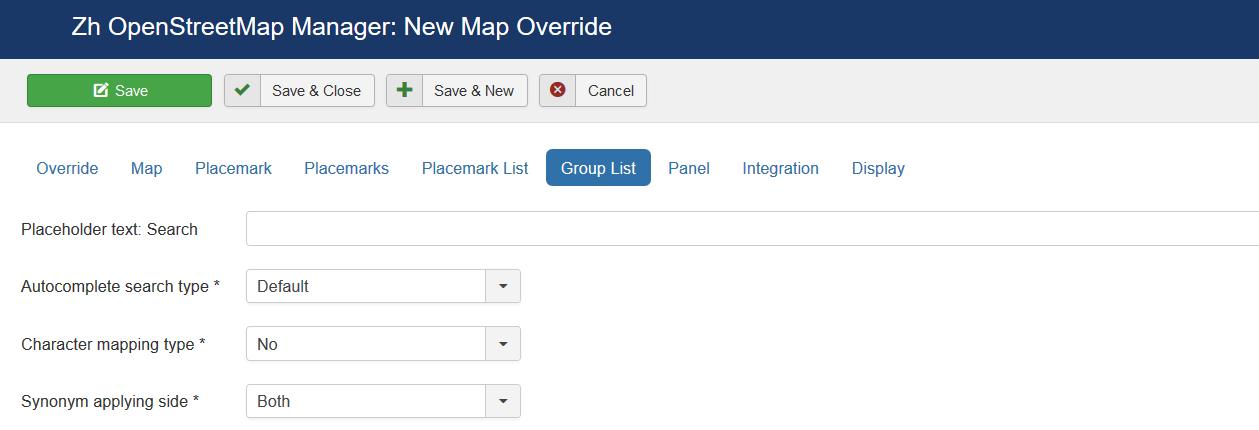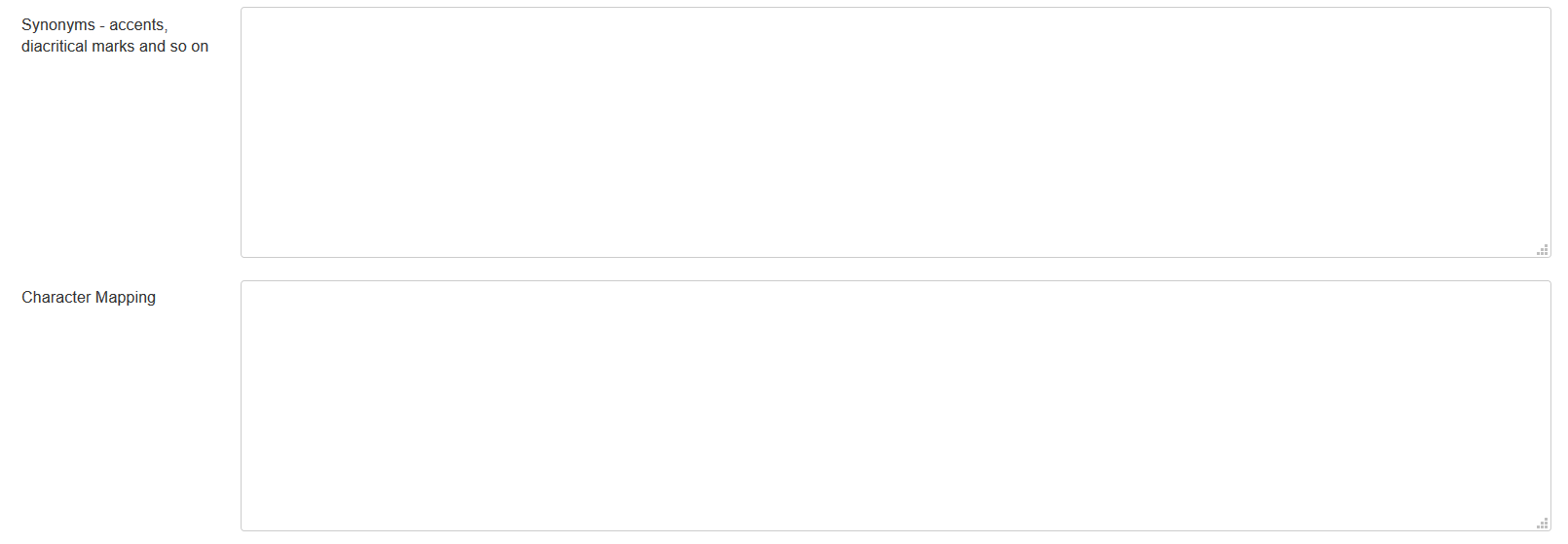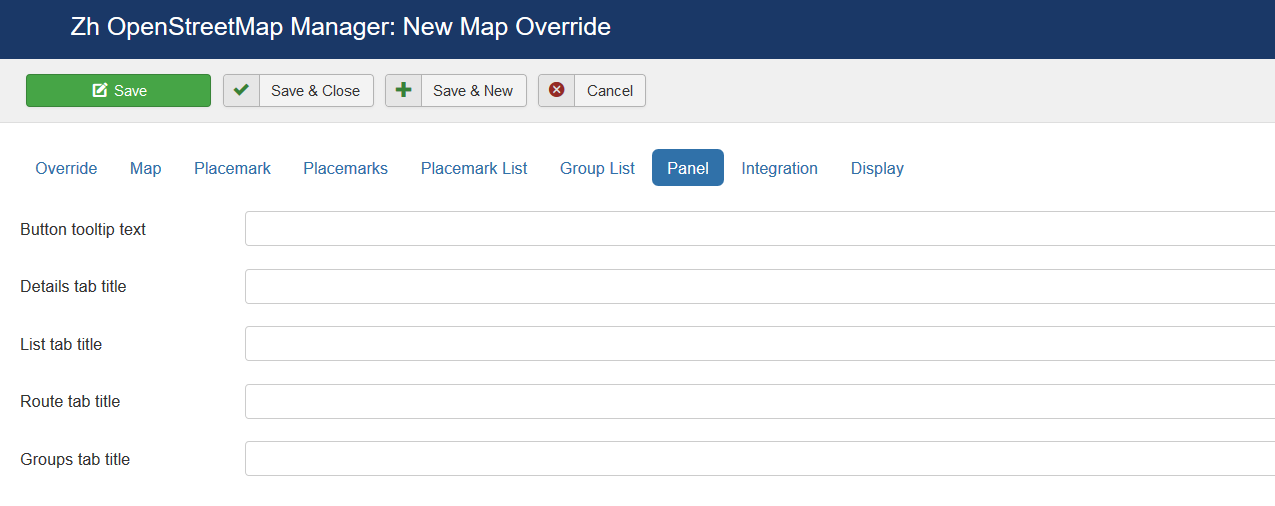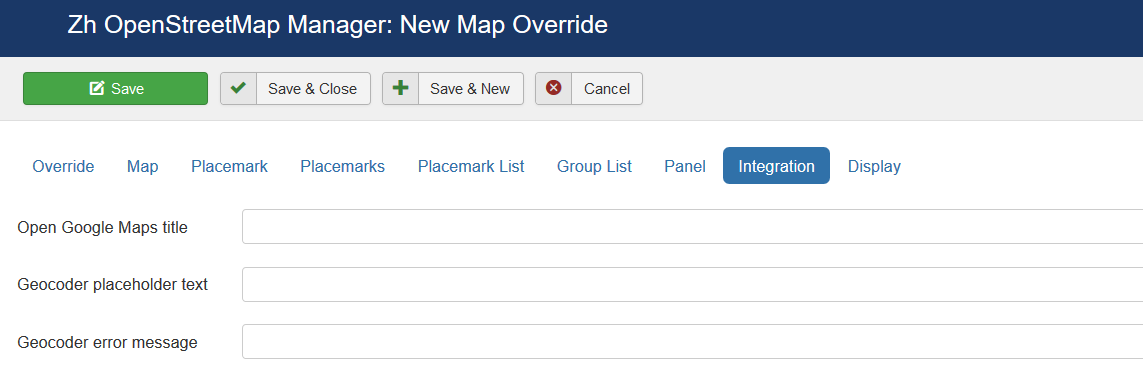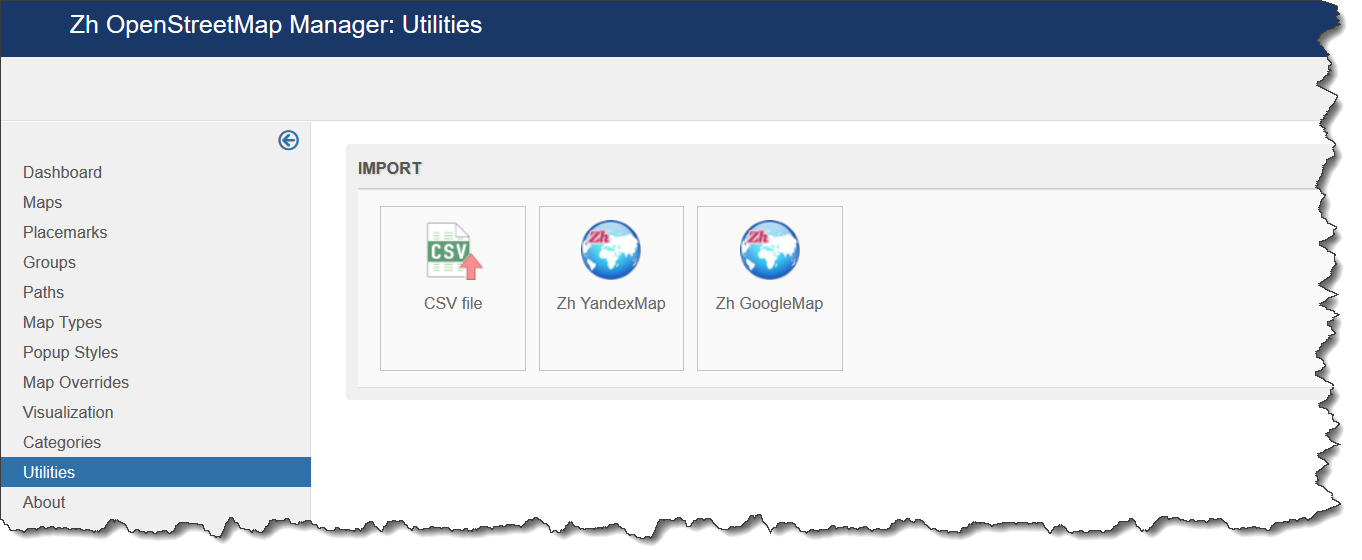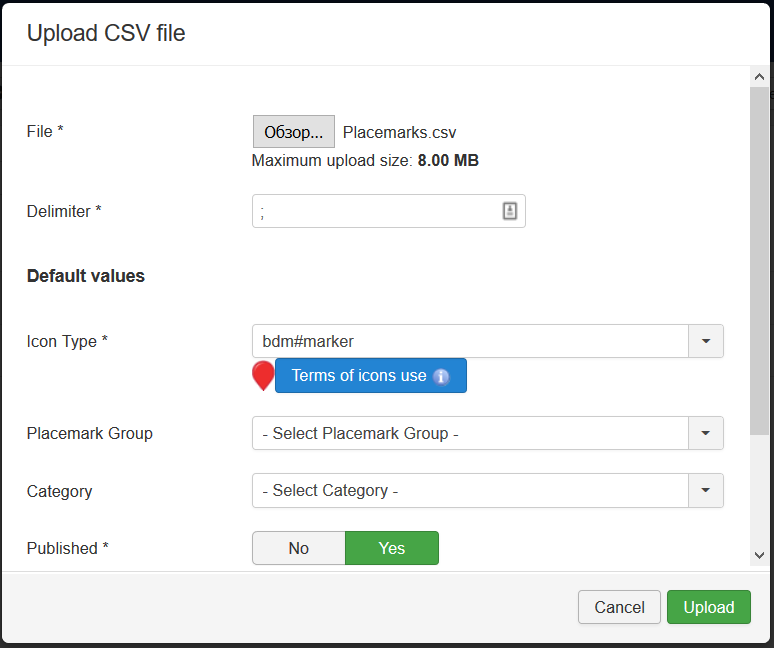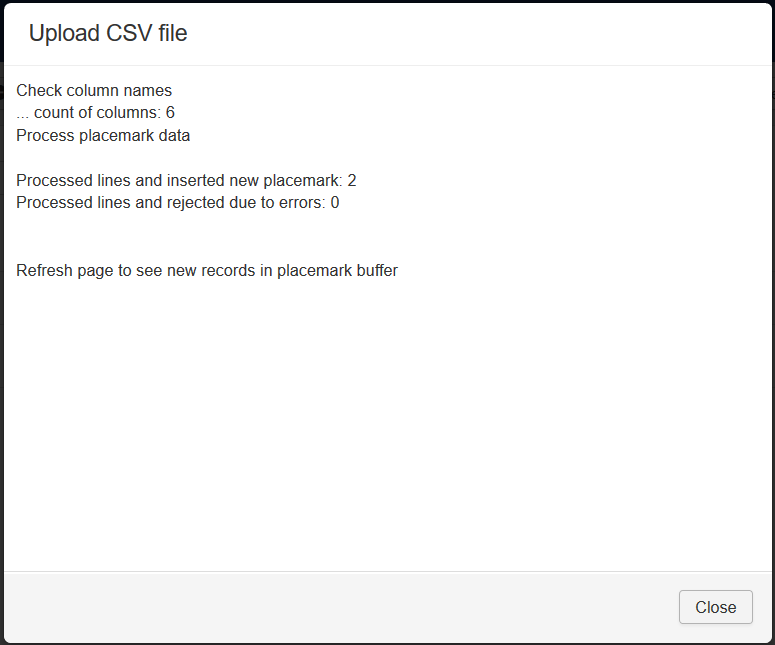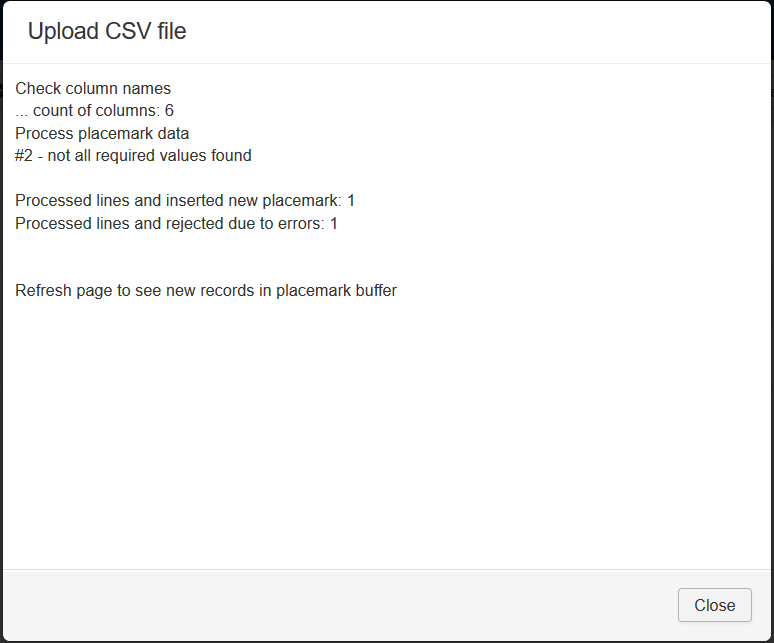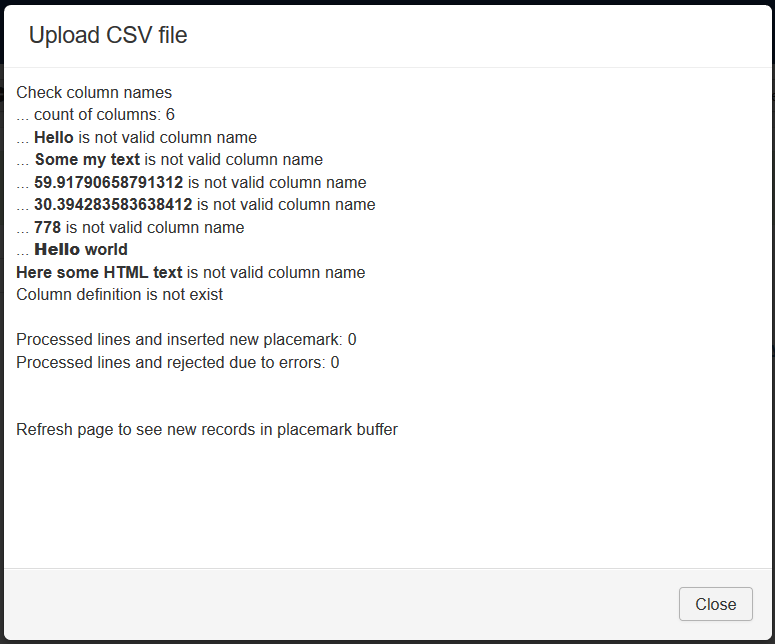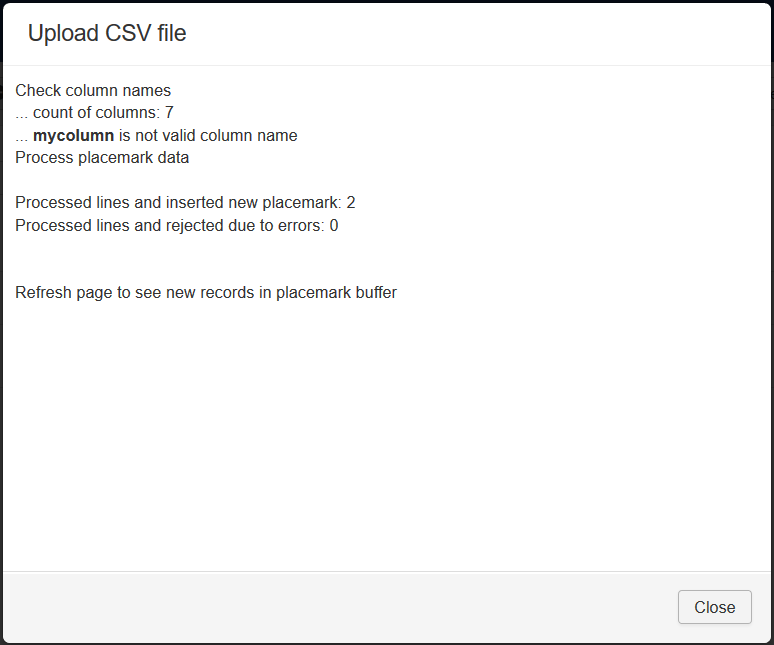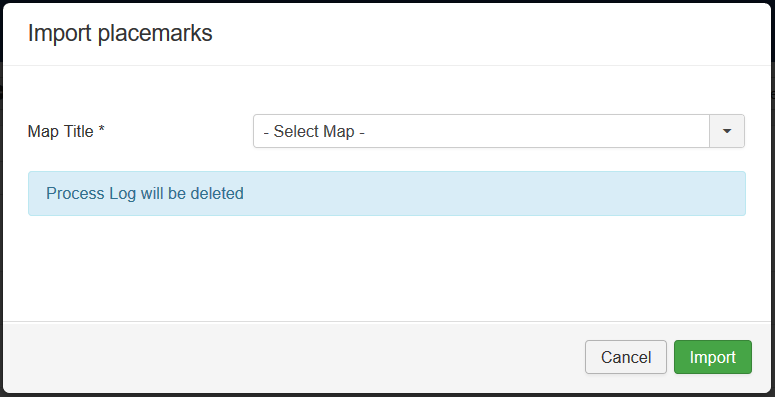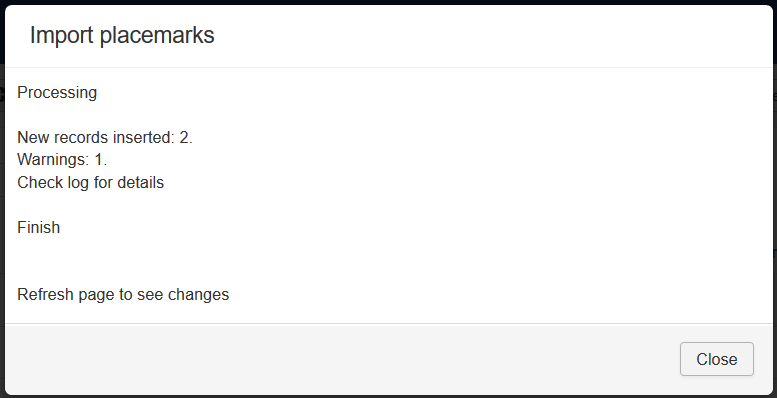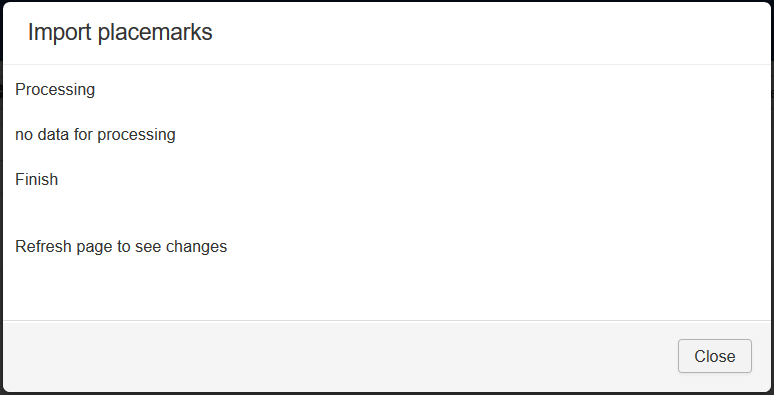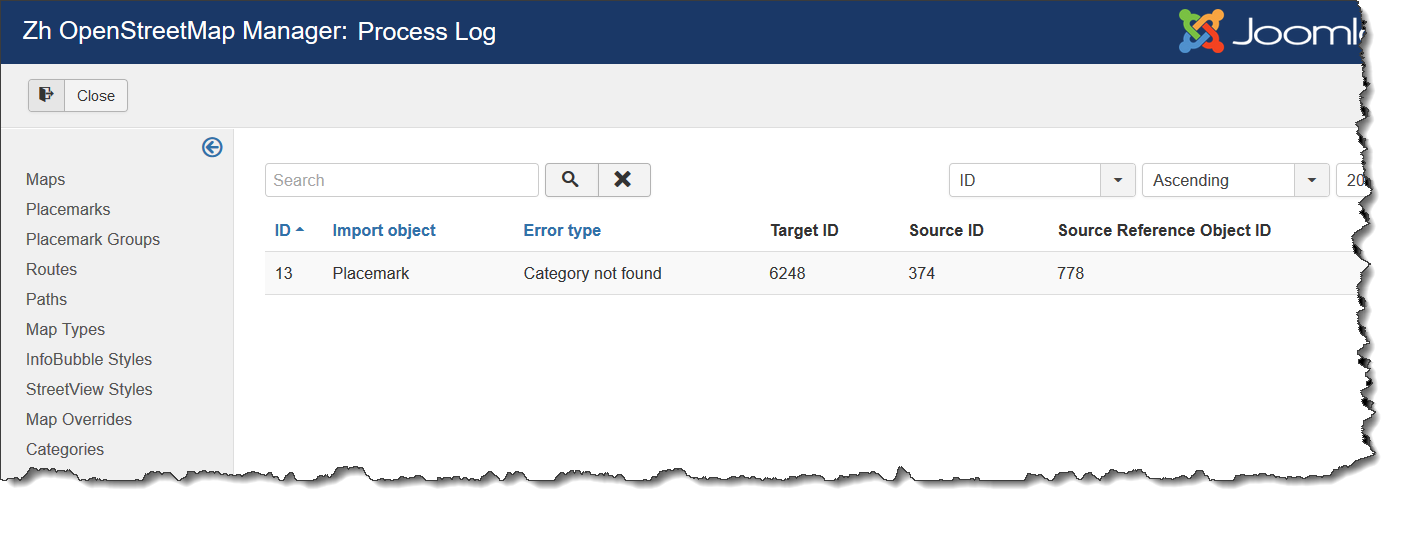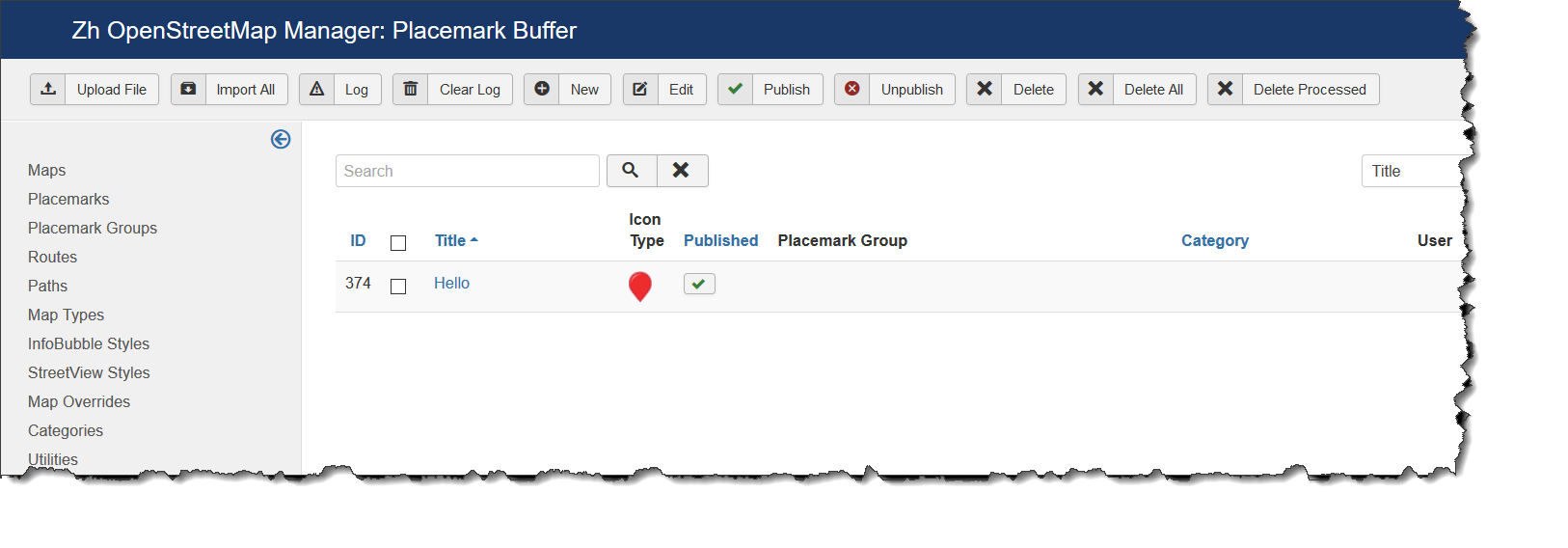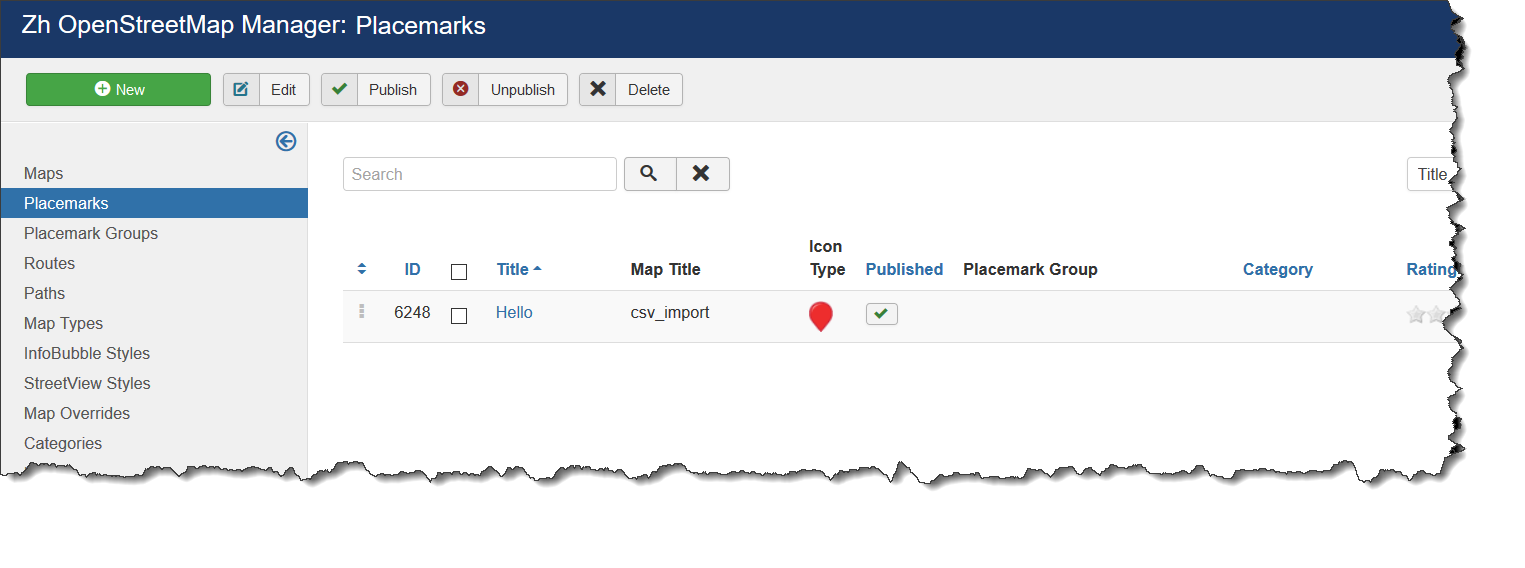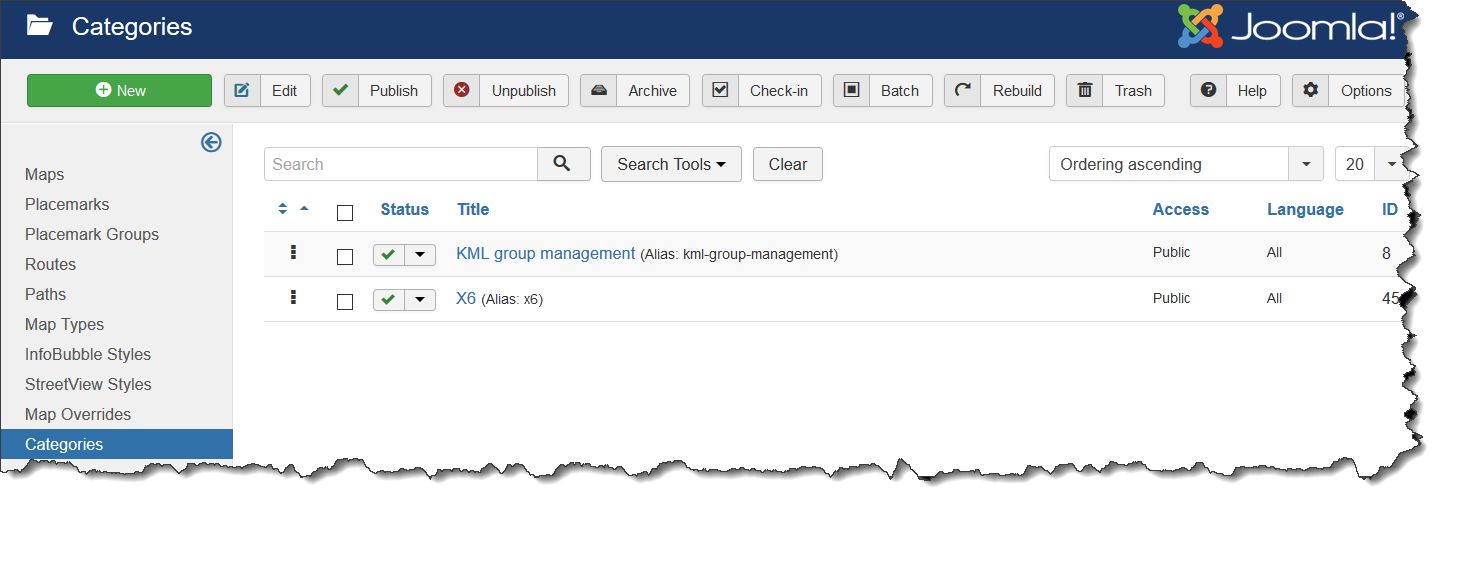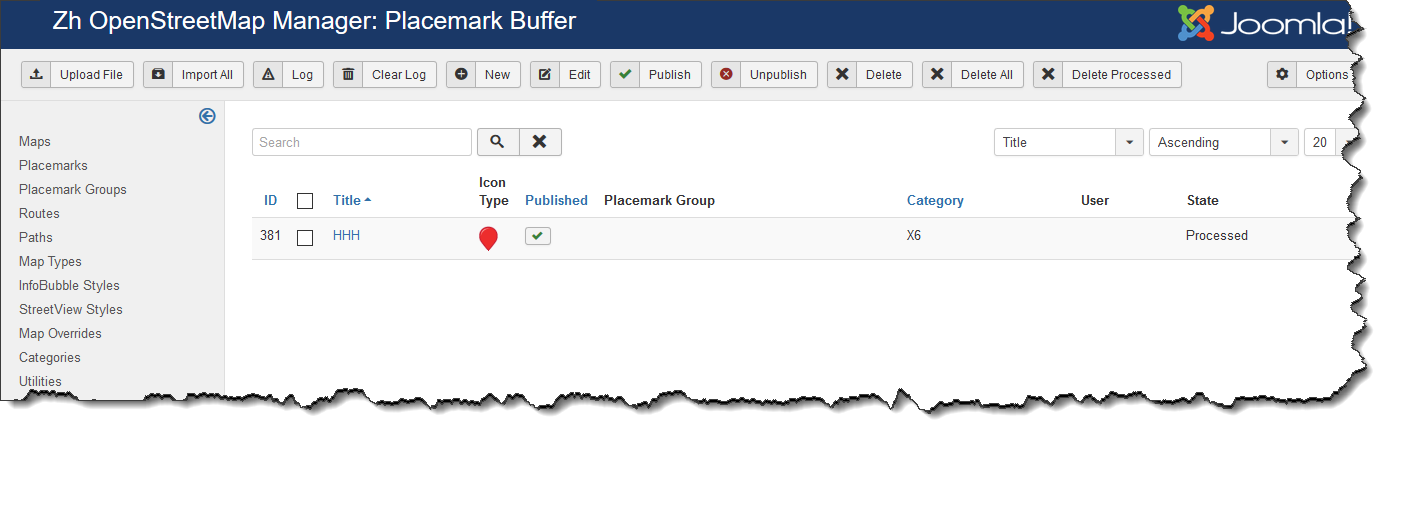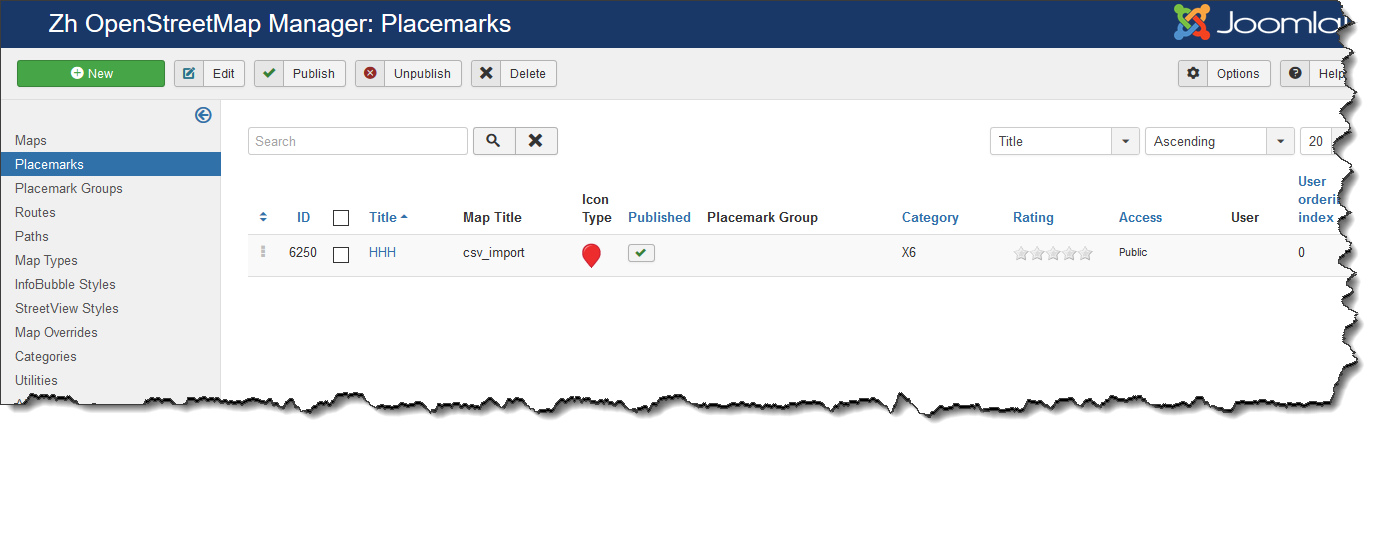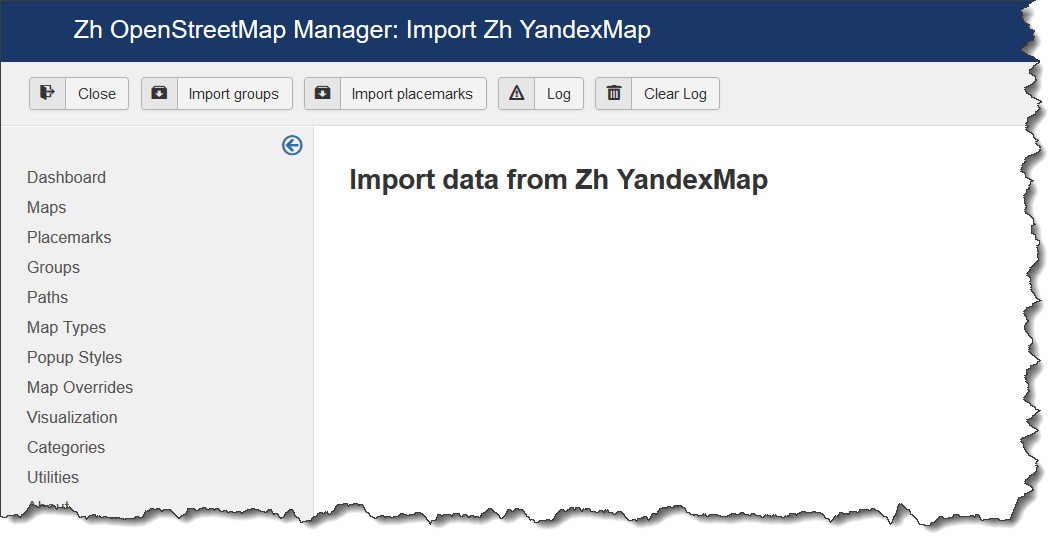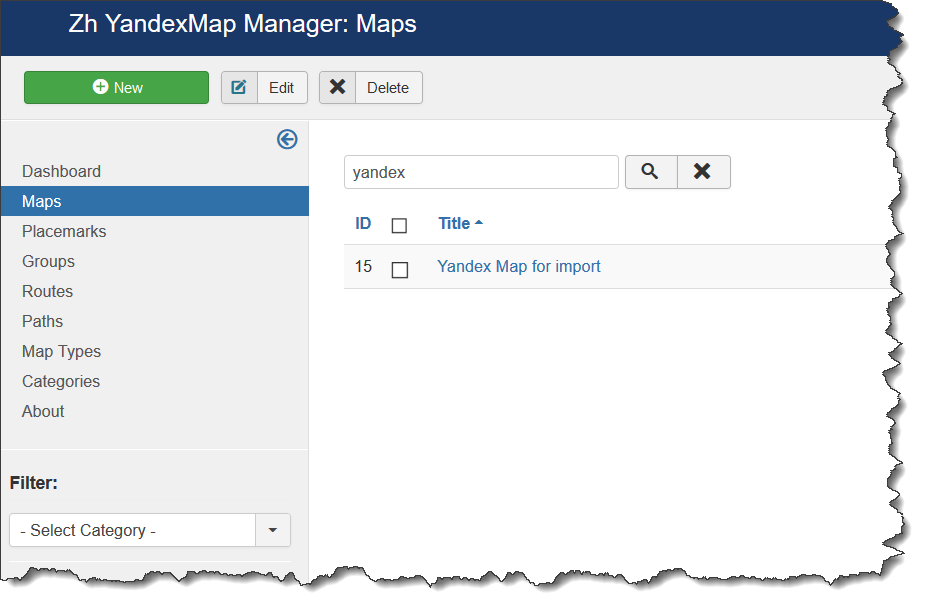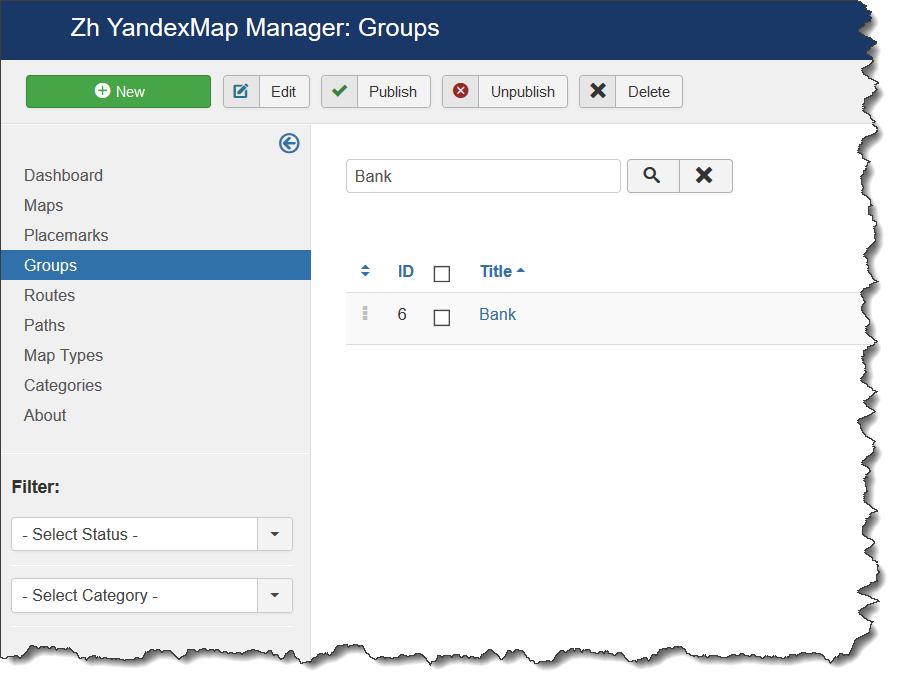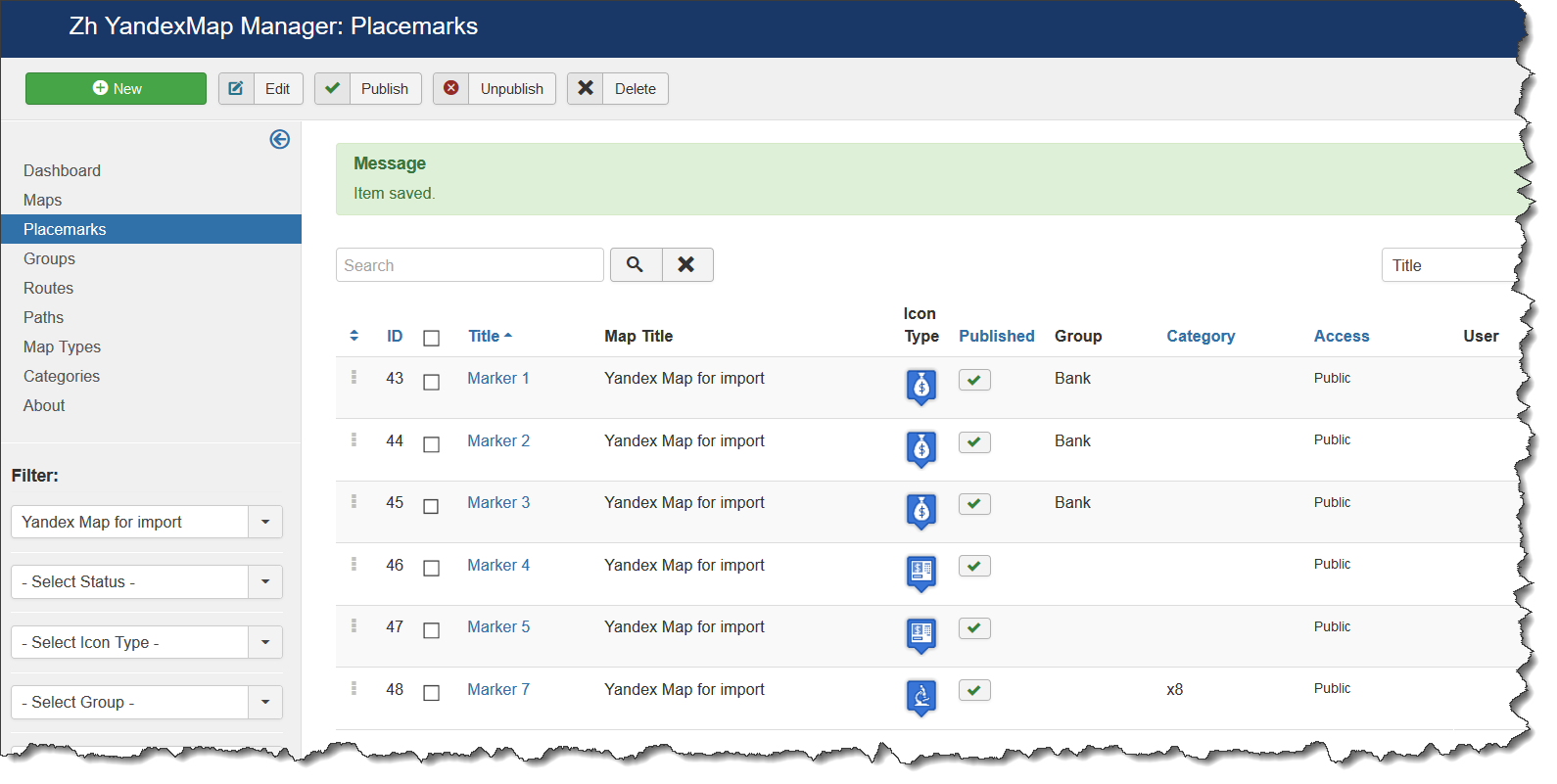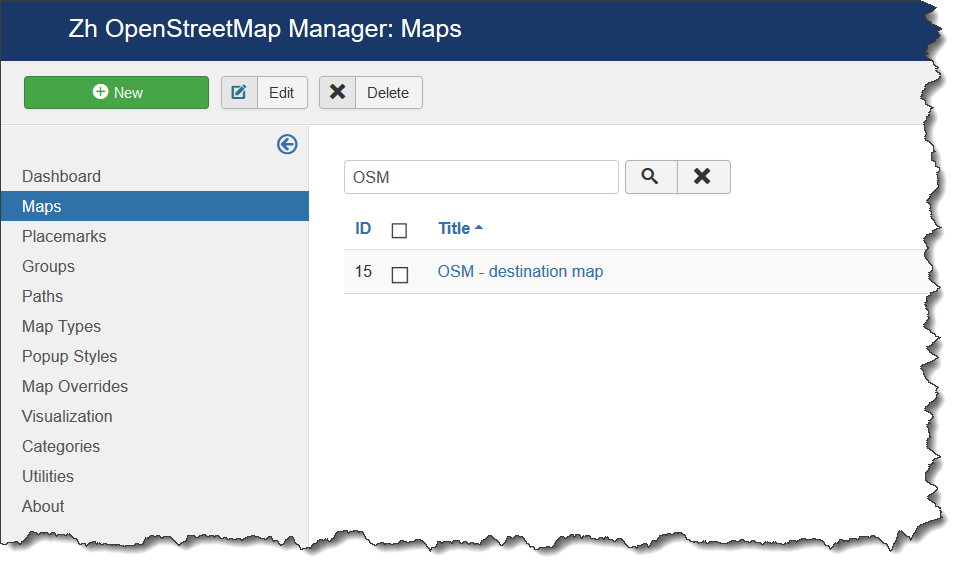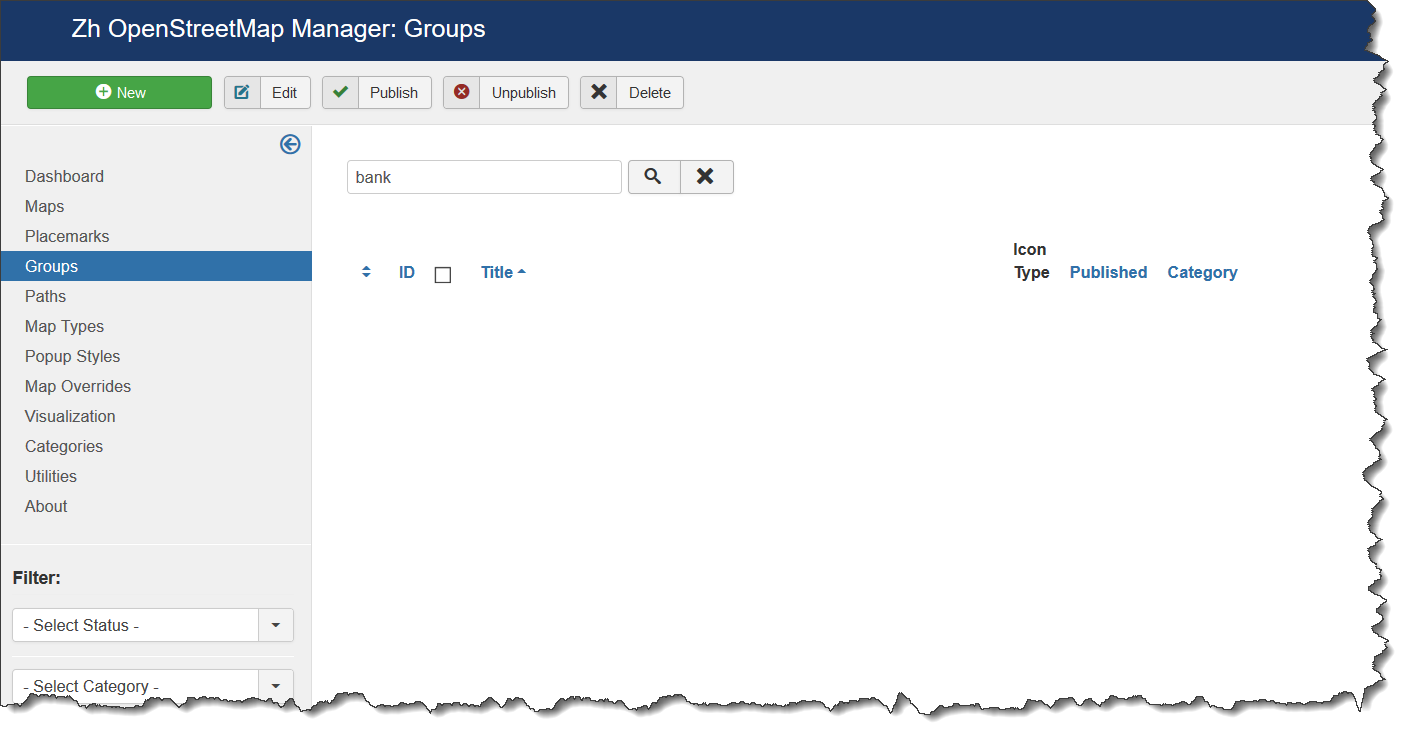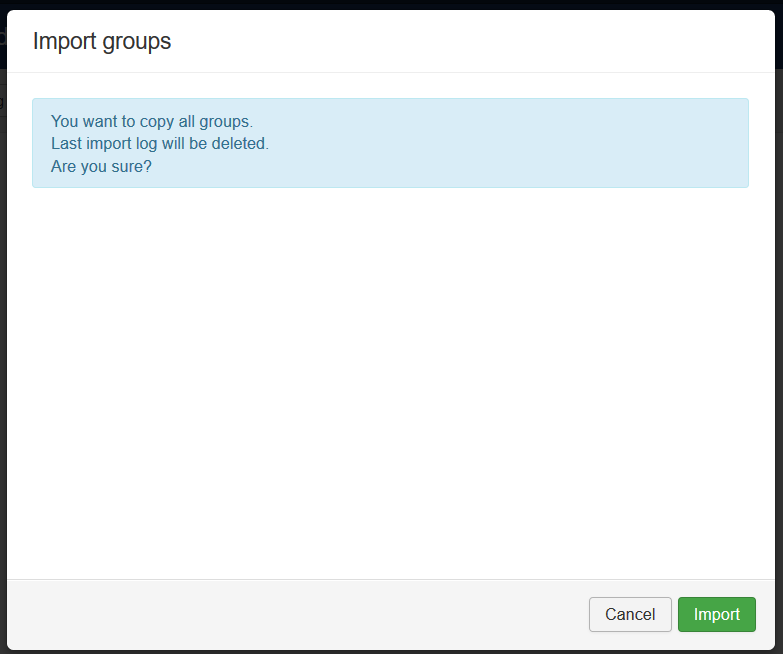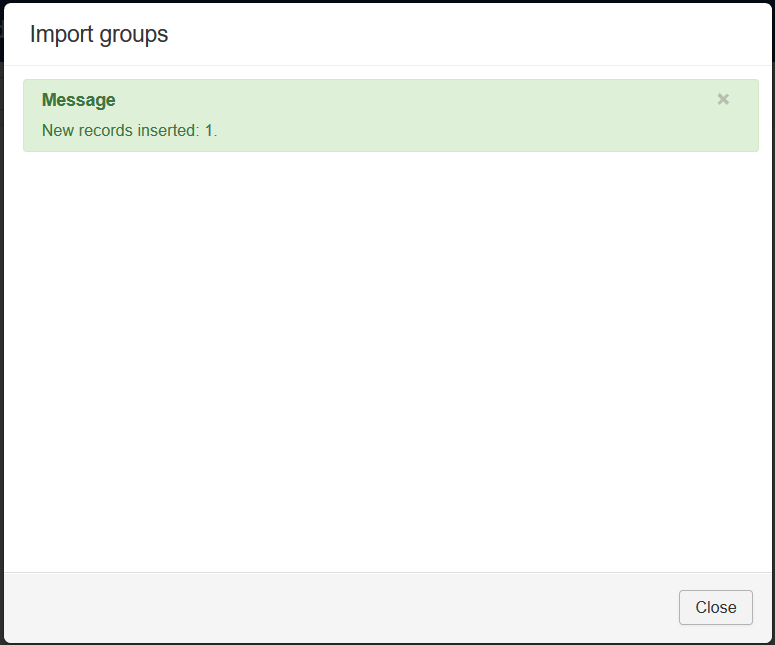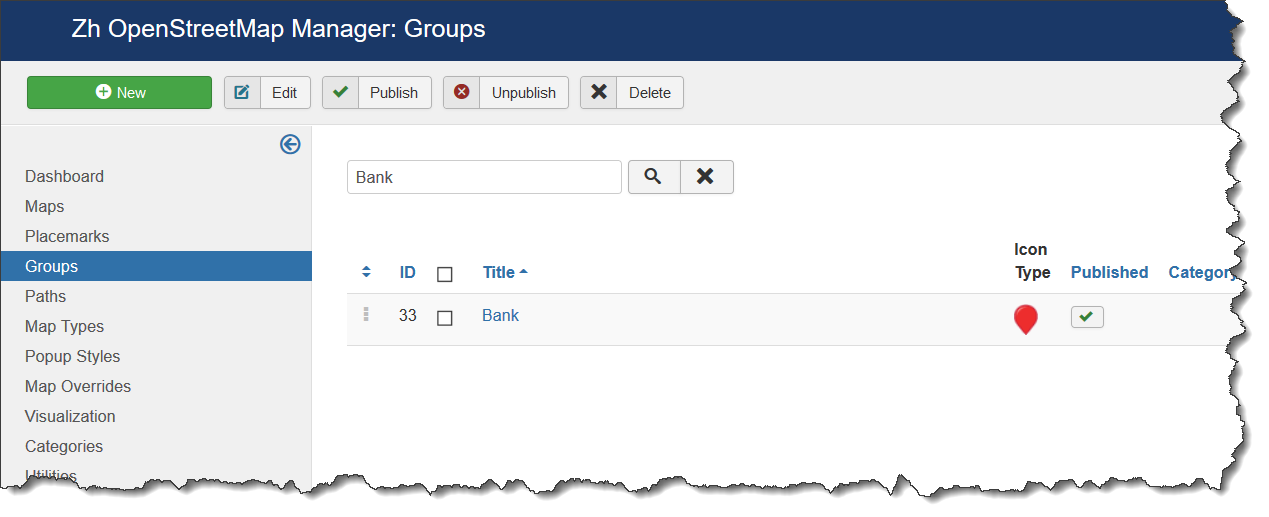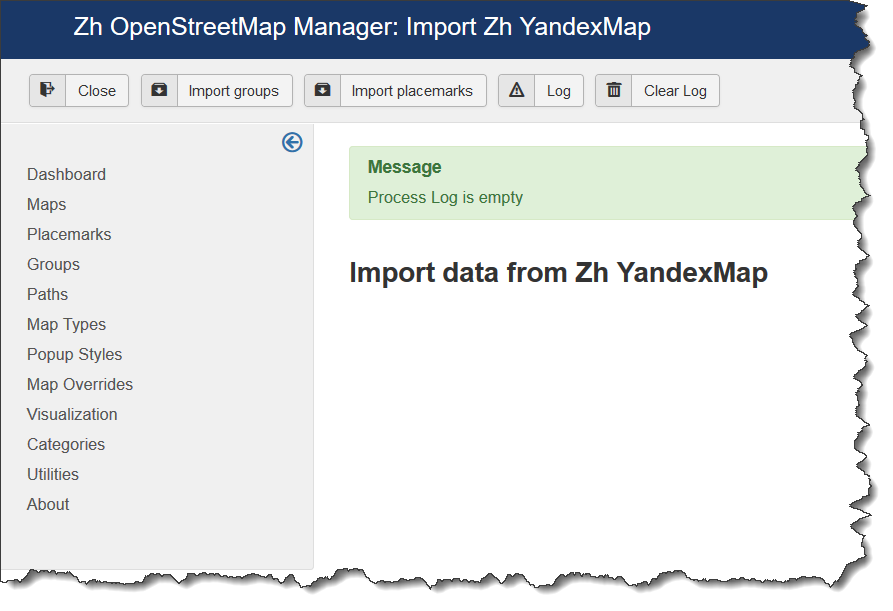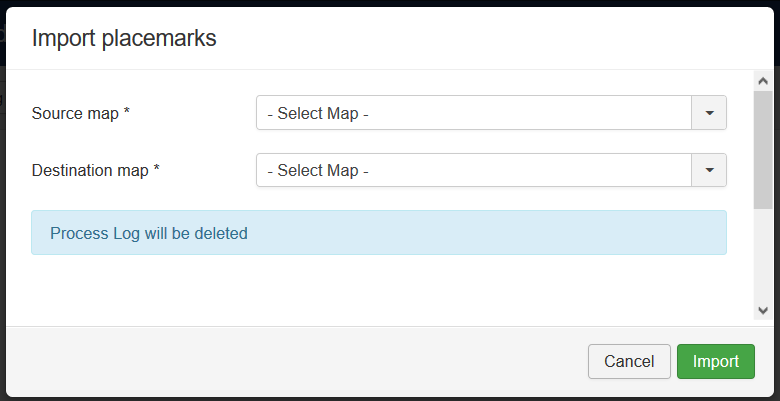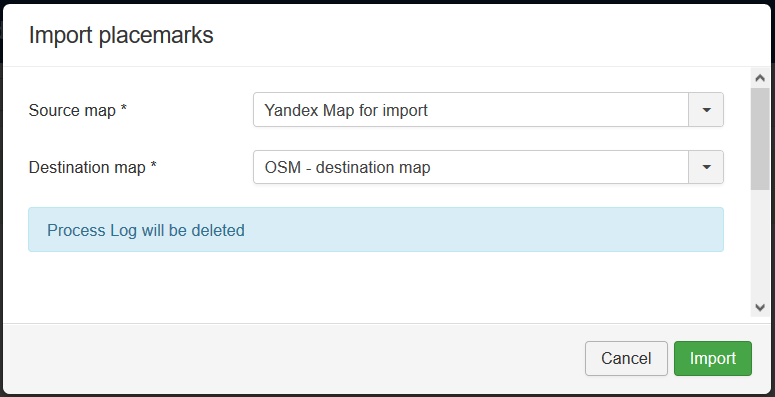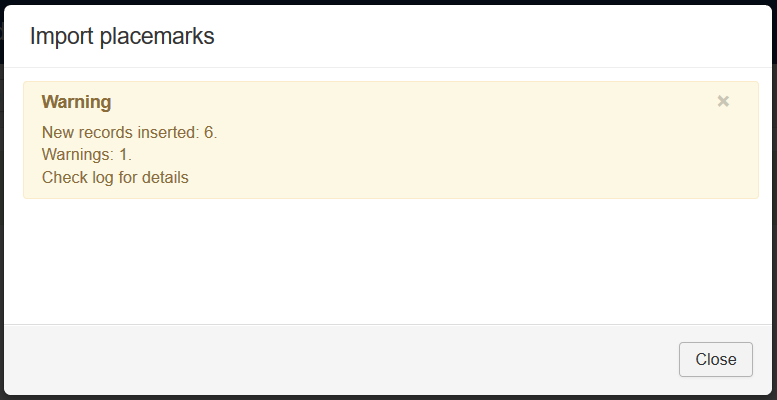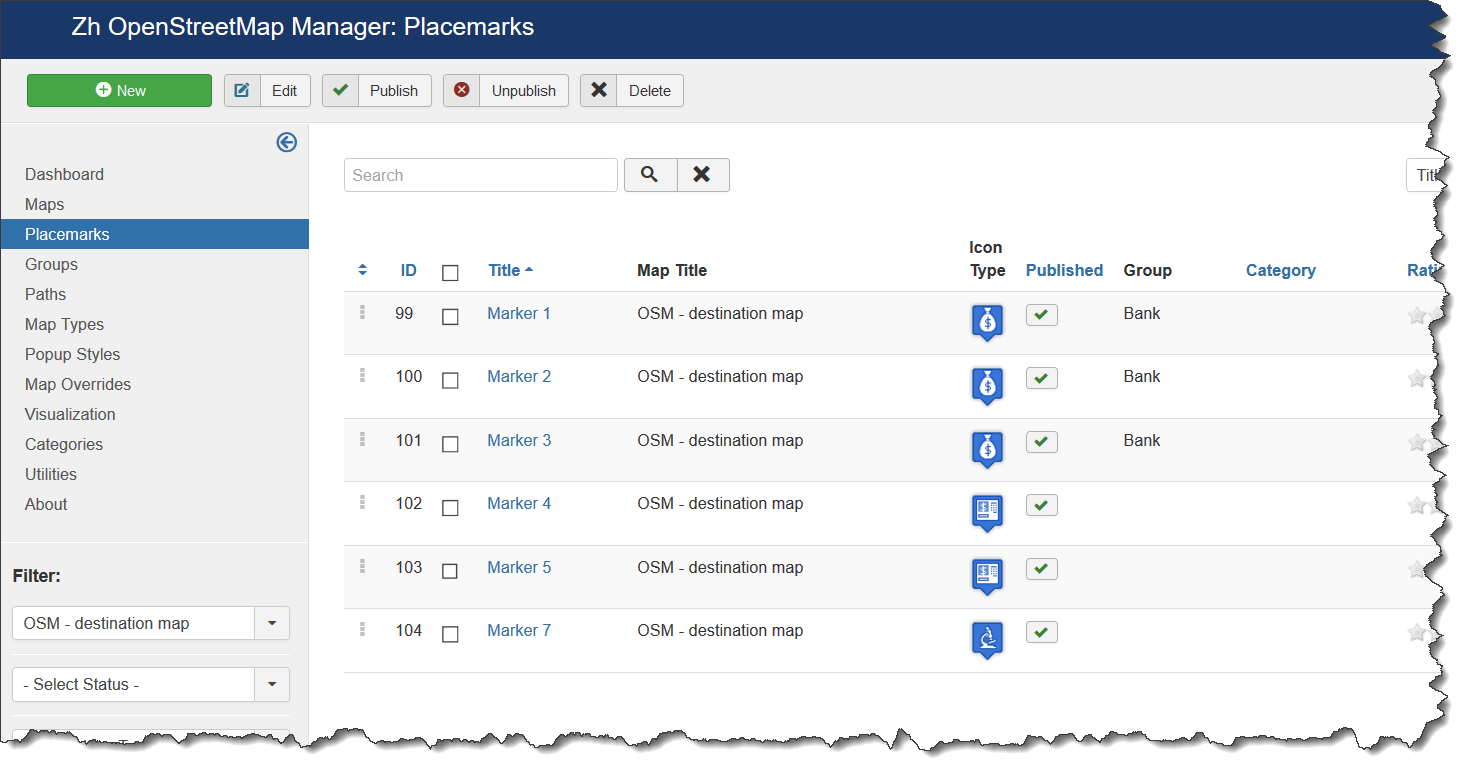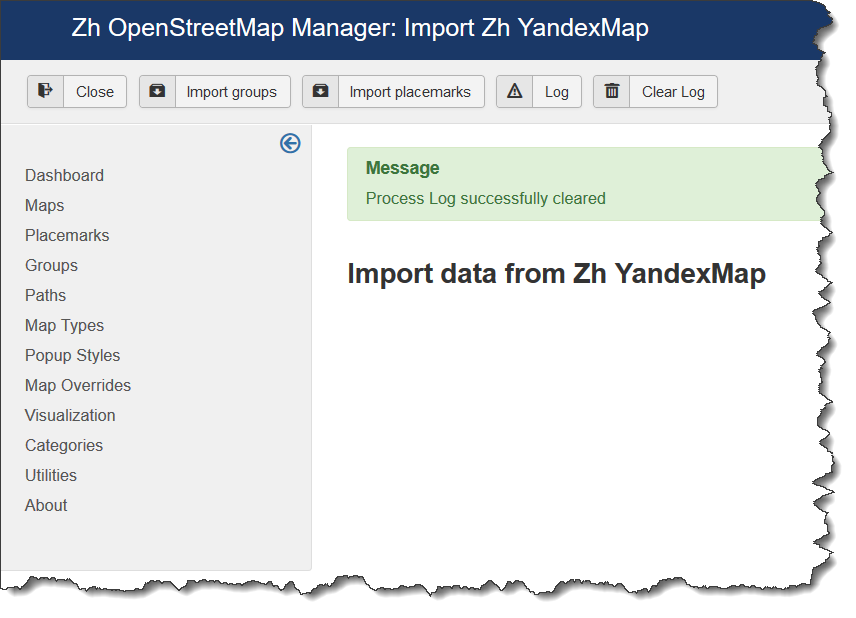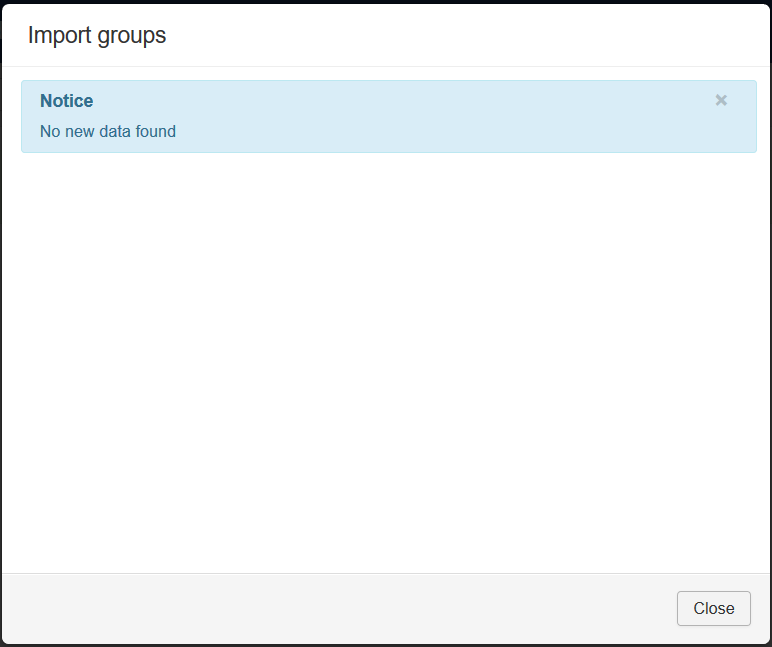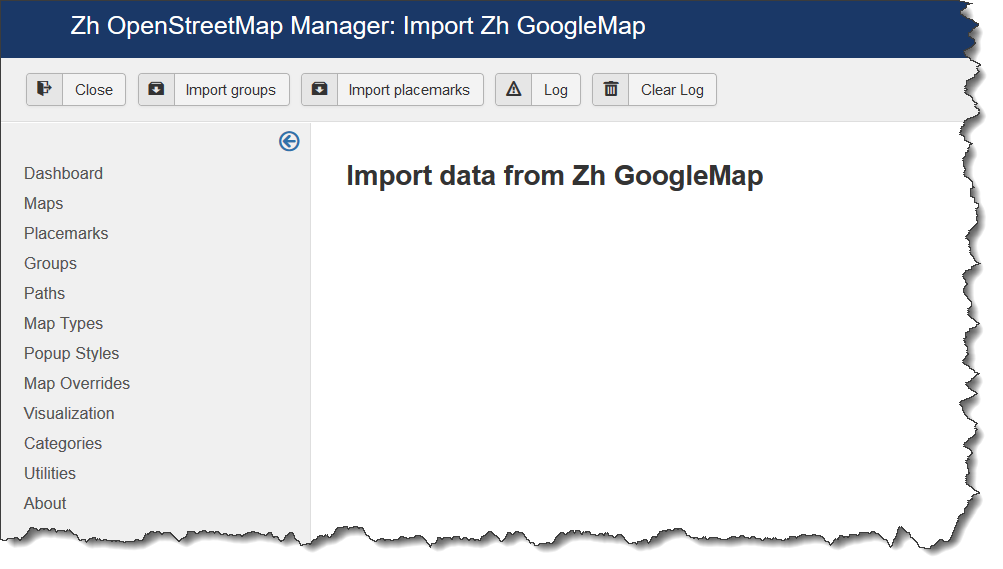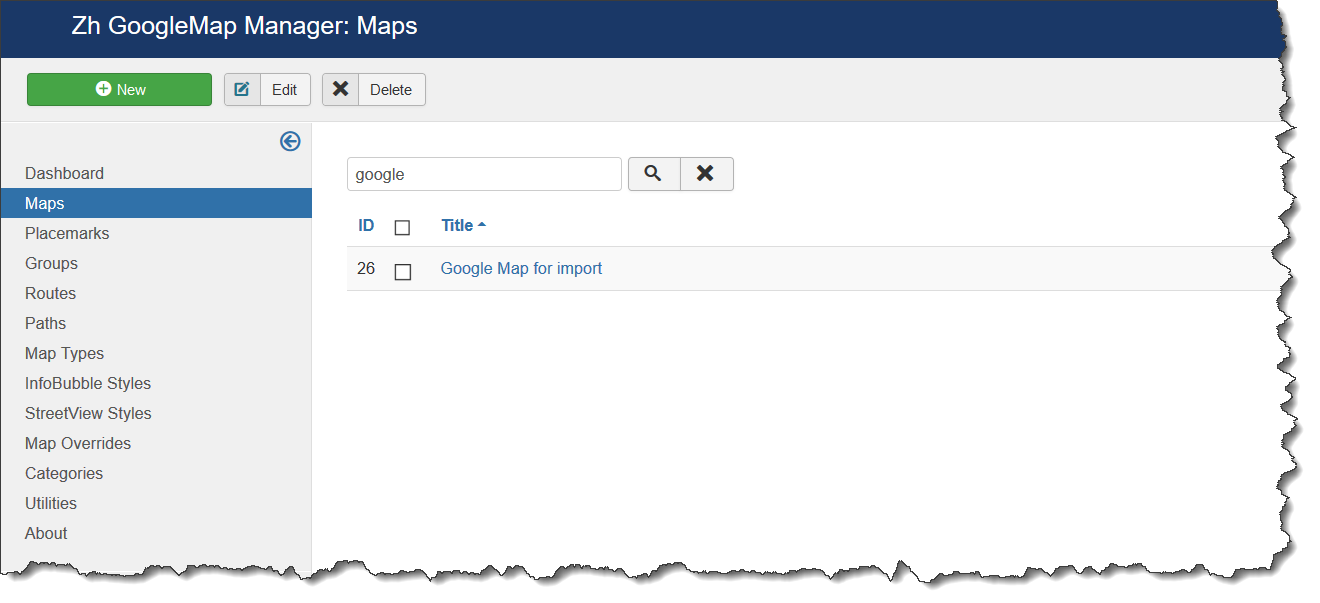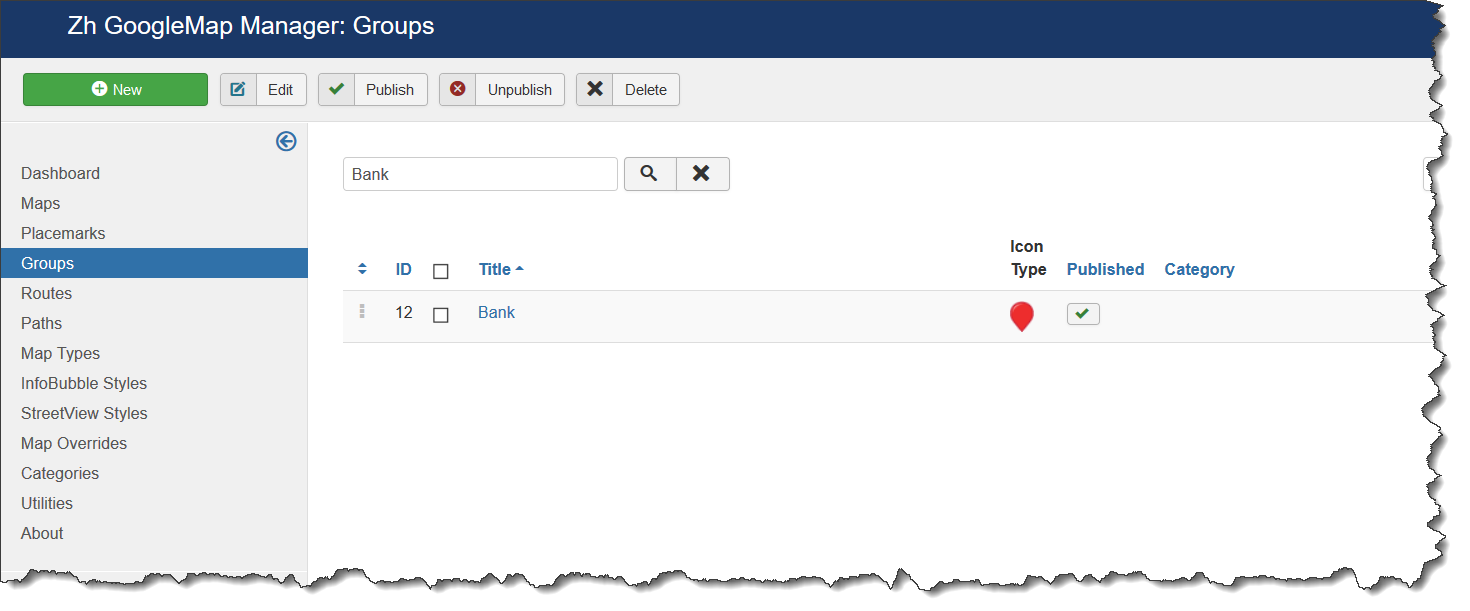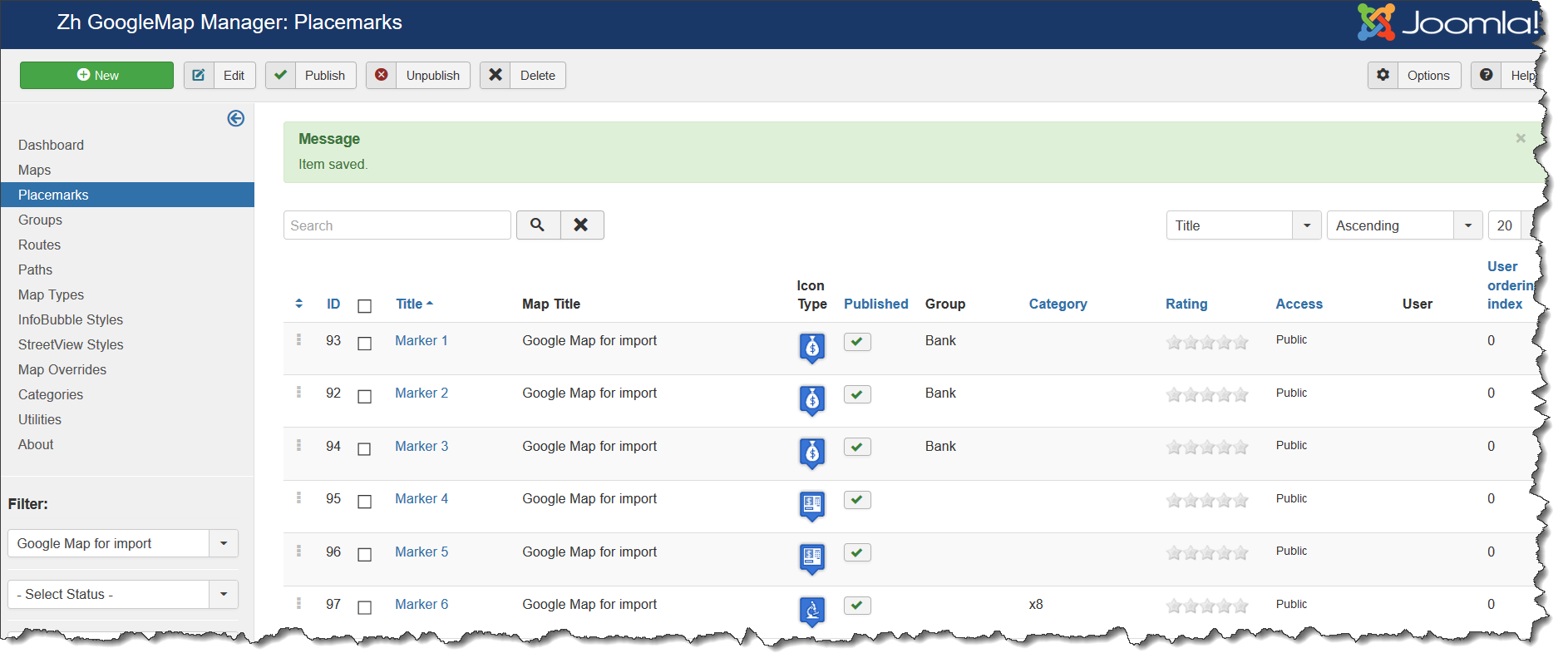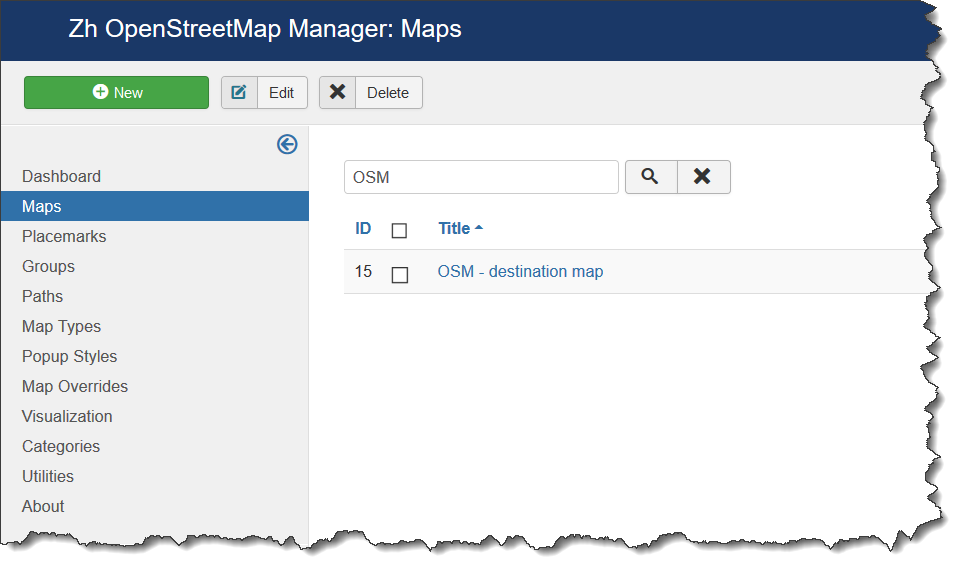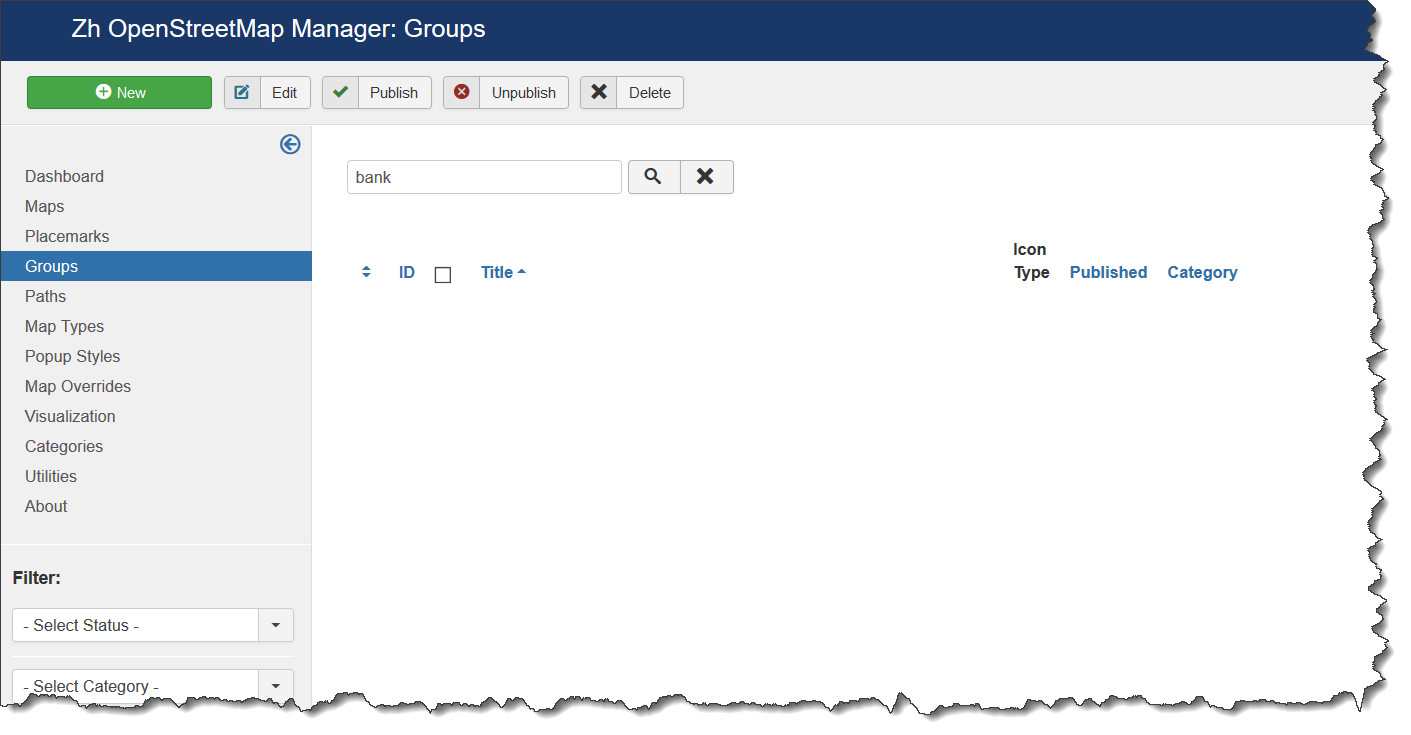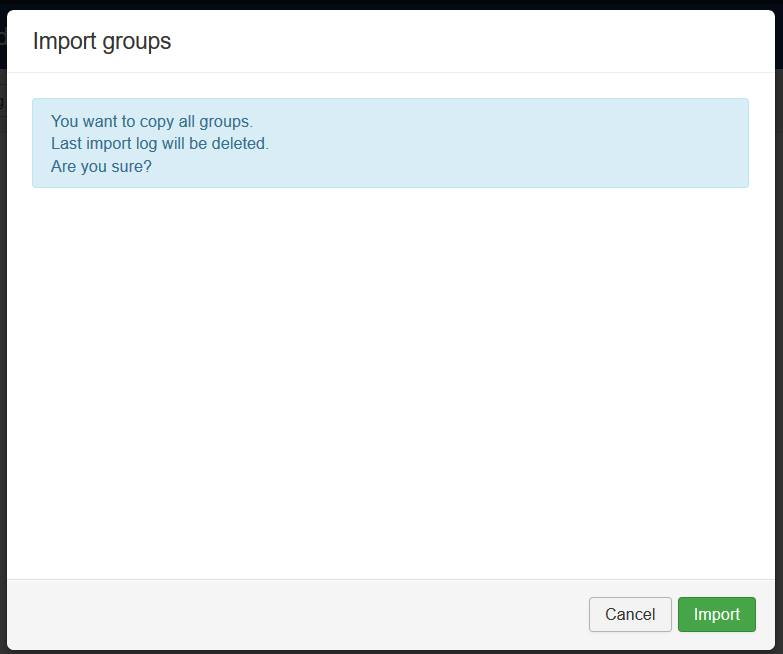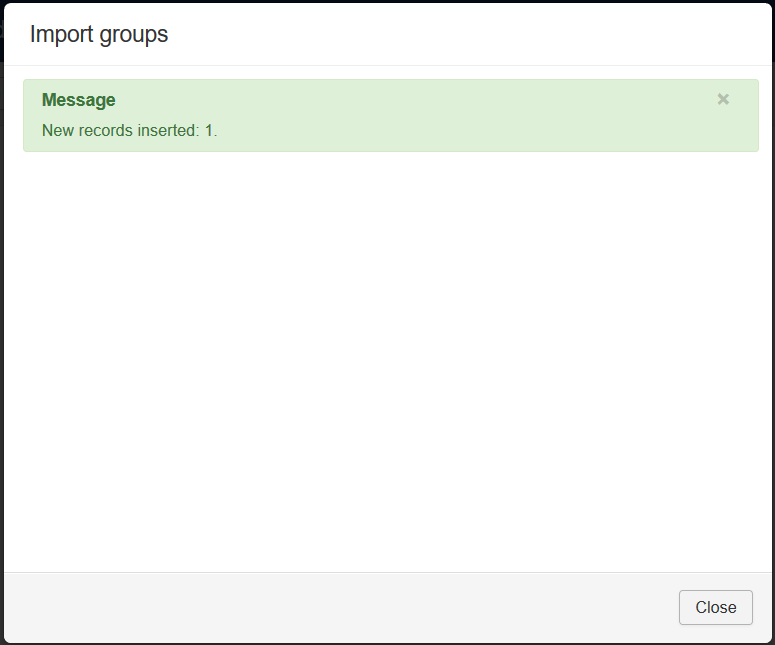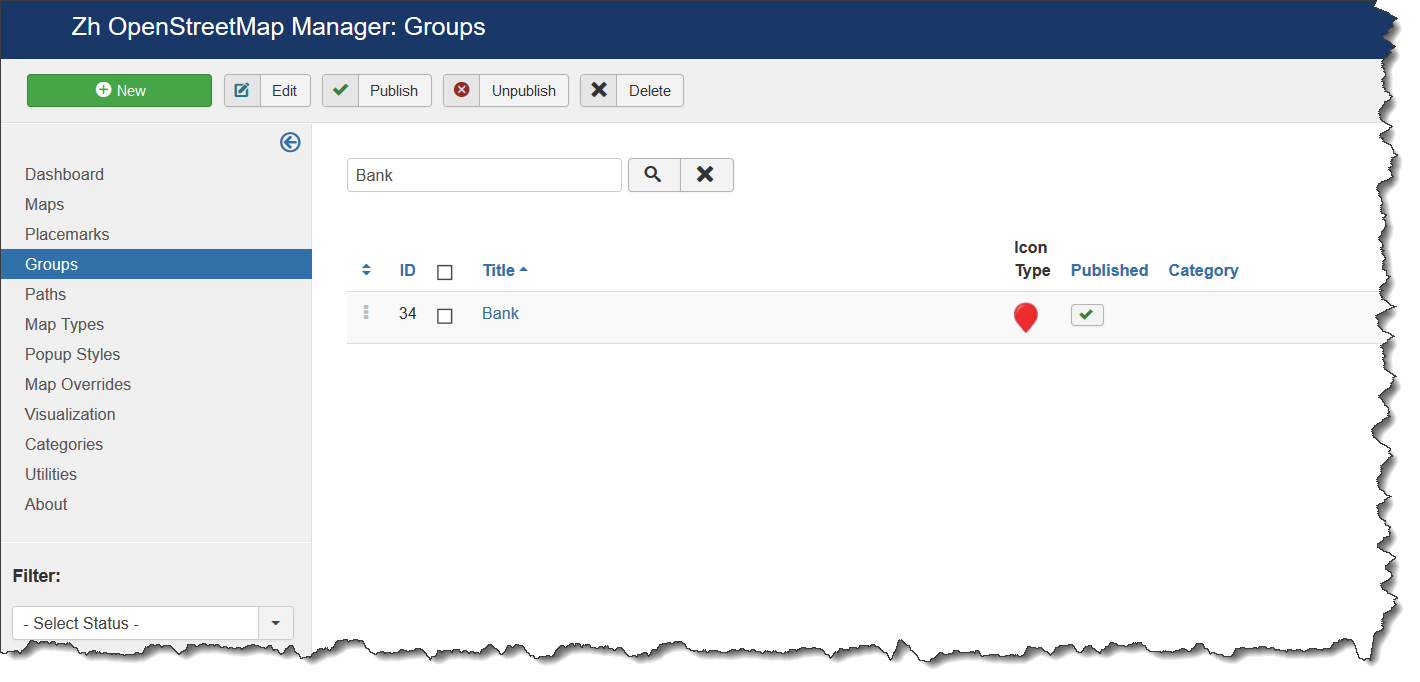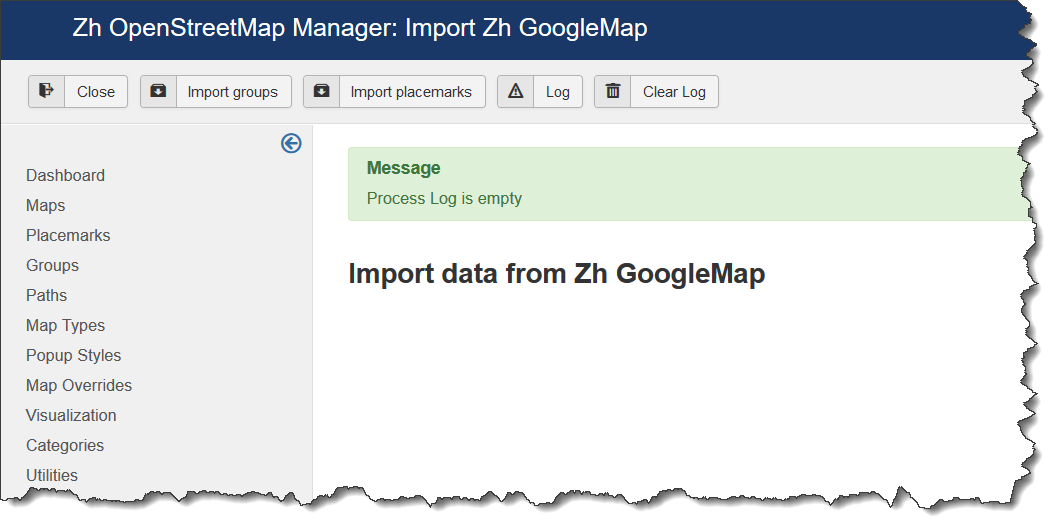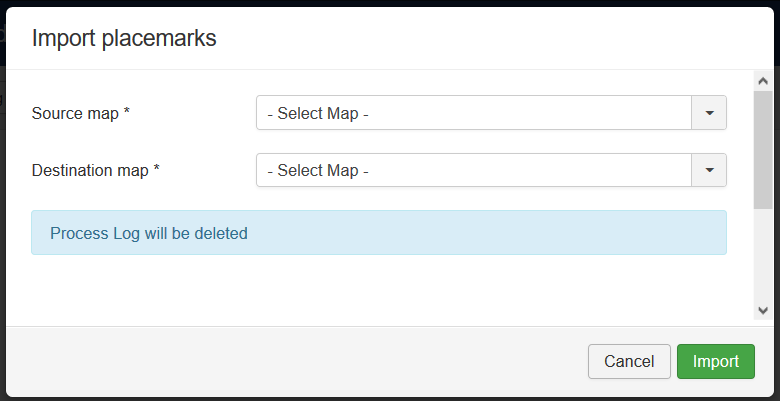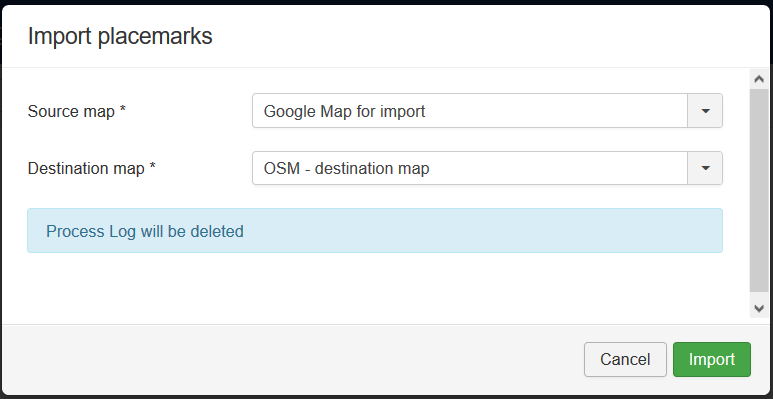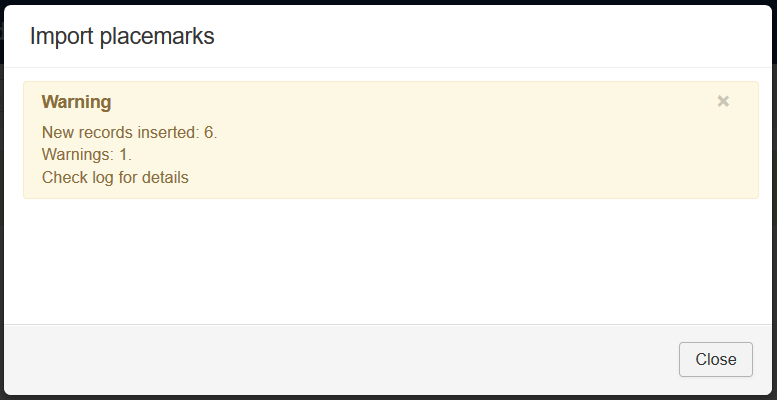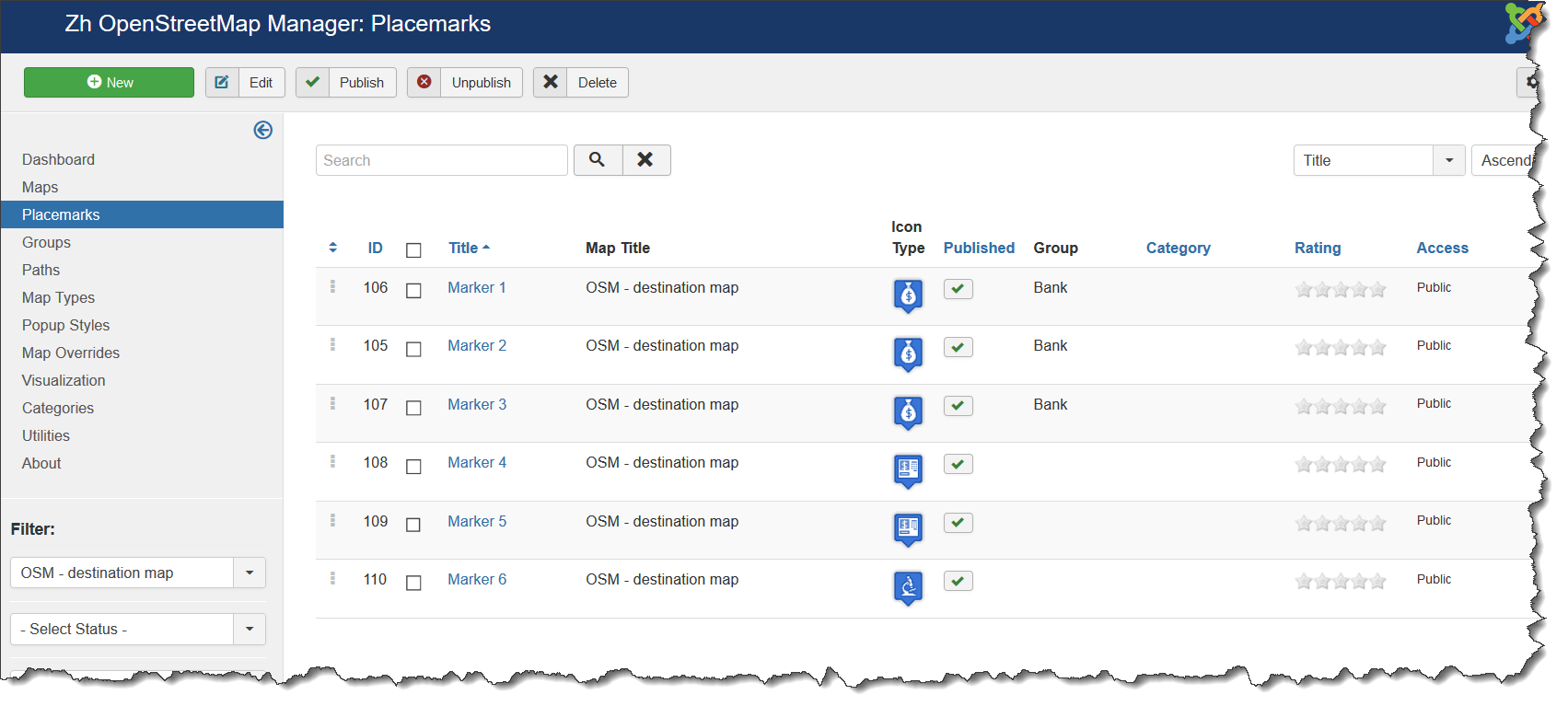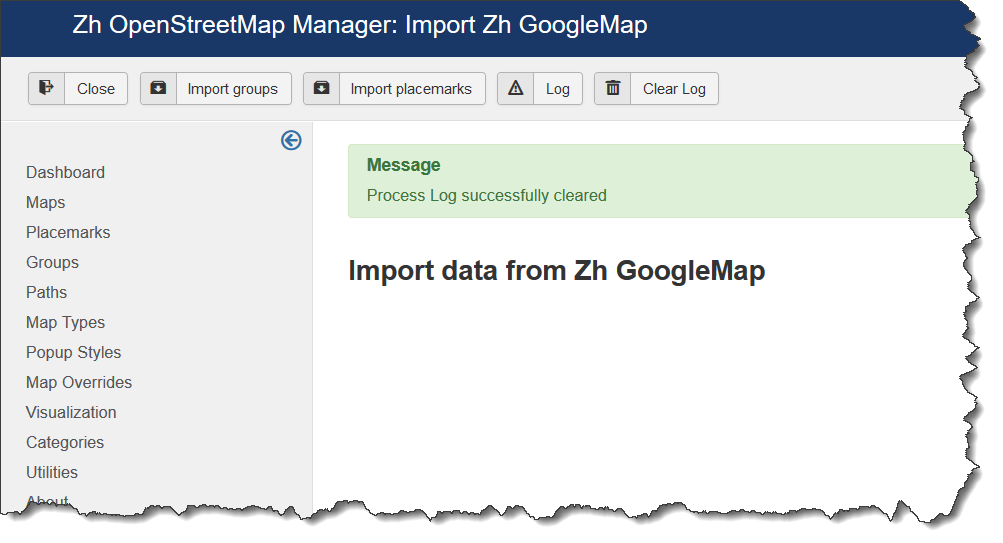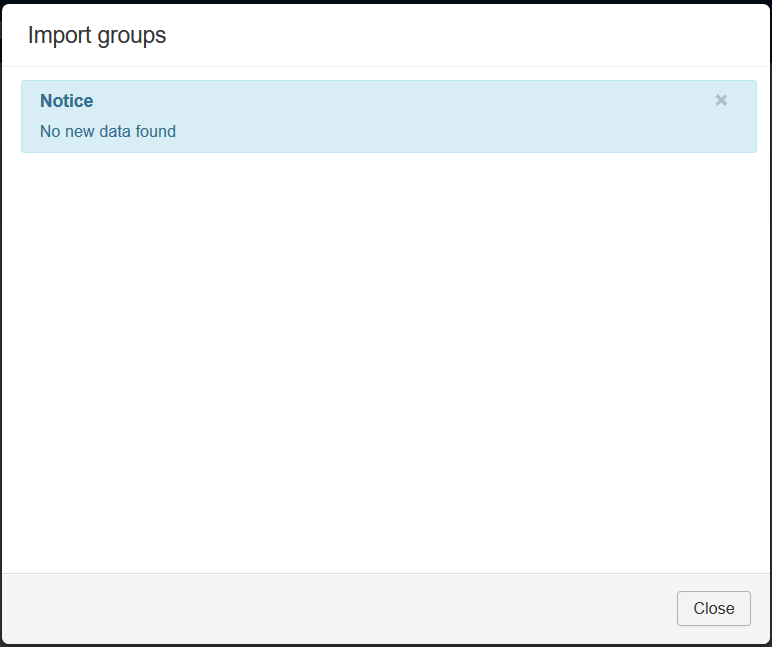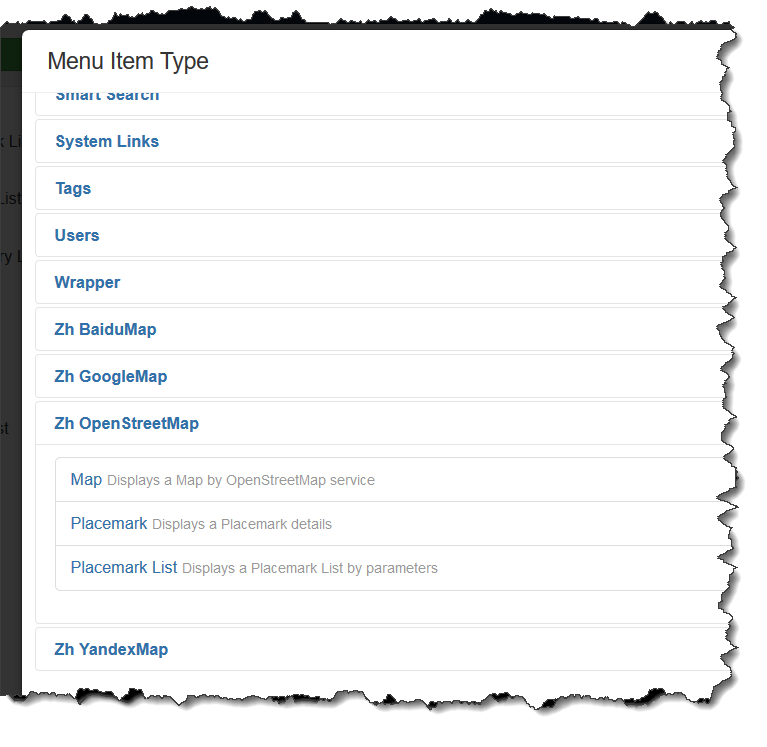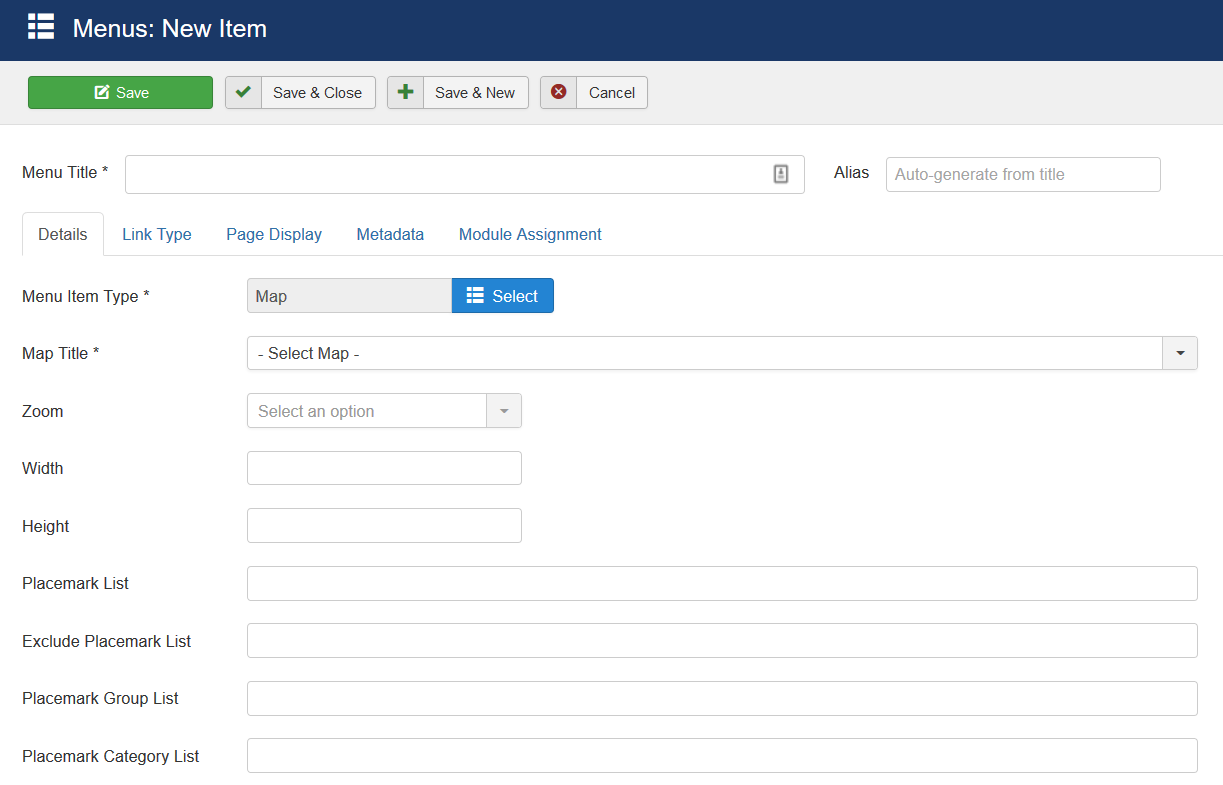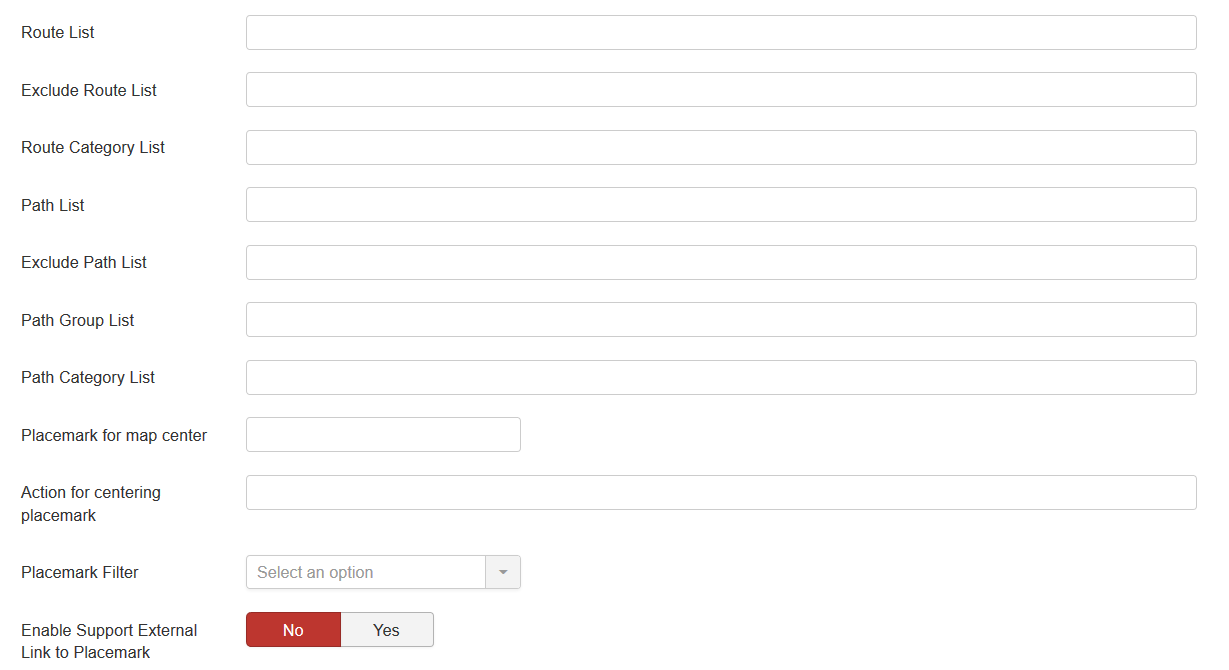Zh OpenStreetMap Description: Difference between revisions
(Created page with "{{Zh_OpenStreetMap_Description_Install}} {{Zh_OpenStreetMap_Description_Map}} {{Zh_OpenStreetMap_Description_Placemark}} {{Zh_OpenStreetMap_Description_Placemark_Group}}...") |
mNo edit summary |
||
| Line 21: | Line 21: | ||
{{Zh_OpenStreetMap_Description_InfoBubbleStyle}} | {{Zh_OpenStreetMap_Description_InfoBubbleStyle}} | ||
{{Zh_OpenStreetMap_Description_MapOverrides}} | |||
Revision as of 09:26, 10 October 2019
Installation
Component is installed on Joomla! 3.x in a standard way through the Extension Manager.
Component supports autoupdate feature
Main dashboard
Creating Map
We turn to the menu "Maps".
Enter the number of maps with the correct configuration for us.
Coordinates it is convenient to choose by dragging the marker (the value is automatically substituted in the form fields ) or by clicking the mouse on the desired location.
Map properties
| Title | Map title |
| Description | Description |
| Latitude | Map center Latitude |
| Longitude | Map center Longitude |
| Width | Map Width, if set to 0, map will be 100% wide |
| Height | Map Height if set to 0, map will be 100% height. |
Map Details
| Show Title as Placemark | Show map title as a placemark
|
| Open Popup | Open Popup for map title immediately |
| Disable AutoPan | Disable AutoPan when open popup |
| Map Bounds | Map bounds to protect navigation outside map You have to enter Latitude1,Longitude1;Latitude2,Longitude2 |
| Zoom | Initial Map Zoom |
| Min Zoom | Min Zoom for Map |
| Max Zoom | Max Zoom for Map |
| Draggable | Enable/disable Map dragging |
| Map Type | Initial Map Type
|
| OpenStreetMap Layer | The enabled/disabled state of the OpenStreetMap Layer and ability to use Map Type Control to switch to that layer |
| OpenTopoMap Layer | The enabled/disabled state of the OpenTopoMap Layer and ability to use Map Type Control to switch to that layer |
| Allow Custom Map Types | The enabled/disabled using custom map type and ability to use Map Type Control to switch to that layers |
| Custom Map Types List | List of custom map types ID for using on map, separator ; Example: 1;2;5 |
| KML Layer | URL of the KML Layer, that would be displayed on the map |
| Category | The category that this map is assigned to |
Using KML or GPX Layer
If you have KML file, you can put into accessible folder on site and fill URL in map field KML Layer.
If you want to use more than one file (or want to use GPX), you can use "featute", that path field of Paths is not required
- go to Paths list
- create path
- fill Layer options on File Layer tab
And after that new layer will be displayed
Moreover you can control its properties by path properties (in case KML or GPX layer type), or use internal parser for flexible control.
Map Header
| Header HTML-text | HTML text on top of the map |
| Show Header Separator | Show Separator after Header HTML text |
| Show Footer Separator | Show Separator before Footer HTML text |
| Footer HTML-text | HTML text on bottom of the map |
Map Controls
There are three sliders in this section
The first slider is
| Zoom Control | The enabled/disabled state of the Zoom Control |
| Scale Control | The enabled/disabled state of the Scale Control |
| Scale Control: Maximum width | Maximum width of the control in pixels. The width is set dynamically to show round values (e.g. 100, 200, 500) |
| Scale Control: metric | Whether to show the metric scale line (m/km) |
| Scale Control: imperial | Whether to show the imperial scale line (mi/ft) |
| Scale Control: update when idle | If true, the control is updated on move end, otherwise it's always up-to-date (updated on move) |
| Double Click Zoom | Enables/disables zoom and center on double click |
| Scroll Wheel Zoom | The enabled/disabled state of the scrollwheel zooming on the map |
| Hide Single Base Layer in Map Type Control | If true, the base layers in the control will be hidden when there is only one |
| Home Button | The enabled/disabled feature to reset map center and/or zoom to initial value |
| Overlay Opacity | The enabled/disabled feature to change opacity for Ground Overlays |
The second slider is
| Geocoder Control | The enabled/disabled state of the Geocoder Control |
| Collapse Geocoder | Collapse control unless hovered or clicked |
| Provider | Geocoding service used by the control to perform the actual geocoding queries |
The third slider is
| Map Type Control | Position on a map |
| Zoom Control | Position on a map |
| Scale Control | Position on a map |
| Geolocation Control | Position on a map |
| Geocoder Control | Position on a map |
| Placemark List Button | Position on a map |
| Home Button | Position on a map |
| Overlay Opacity | Position on a map |
Map Properties for Placemarks
| Placemark ordering | Order placemarks. It is useful when you show placemark list
|
| Auto-center and auto-zoom | Calculate and set zoom and map center to show all placemarks |
| Show placemarks in cluster | Create cluster for markers |
| Marker Cluster Zoom Level | Zoom Level on which Clusterer starts group markers |
| Group Placemarks in Cluster by Group Property | Create cluster for each group (and you can override cluster icon) Remember, if you use this feature (without managing markers by group list), you have to activate group in cluster (by setting Active in Group List) |
| Place overlapping placemarks on a spiral | Enable feature to show overlapped placemarks on a spiral or create special list |
| Zoom on cluster click | Zoom map to fit cluster bounds |
| Show cluster coverage | When mouse over a cluster it shows the bounds of its markers |
| Show placemark creation information | You can show information about user and date of placemark creation
|
Map Properties for Placemark List
| Width | Placemark List Width in pixels If set 0 then you've got 100% width. |
| Height | Placemark List Height in pixels |
| Position | Values
For example, <ul id="OMapsMarkerUL" style="list-style-type: none;"></ul> |
| Style | Values
|
| Background Color | Background Color Example: #EAEAEA As for gradient in my example, I've got it from internet sites. When you specify background color #E6E6E6, I add into style line background: #E6E6E6 I've got this example background: #fefcea; /* For old browsers */
background: -moz-linear-gradient(top, #fefcea, #f1da36); /* Firefox 3.6+ */
/* Chrome 1-9, Safari 4-5 */
background: -webkit-gradient(linear, left top, left bottom,
color-stop(0%,#fefcea), color-stop(100%,#f1da36));
/* Chrome 10+, Safari 5.1+ */
background: -webkit-linear-gradient(top, #fefcea, #f1da36);
background: -o-linear-gradient(top, #fefcea, #f1da36); /* Opera 11.10+ */
background: -ms-linear-gradient(top, #fefcea, #f1da36); /* IE10 */
background: linear-gradient(top, #fefcea, #f1da36); /* CSS3 */
padding: 10px;
border: 1px solid #333;
And after all this is mine code #E6E6E6; /* For old browsers */
background: -moz-linear-gradient(top, #E6E6E6, #AAAAAA); /* Firefox 3.6+ */
/* Chrome 1-9, Safari 4-5 */
background: -webkit-gradient(linear, left top, left bottom,
color-stop(0%,#E6E6E6), color-stop(100%,#AAAAAA));
/* Chrome 10+, Safari 5.1+ */
background: -webkit-linear-gradient(top, #E6E6E6, #AAAAAA);
background: -o-linear-gradient(top, #E6E6E6, #AAAAAA); /* Opera 11.10+ */
background: -ms-linear-gradient(top, #E6E6E6, #AAAAAA); /* IE10 */
background: linear-gradient(top, #E6E6E6, #AAAAAA); /* CSS3 */
padding: 10px;
border: 1px solid #333;
I note that in IE9 there is no gradient. But it is not task to do it in my component by CSS. In any case you can do it by image and applying for class. |
| Action by Click | Action to do when you Click on link
|
| Placemark List Content | Text from which placemark list contains
|
| Appearance | Appearance of placemark list
|
| Search placemark field | Enable feature to search by autocomplete placemarks in placemark list |
Groups
| Group Control | Position and type of list of group, that would be displayed for marker management
|
| Group Type | Behavior of group list
|
| Manage Placemarks | Enable ability to manage placemarks by Group List |
| Synchronize with placemark list | Show/Hide placemarks in placemark list depends on group state |
| Manage Paths | Enable ability to manage paths by Group List |
| Group ordering | Group order in list
|
| Group Column Width | Column width for the left or right position of list group |
| Show Group | Show text, icon of group in list of group
|
| Display Show All and Hide All buttons | Show buttons to show/hide all groups by one click
|
| Search group field | Display search field to find group in group list |
| Group CSS | Type of group decoration
There are two predefined style |
| Group List Title | Group List Title |
| Top Description | Description on top of the list |
| Show Top-Separator | The enabled/disabled state of Separator on top of the list |
| Show Bottom-Separator | The enabled/disabled state of Separator on botom of the list |
| Bottom Description | Description on bottom of the list |
Route
| Draggable | The enabled/disabled ability route to be draggable |
| Show Route Panel | Enable show route details |
| Travel Mode: Driving | The enabled/disabled ability to be show this travel mode |
| Travel Mode: Walking | The enabled/disabled ability to be show this travel mode |
| Travel Mode: Bicycling | The enabled/disabled ability to be show this travel mode |
| Travel Mode: Public Transit | The enabled/disabled ability to be show this travel mode |
| Unit System | Use this unit system option when create route
|
Advanced Options
| Show hover text | Show hover text for map objects (placemarks, paths) |
| Hover Popup Style | Hover Popup style |
| Display Popup Content | Display Popup Content
|
| Panel width | Panel width in pixels |
| Open Panel | Initial Panel state |
| Loading map objects dynamically | Enable feature to load placemarks by AJAX
|
| Load type | Type of loading placemarks, ie load it all, or depends on some conditions
|
| Buffer size for placemarks | You can load placemarks by parts |
| Buffer size for paths | You can load paths by parts |
| Loading content data dynamically | Enable feature to load map objects popup content by AJAX
Ie your page can contains placemark or path creation code, but all popup content can be loaded dynamically. |
| Placemark Filter | Restriction displaying placemarks on some rules. |
| Allow to user enter placemarks | Enable registered users to create and/or alter placemarks on map. |
| Insert Allowed | User can create new placemarks |
| Update Allowed | User can update existing placemarks |
| Delete Allowed | User can delete existing placemarks |
| New Placemark State | Placemark Status for created user placemark. |
| New Contact State | Contact Status for created user contact (if enabled contact integration). |
| Show Icon Type Selector for New Placemark | The enabled/disabled state of selecting Icon Type when user creates placemark. |
| CSS Class | The class name for map div tag |
| Additional CSS styles for loading | List of CSS style files for loading when map is loading, separated by new line or semicolon |
| Additional JavaScript files for loading | List of JavaScript files for loading when map is loading, separated by new line or semicolon |
| Placemark Rating | Enable Placemark rating feature.
|
| Map text override | You can use this feature to override Standard text for map controls etc by using special interface in component administration area or change some interface or map object properties |
Geolocation
| Auto Positioning | Auto Positioning when map is loading |
| Geolocation Control | Show Geolocation Control |
| Geolocation Button Style | Geolocation Button Style
|
Integration
| Use contacts | The enabled/disabled state of using contacts You can enable using contact information and associate your placemark with contact to display contact information in placemark popup. |
| Contact Details | You can enter names of attributes to show. Separator is ; Acceptable values
You can enter it in any order, and by it the contact will be shown. Note: postcode and zipcode – it is the same field, but different labels will be. Check contact fields, and you'll see this pairs: City or Suburb, State or Province, Postal / ZIP Code
to show position, contact name and mobile phone |
| Use users | The enabled/disabled state of using users You can enable using user information and associate your placemark with user to display user information in placemark popup. |
| Allow open Google Maps | Enable/disable feature to open Google Maps (link or button in placemark popup) |
| Allow open Google Maps for map center placemark | Show link, which opens Google Map for map center
|
Display
Creating Placemark
We turn to the menu "Placemarks".
Enter the number of markers bound to a specific map.
Coordinates it is convenient to choose by dragging the marker (the value is automatically substituted in the form fields ) or by clicking the mouse on the desired location.
Placemark properties
| Title | Placemark Title |
| Description | Description |
| Tags | Tags |
| Latitude | Latitude |
| Longitude | Longitude |
| Address | Text address of your placemark |
| Map Title | Title of the map, where marker would be displayed |
Placemark Details
| Published | Published |
| Group | Group |
| Protected from user correction | Protected placemark from user correction, when you activate creating users placemark |
| Include in Placemark List | Include placemark in Placemark List |
| Category | The category that this placemark is assigned to |
| User ordering index | Use this field to manual sorting placemarks in placemark list |
| Rating | Rating of placemark, it can be set only by rating system |
| Show GPS information | Show GPS information (coordinates) in popup |
| Addition HTML text | HTML text, that will be included in placemark popup content Be careful, if you enter email address, the other Joomla! plugin it changed, and there will be an error and map will not be shown. |
| Placemark full description | Placemark description (HTML text) in placemark detail view (single placemark page view) |
| Hover HTML text | Hover HTML text for placemark when enabled hovering feature |
Appearance properties
| Marker | Marker Type
|
| Icon Type | Icon Type |
| Icon X-offset | Icon offset |
| Icon Y-offset | Icon offset |
| Open Popup | Execute action which described in Action by Click and Zoom by Click |
| Popup Content | Content of Popup
|
| Action by Click | Action by Click on this placemark
|
| Zoom by Click | Zoom by Click on this placemark You can change zoom when you click on marker
|
| Popup Style | Popup style |
| URL Site | Site URL to display in placemark popup |
| Site Name | Site Name to display instead of URL |
| URL Image | Image URL to display in placemark |
| URL Image Thumbnail | Image URL to display in placemark list |
| Start Publishing | Placemark start publishing date |
| Finish Publishing | Placemark finish publishing date |
| Date of creation | Placemark creation date |
| Access | ACL access level to view this placemark |
Marker with Label
| Label Class | Label CSS Class |
| Label X-offset | Label offset |
| Label Y-offset | Label offset |
| Label content | HTML label content |
Popup Tabs
| Add Popup content | Add Popup content into popup
|
| Title | Tab Title |
| Image | You can use image to build image gallery in single placemark view |
| HTML Text | Tab text |
Integration
| Prepare Content | Run other plugins for popup content |
| Show open Google Maps | Show link or toolbar button, which opens Google Maps
|
| Show Tags | Show tags in popup content
|
| Tag Style | User which associate with placemark
|
| User | User which associate with placemark |
| Show user prompts | Type of view user information
|
| Contact | Contact which associate with placemark |
| Show contact prompts | Type of view contact information
|
| Contact Button in Popup toolbar | Show Contact Button in Popup toolbar |
| Alternative Contact URL | You can alternative URL to show contact page (instead of standard joomla's call) |
| Placemark details Button in Popup toolbar | Show Placemark Button in Popup toolbar |
| Alternative Details URL | You can alternative URL to show details page (instead of standard call detail placemark view) |
| Placemark Details for standard call | You can override default details attributes for detail view
By default placemark detail page is opened without enabling additional loading bootstrap library and styles, without thumbnail and image gallery, without Additional HTML text and full text description. You can change default behavior by passing parameters, separated by comma (,)
For example, if you enter image gallery,addition html text,full description into field, the detail view for placemark will be with two additional description (short "Addition HTML text" and full "Placemark full description"), and image gallery will be displayed too |
| Article | Article which associate with placemark |
| Article Button in Popup toolbar | Show Article Button in Popup toolbar |
| Alternative Article URL | You can alternative URL to show article page (instead of standard joomla's call) |
| iframe tag Article CSS | You can apply CSS style for iframe tag (when use article in popup content) |
Hidden Attributes for Customization
For your convenience you can also change the labels of the fields by joomla overrides
COM_ZHOSMMAP_MAPMARKER_DETAIL_ATTRIBUTE1_LABEL COM_ZHOSMMAP_MAPMARKER_DETAIL_ATTRIBUTE2_LABEL … COM_ZHOSMMAP_MAPMARKER_DETAIL_ATTRIBUTE9_LABEL
For example, you can enter some data into this fields.
In table columns have names
attribute1 attribute2 ... attribute9
You can use this fields, for example, for integration with other systems or etc.
Display
Placemark Customization
Copy your marker images (format PNG) in the directory
/administrator/components/com_zhosmmap/assets/icons/
Component will automatically pick up the picture when choosing the type of marker.
The only requirement - the file name use English letters and can't contain any special character; the file extension have to be a .png ie in lower case, because names of images stored in a database without the extension, and it is appended in the output.
Don't forget about Compatibility Mode for Resource Files
Grouping
The marker may be included in one group, for this to specify a marker belonging to the group. If the field of markers grouping is set (field value Group Control is different from No), then starts an additional feature: a list of active groups (the location is determined by this same field, with the first four (left, top, right, bottom) correspond to the table form of representation, while the two latter (Group-Map, Map-Group) - based on the div, and you have the opportunity to do anything with them.
The map also has a drop-down list Group CSS - which implements the following functionality:
- the first two styles - predefined
- the third - you can override it in your CSS file template
- while in three cases, just have three different names of objects, respectively, we can change the styles they like.
The following names
for the div-tag ID takes the value
- OMapsMenu-advanced
- OMapsMenu-simple
- OMapsMenu-external
for ul-tag
- zhom-menu-advanced
- zhom-menu-simple
- zhom-menu-external
Accordingly, styles, prescribes for them. Field Show Group Icon is used to display icons in the list of groups.
Creating Group
We turn to the menu "Groups".
Enter the number of groups.
Group properties
| Title | Group Title |
| Description | Description |
| Published | Published |
| Icon Type | Icon Type |
| Icon X-offset | Icon offset |
| Icon Y-offset | Icon offset |
| Override Placemark Icon | Change icon of placemark to group icon |
| Override Cluster Icon | Change icon of cluster when you create cluster for each group |
| Active in Group List | Set Group state to active (show markers) when page displayed. This parameter uses in two cases: show markers in different clusters, or show markers and set active group in group list (when use marker managing by group list). It also can be used for managing paths by group list. |
| Min Zoom for Marker Manager | Zoom from which placemarks would be displayed by Marker Manager |
| Max Zoom for Marker Manager | Zoom after which placemarks wouldn't be displayed by Marker Manager |
| Category | The category that this group is assigned to |
| User ordering index | Use this field to manual sorting groups in group list |
Display
Creating Path
The path means polylines, polygons, circles or special map objects (layers).
We turn to the menu "Paths".
Enter the necessary number of paths with reference to a specific map.
Field Path - a set of coordinates of points, the coordinates (Latitude, Longitude) are separated by comma (,), the points themselves - separated by a semicolon (;)
Coordinates it is convenient to choose by dragging the marker (values are substituted into the reference field in the form Current coordinates, from there you can copy and add a separator and value in the field Path), or clicking the mouse on the desired location.
Path properties
| Title | Path Title |
| Description | Description |
| Path | Path for example: 59.92335689062723,30.385787878185525;59.92374467628344,30.387547407299284 |
| Visualization Data Source | Data source for visualization
See also Zh OpenStreetMap Visualization |
| Object Type | Map object type
|
| Map Title | Title of the map, where path would be displayed |
| Current coordinates | Current coordinates |
Path Details
| Published | Published |
| Geodesic line | Create Geodesic line (circle-shaped) |
| Weight | Line Weight |
| Color | Line Color for example: #FF0000 |
| Opacity | Opacity, number value between 0.0 and 1.0 |
| Fill Color | Fill Color (for rectangles, circles) for example: #FF0000 |
| Fill Opacity | Fill Opacity, number value between 0.0 and 1.0 |
| Hover Color | Hover Color for example: #FF0000 |
| Hover Fill Color | Hover Fill Color (for rectangles, circles) for example: #FF0000 |
| Radius | Circle radius in meters |
| Group | Group, it can be used for managing by Group List |
| Category | The category that this path is assigned to |
| Addition HTML text | HTML text, that will be included in path popup content Be careful, if you enter email address, the other Joomla! plugin it changed, and there will be an error and map will not be shown. |
| Hover HTML text | HTML text, that will be included in path hover popup content Be careful, if you enter email address, the other Joomla! plugin it changed, and there will be an error and map will not be shown. |
Label
You can show label in path center
| Show Label | Show Label
|
| Label Class | Label CSS Class |
| Label Style | Label CSS style without style word |
| Label X-offset | Label horizontal offset |
| Label Y-offset | Label vertical offset |
| Label content | HTML label text Be careful, if you enter email address, the other Joomla! plugin it changed, and there will be an error and map will not be shown. |
Advanced options
| Popup Content | Popup Content
|
| Action by Click | Action when you click on path
|
| URL Site | Site URL to display in path popup content |
| Site Name | Site Name to display instead of URL |
File Layer
| Layer Type | Layer Type
See also Internal parser |
| URL | URL or file path of the File Layer, that would be displayed on the map |
| Layer Show Type | Map bounds for fitting the KML layer
|
| Suppress Popup | Suppress open Popup when you click on layer |
| Popup content for Placemark | Popup content
|
| Popup content for Polyline | Popup content
|
| Popup content for Polygon | Popup content
|
| Tooltip content for Polyline | Tooltip content
|
| Tooltip content for Polygon | Tooltip content
|
| Override Placemarks | Override placemark properties for placemarks, created from file. You can assign group to path and set override icon for placemark in group properties |
Ground Overlay
| Image URL | URL for ground overlay image |
| Image bounds on map | Latitude1,Longitude1;Latitude2,Longitude2 |
| Opacity | Value between 0 and 1 |
| Opacity management | Change opacity by Opacity Control |
| Clickable | Enable/disable click on layer |
Grid Layer
| Create Tile Function | Create Tile function has one parameter (coords), which contains: coord.x, coords.y and coords.z |
| Opacity | Value between 0 and 1 |
Display
Creating Map Type
The map type means a custom map type for getting tiles.
We turn to the menu "Map Types"
Enter the necessary number of map types.
Map Type
| Title | Map Type Title |
| Description | Description |
| Min Zoom | Min Map Zoom (for which exists tiles) |
| Max Zoom | Max Map Zoom (for which exists tiles) |
| URL template | URL template for getting map tiles, for example, for OpenStreetMap type it is https://{s}.tile.openstreetmap.org/{z}/{x}/{y}.png |
| Layer Type | Type of map layer
|
| Map type attribution | Attribution of map type, ie license, copyright... |
Map Type Details
| Tile Width | Tile Width |
| Tile Height | Tile Height |
| Get Tile URL function | Implementation of function to get tile URL if you don't use URL template |
| Opacity | Opacity |
| Opacity management | Change opacity by Opacity Control |
| Published | Published |
| Category | The category that this map type is assigned to |
Display
Creating Popup Style
We turn to the menu "Popup Styles".
Popup Style Details
| Title | Popup Style Title |
| Description | Description |
| Min Width | Min width of the popup, in pixels |
| Max Width | Max width of the popup, in pixels |
| Min Height of tab content | Set it if you want to set initial height of tab content, in pixels |
| Max Height | If set, creates a scrollable container of the given height inside a popup if its content exceeds it, in pixels |
| Disable Auto Pan | Set it if you don't want the map to do panning animation to fit the opened popup |
| Published | Published |
| Category | The category that this popup style is assigned to |
Display
Creating Map Override
This feature can help you to override static text for map objects or change its behaviour (or properties).
You can define override and use it for map by assign in map details
Override
| Title | Map Override Title |
| Description | Description |
| Published | Published |
| Category | The category that this override is assigned to |
Map
| Invalidate Map Size Container Selector | jQuery selector to find container where map div is located in case you need to redraw map. For example when your map is not on an active tab and when you click to show it your map is displayed incorrectly For example #sppb-tab1-2 |
| Invalidate Map Size Container Index | In some cases you can access to tab only by index. Index starts with 0 |
| Invalidate Type | How often invalidate map container
|
Placemark
| Popup Style | Default Popup Style for all popups |
| Date of creation format | Date and time format for placemark date of creation. Use PHP DateTime format For example jS F Y g:i a |
Placemarks
| Cluster list Content Template | Template for cluster list content You can create your own cluster list item template Go to /components/com_zhosmmap/templates/placemarks/cluster_list Create your own php file with your own code. Default.php file is default template. You can copy its code and change to your own After that your new template will be in this list |
Placemark List
In this section you can define text for placemark list objects.
| Button title | Placemark list button title |
| Button tooltip text | Placemark list button tooltip text |
| Placeholder text: Search | You can override text Search in placemark list search field |
| Autocomplete search type | Search type in case of using autocomplete feature
|
| Character mapping type | Character mapping in case of entering search string in placemark search field with wrong keyboard layout
|
| Synonym applying side | Source, where synonym will be applied.
|
| Synonyms - accents, diacritical marks and so on | Synonyms, each pair separated by comma or semicolon, in pair values separated by colon. Enter values only for lower case or if it has different symbols. Example é:e; è:e; ê:e |
| Character Mapping | Character mapping for wrong keyboard layout, each pair separated by comma or semicolon, in pair values separated by colon. Enter values only for lower case or if it has different symbols. Example q:й; w:ц; e:у; r:к; t:е; y;н But for different symbols for letter in different case `:ё; ~:Ё |
Group List
| Placeholder text: Search | You can override text Search in placemark list search field |
| Autocomplete search type | Search type in case of using autocomplete feature
|
| Character mapping type | Character mapping in case of entering search string in placemark search field with wrong keyboard layout
|
| Synonym applying side | Source, where synonym will be applied.
|
| Synonyms - accents, diacritical marks and so on | Synonyms, each pair separated by comma or semicolon, in pair values separated by colon. Enter values only for lower case or if it has different symbols. Example é:e; è:e; ê:e |
| Character Mapping | Character mapping for wrong keyboard layout, each pair separated by comma or semicolon, in pair values separated by colon. Enter values only for lower case or if it has different symbols. Example q:й; w:ц; e:у; r:к; t:е; y;н But for different symbols for letter in different case `:ё; ~:Ё |
| Button tooltip text | Tooltip text for panel button |
| Details tab title | Title for placemark details tab in panel |
| List tab title | Title for placemark list tab in panel |
| Route tab title | Title for route tab in panel |
| Groups tab title | Title for groups tab in panel |
Integration
| Open Google Maps title | Change title for link or toolbar button to open Google Maps |
| Geocoder placeholder text | Placeholder text for text input |
| Geocoder error message | Message when no result found or geocoding error occurs |
Display
Creating Category
You can go to the menu "Categories" and add categories to the component.
Then you can walk on the map objects and tag them by category.
On the basis of categories can be further in any way extend the functionality of the component
Utilities
Import CSV
Select Import CSV to upload placemark definition by CSV file.
Each line of file - one placemark definition.
First line of file - column name list.
Keep in mind - values can't contain delimiter. For example, if your placemark HTML description can contain colon, use semicolon as delimiter (and don't use it in this description).
Main process screen
You can see table of placemark buffer.
All import process has next steps
- upload CSV file in buffer
- check data, edit it
- import data to placemark table
- analyze log
- correct processed placemarks with warnings
- delete processed data in from buffer
You can see buttons in toolbar
- Upload File - upload CSV file
- Import All - import data
- Log - show process log
- Clear Log - delete data from process log
- New - create simple placemark definition (for example, for test purposes)
- Edit - edit record in buffer (for example, for fixing errors and upload again)
- Publish and Unpublish - you can change buffer placemark status
- Delete - delete record from buffer
- Delete All - delete all records from buffer
- Delete Processed - delete all records from buffer in state Processed
When you upload file all records have state New
Press Upload File
Select file to upload.
Check and if you need - change Delimiter
You can set some defaults - if in file there is no value (not defined or empty value), you can apply default.
After loading you'll get upload log, it is not stored, only showed
Records can be rejected, if you not define required values. You can see record number (to edit line and upload it)
Records will not be uploaded if your first line doesn't contain column definition.
If you enter wrong colunm name, this column will not processed.
Next column names can be used
| title | required | Placemark title |
| latitude | required | Latitude |
| longitude | required | Longitude |
| published | optional | Placemark status, values 0 or 1 |
| addresstext | optional | Text address |
| icontype | optional | Icon Type |
| iconofsetx | optional | Icon X-offset |
| iconofsety | optional | Icon Y-offset |
| description | optional | Description |
| descriptionhtml | optional | Addition HTML text. All HTML formatted text in one line, line breaks are not allowed. |
| hrefimage | optional | URL Image |
| catid | optional | Category ID |
| markergroup | optional | Group ID |
| createdbyuser | optional | User ID, which associate with placemark |
| showuser | optional | Show user prompts, one integer value Type of view user information
|
| showgps | optional | Show GPS information
|
| preparecontent | optional | Prepare the content with the Joomla Content Plugins
|
| markercontent | optional | Popup Content
|
You can enter columns in any order, ie order of column names define order of placemark properties
If you want to import placemarks with definite status, you can change it in list or by buttons Publish or Unpublish.
By pressing Import All you start to import placemarks into working table.
You have to select map, to whic imported placemarks will be belong.
And press Import button.
In this case process log will be cleared and import process will start.
All placemarks with New state will be taken to process.
If some required values is not defined - will be rejected and state will be set to Error
In case of processing placemark has the same title with the other placemark, belonging the destination map, this processing placemark will not be imported, and state of it will be set to Skiped. You can't import placemark with same title.
Change title, change status to New and process again. Or import to the other map.
The process result screen
Imported placemarks in buffer change status to Processed
For demo purposes I uploaded placemark data with incorrect category ID, ie I set category ID which is not exists in categories.
In this case you can't see in buffer list category value, but it exists. The same for group ID.
If you will edit placemark in buffer - incorrect values will be set to 0 and data will be imported without category.
But if you enter into CSV file categories (or groups), which are not exists, and try to import - you'll get warnings and imported placemarks will be without it.
In future this checks will be available not only on import stage.
In case of warnings - if you need to have placemarks belonging to category or group you can delete imported placemarks and do
- recreate file with correct IDs, upload it
- remove incorrect ID and upload it with defaults
- remove incorrect column with values and upload it with defaults
After that import again
If there is no any placemarks in buffer with state New and you try to process it (to import placemarks), you'll get message that no data to process
When you processed buffer you can delete processed placemarks by pressing Delete Processed
You can also can delete records by applying filters, selecting records and pressing Delete button.
You can delete all records from buffer by button Delete All
When you got warnings, you can analyze it by checking process log. It is stored in database until next import, therefore you can analyze it any times.
As described above, one record was imported with warnings, lets check this warning to understand log
Press Log
There are 6 columns with common title
- ID - record log ID, just sequence
- Import object - what object is processed, in our case it is Placemark
- Error type - type of error, in my case I tried to load wrong category, value is Category not found
- Target ID - it is ID of my imported object (placemark). In my case new imported placemark has ID 6248. Check images below.
- Source ID - it is ID of object in buffer (placemark). In my case placemark in buffer has ID 374. Check images below.
- Source Reference Object ID - it is ID of object, which is not assigned due to is doesn't exist. In my case I tried to set placemark category ID to 778. Check images below.
In other words, I tries to import placemark with category ID=778. But category with this ID is not exist. Therefore placemark was imported without category.
Source placemark to import (in buffer) has ID=374
New imported placemark has ID=6248
Images for log description
Source placemark (in buffer) with wrong value for category
Target placemark, to which category is not applied
Categories
Sorce placemark (in buffer) with correct category
Result imported placemark with correct category
My test file is
title;description;latitude;longitude;catid;descriptionhtml Hello;Some my text;59.91790658791312;30.394283583638412;778;<b>Hello</b> world<br />Here some HTML text HHH;;59.92354196553846;30.38381223964427;45
Import Zh YandexMap
If extension is not installed - buttons for this extension is disabled.
Today you can:
- import data from Zh YandexMap extension
- import Groups
- import Placemarks
- check log for last import process
In future will be added
- pre-import check (exists categories, groups and tags)
- import tags for placemarks
Due to complex process creation of category - automatic creation of categories is not supported. Only check.
For correct process execution do not import data parallelly, ie in different windows (tabs). Just do it in one precess.
Data loading by Addition rule, it is not update exist data.
It means:
- group will be the same if it has THE SAME TITLE
- category will be the same if it has THE SAME PATH, ie it alias and aliases of all its parents are the same
- placemark will be the same if it has THE SAME TITLE and BELONGS to the destination MAP
If you close browser on middle of process - you can continue loading (but save log before new process).
When you start to continue import process - the same map objects will be skipped and you'll get only new data.
When process is done you'll get statistics window
Here main screen
Toolbar buttons:
- Close - close and return to Utilities
- Import groups - automatic load groups
- Import placemarks - automatic load placemarks
- Log - check process log
- Clear Log - clear process log
Lets check how it works
For example we have
I created map in Zh YandexMap
New group
New category
I created placemarks assigned to group and category, and without it
Go to Zh OpenStreetMap
Create map
As you can see group Bank doesn't exist
And category doesn't exist too.
For correct loading placemarks you need to have groups and categories in extension. If it doesn't exist you'll get warnings in process log.
You can automatically load groups, but categories - no. You need to add it manually.
In next steps we will load groups and placemarks. And we will get placemarks with groups but without categories (I didn't enter it).
Go to import screen
Press Import groups
Press Import button
You can see we import our group
and result
check our log
it is empty
Lets import placemarks
Press Import placemarks
Select our source and destination maps
Press Import button
You can see we import our placemarks
It means we loaded 6 placemarks and had some warnings
and result
As you can see placemarks have group attribute
Check log
Log is common log for import
You can see 5 fields, lets explain on our example, import placemarks with category, which doesn't exist:
- Import object - which map object will be process, in our case Placemark.
- Error type - what error is occured, in our case Category not found. Check images with data for details above.
- Target ID - distination object ID, in our case new placemark ID (ID = 104). Check images with data for details above.
- Source ID - source object ID, in our case placemark ID (ID = 48) from source extension. Check images with data for details above.
- Source Reference Object ID - reference object ID (category ID = 14), which is not exist in destination extension.
As you can see our problem is occurred for placemark Marker 7, which has in source extension (Zh YandexMap) ID = 48 and assigned to category x8 with ID = 14
I can clear log by press Clear Log or it will automatically be cleared by next precess
Lets try to import groups again
As you can see there is no any data to load
Import Zh GoogleMap
If extension is not installed - buttons for this extension is disabled.
Today you can:
- import data from Zh GoogleMap extension
- import Groups
- import Placemarks
- check log for last import process
In future will be added
- pre-import check (exists categories, groups and tags)
- import tags for placemarks
Due to complex process creation of category - automatic creation of categories is not supported. Only check.
For correct process execution do not import data parallelly, ie in different windows (tabs). Just do it in one precess.
Data loading by Addition rule, it is not update exist data.
It means:
- group will be the same if it has THE SAME TITLE
- category will be the same if it has THE SAME PATH, ie it alias and aliases of all its parents are the same
- placemark will be the same if it has THE SAME TITLE and BELONGS to the destination MAP
If you close browser on middle of process - you can continue loading (but save log before new process).
When you start to continue import process - the same map objects will be skipped and you'll get only new data.
When process is done you'll get statistics window
Here main screen
Toolbar buttons:
- Close - close and return to Utilities
- Import groups - automatic load groups
- Import placemarks - automatic load placemarks
- Log - check process log
- Clear Log - clear process log
Lets check how it works
For example we have
I created map in Zh GoogleMap
New group
New category
I created placemarks assigned to group and category, and without it
Go to Zh OpenStreetMap
Create map
As you can see group Bank doesn't exist
And category doesn't exist too.
For correct loading placemarks you need to have groups and categories in extension. If it doesn't exist you'll get warnings in process log.
You can automatically load groups, but categories - no. You need to add it manually.
In next steps we will load groups and placemarks. And we will get placemarks with groups but without categories (I didn't enter it).
Go to import screen
Press Import groups
Press Import button
You can see we import our group
and result
check our log
it is empty
Lets import placemarks
Press Import placemarks
Select our source and destination maps
Press Import button
You can see we import our placemarks
It means we loaded 6 placemarks and had some warnings
and result
As you can see placemarks have group attribute
Check log
Log is common log for import
You can see 5 fields, lets explain on our example, import placemarks with category, which doesn't exist:
- Import object - which map object will be process, in our case Placemark.
- Error type - what error is occured, in our case Category not found. Check images with data for details above.
- Target ID - distination object ID, in our case new placemark ID (ID = 110). Check images with data for details above.
- Source ID - source object ID, in our case placemark ID (ID = 97) from source extension. Check images with data for details above.
- Source Reference Object ID - reference object ID (category ID = 15), which is not exist in destination extension.
As you can see our problem is occurred for placemark Marker 6, which has in source extension (Zh GoogleMap) ID = 97 and assigned to category x8 with ID = 15
I can clear log by press Clear Log or it will automatically be cleared by next precess
Lets try to import groups again
As you can see there is no any data to load
Displaying the Map
There are a few menu item types.
The first menu item type is Map.
It can show preconfigured map. You can override some map properties.
Create a menu item and select the type of Zh OpenStreetMap - Map.
Select the appropriate map.
If you do not change any other fields - you'll get the map as you defined it.
For lists you have to enter IDs by semicolon as separator
| Map Title | Map to display |
| Zoom | Map zoom |
| Width | Map Width |
| Height | Map Height |
| Placemark List | IDs of placemarks to show on map (for example, if it from different maps). |
| Exclude Placemark List | IDs of placemarks to not display on map |
| Placemark Group List | Group IDs for placemarks to show |
| Placemark Category List | Category IDs for placemarks to show |
| Route List | IDs of routes to show on map |
| Exclude Route List | IDs of routes to not display on map |
| Route Category List | Category IDs for routes to show |
| Path List | IDs of paths to show on map |
| Exclude Path List | IDs of paths to not display on map |
| Path Group List | Group IDs for paths to show |
| Path Category List | Category IDs for paths to show |
| Placemark for map center | Placemark ID for override map center |
| Action for centering placemark | Actions for centering placemark |
| Placemark Filter | Placemark Filter |
| Enable Support External Link to Placemark | Enable feature to create your own placemark list feature. See also in tutorials |
See also
| Language: | English • русский |
|---|
